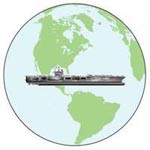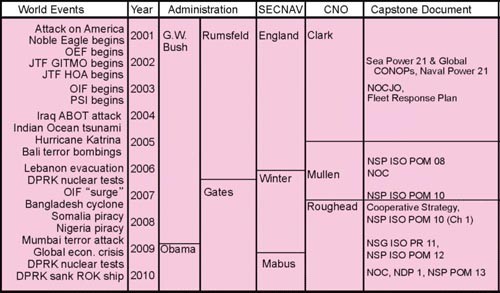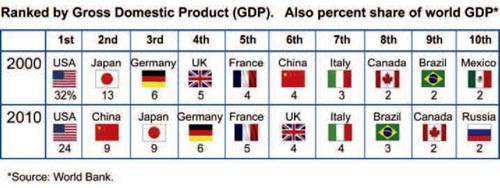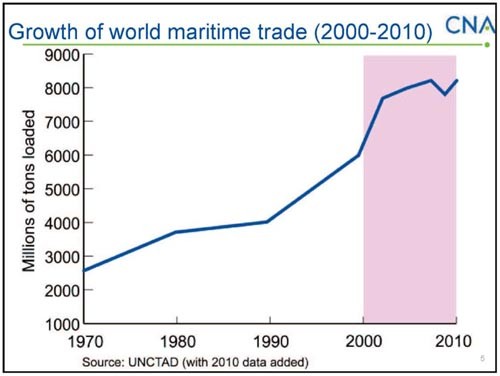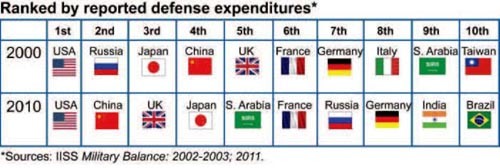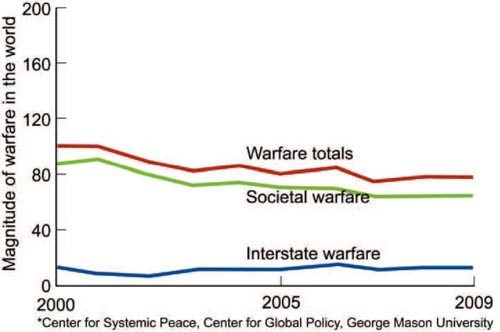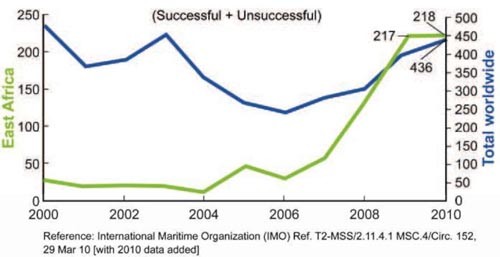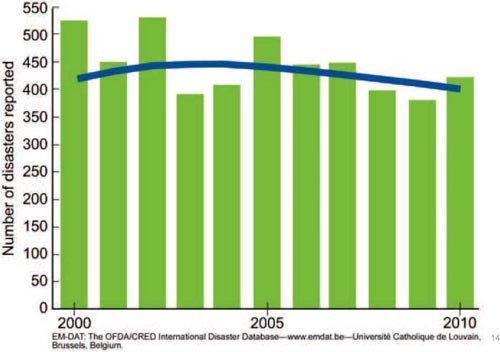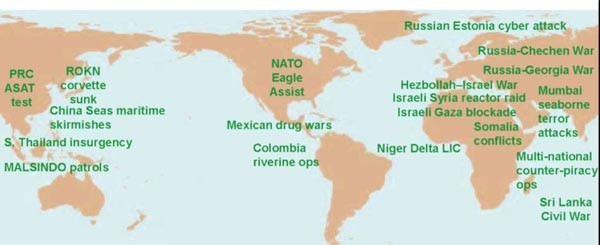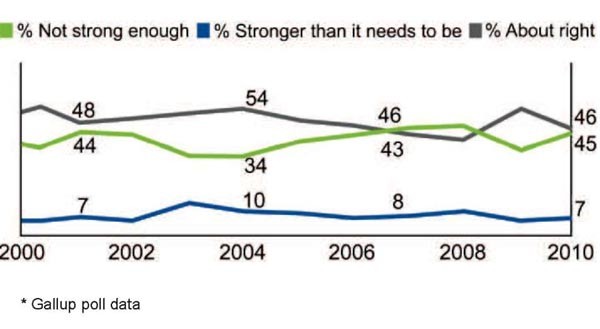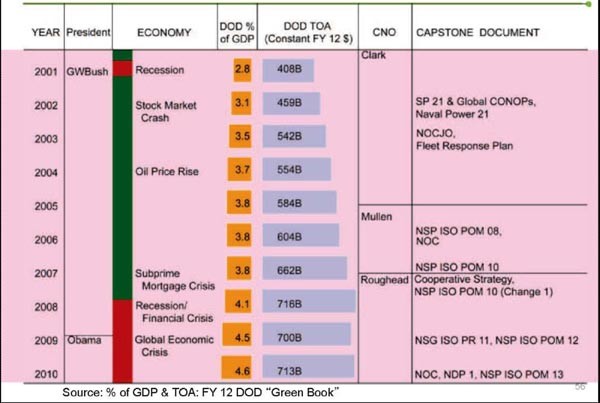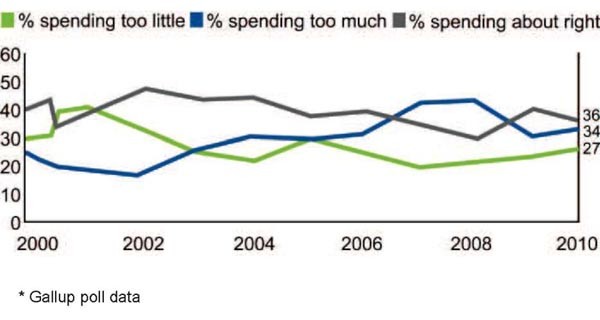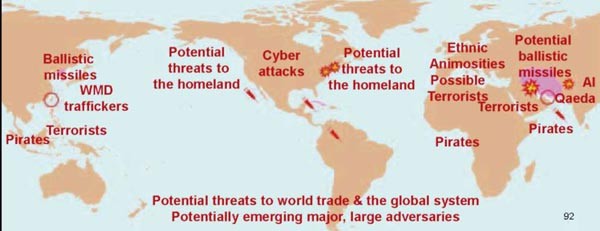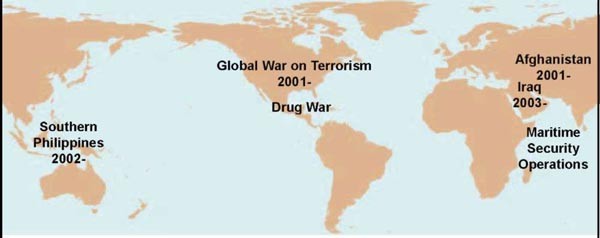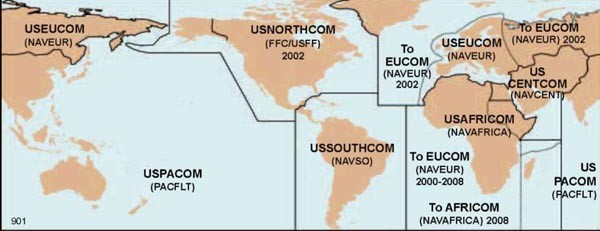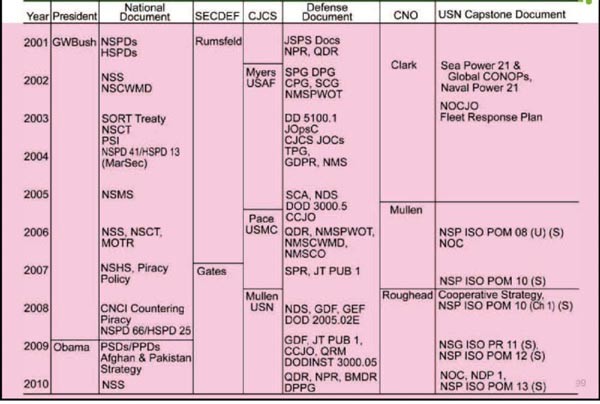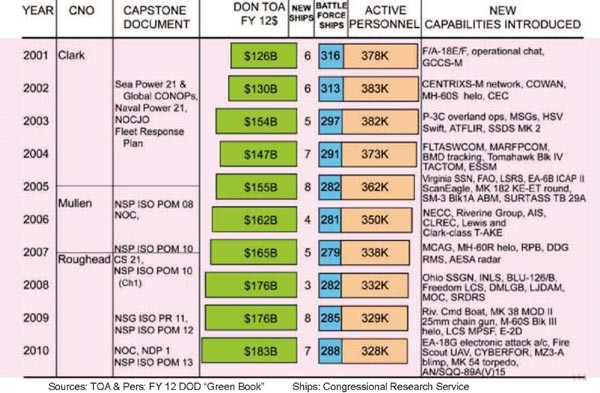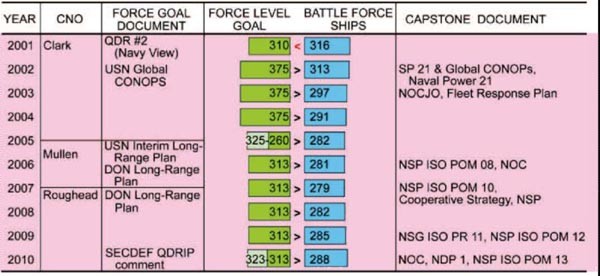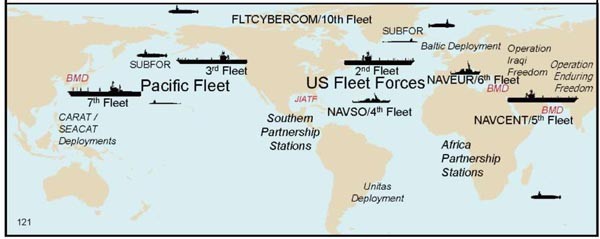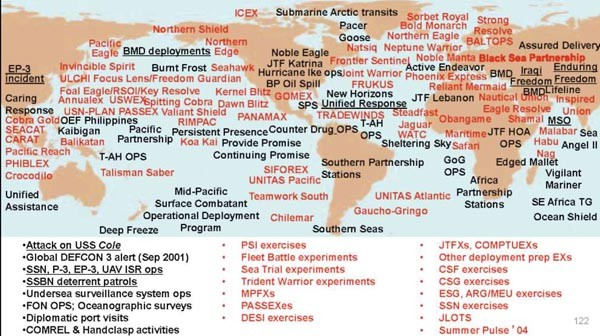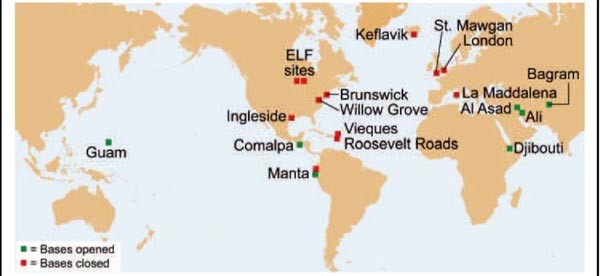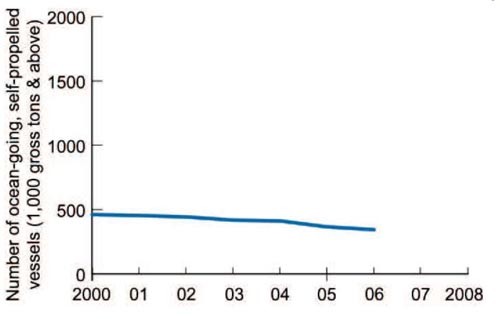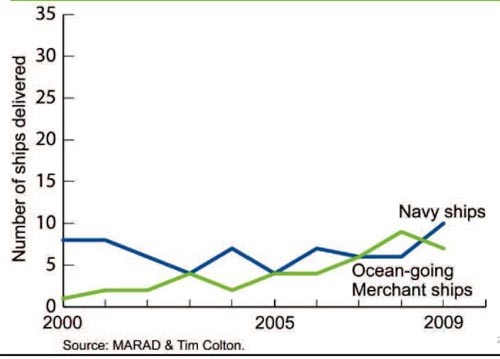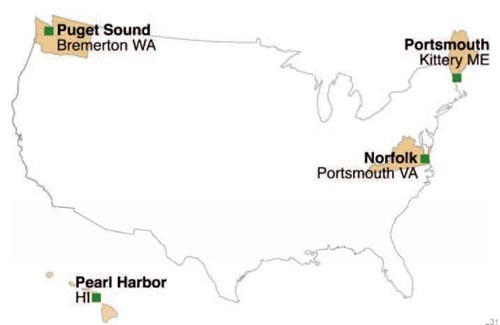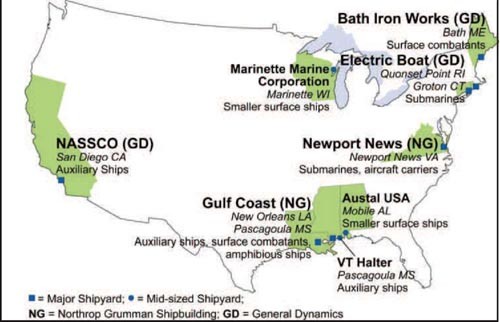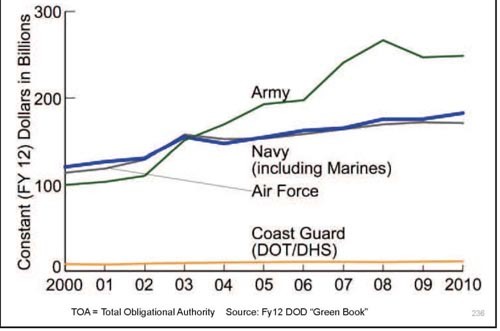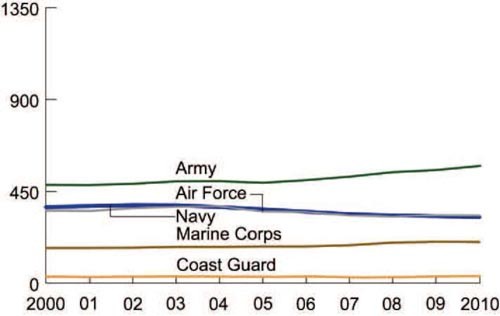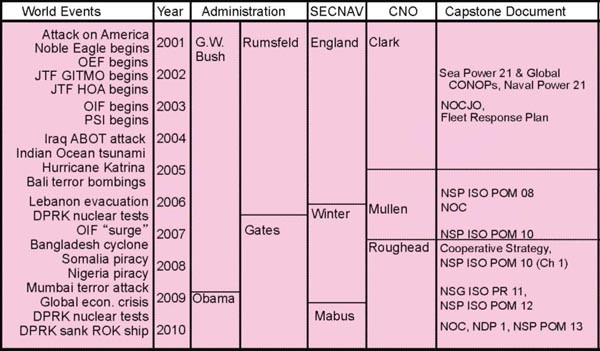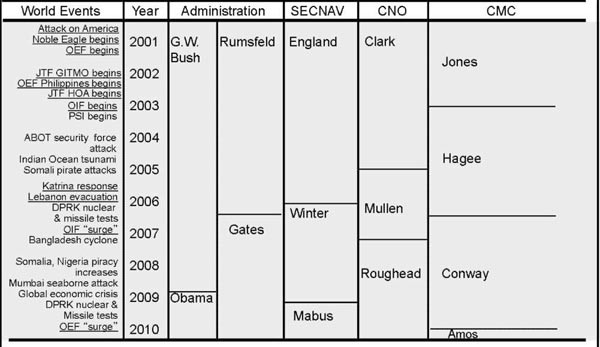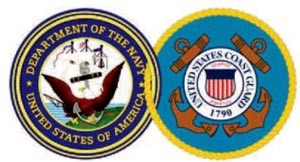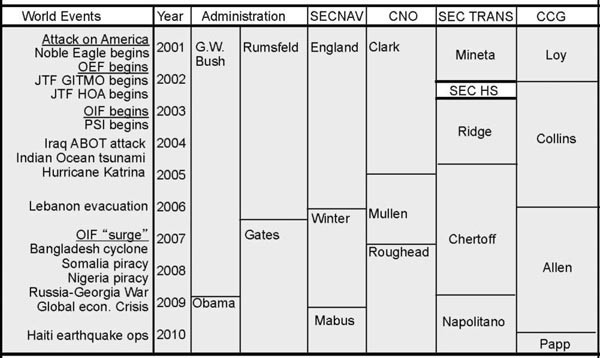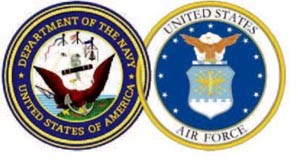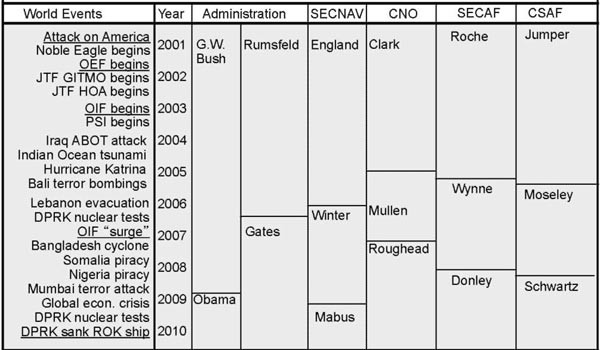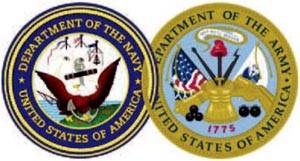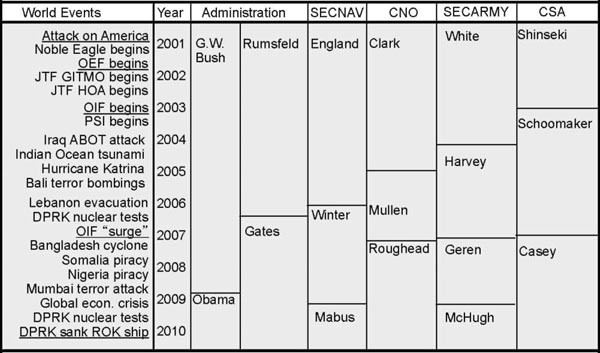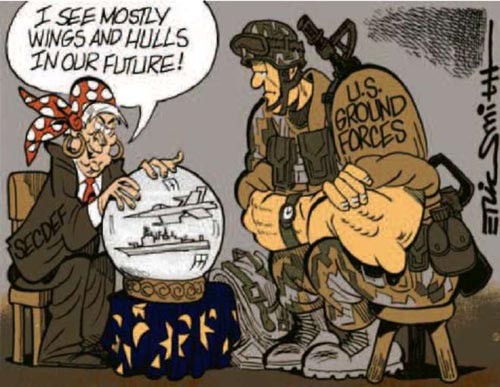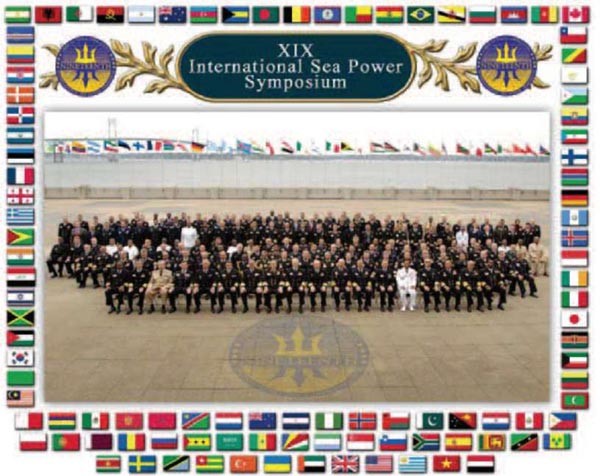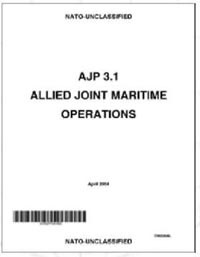
The Navy Department Library
The U.S. Navy in the World (2001-2010)
Context for U.S. Navy Capstone Strategies and Concepts
Peter M. Swartz with Karin Duggan
MISC D0026242.A2/Final December 2011
CNA
ANALYSIS & SOLUTIONS
CNA is a not-for-profit organization whose professional staff of over 700 provides in-depth analysis and results-oriented solutions to help government leaders choose the best courses of action. Founded in 1942, CNA operates the Institute for Public Research and the Center for Naval Analyses, the federally funded research and development center (FFRDC) of the U.S. Navy and Marine Corps.
CNA Strategic Studies (CSS), created in 2000, conducts high-quality research on and analysis of issues of strategic, regional, and policy importance. CSS' analyses are based on objective, rigorous examination and do not simply echo conventional wisdom. CSS provides analytic support to U.S. Government organizations and the governments of partner countries. CSS also maintains notable foundation-sponsored and self-initiated research programs. CSS includes a Strategic Initiatives Group, an International Affairs Group, and a Center for Stability and Development.
The Strategic Initiatives Group (SIG) looks at issues of U.S. national security, and military strategy, policy and operations, with a particular focus on maritime and naval aspects. SIG employs experts in historical analyses, futures planning, and long-term trend analysis based on scenario planning, to help key decision makers plan for the future. SIG specialties also include issues related to regional and global proliferation, deterrence theory, threat mitigation, and strategic planning for combating threats from weapons of mass destruction.
The Strategic Studies Division is led by Vice President and Director Dr. Eric V. Thompson, who is available at 703-824-2243 and on e-mail at thompsoe@cna.org. The executive assistant to the Vice President and Director is Ms. Rebecca Martin, at 703-824-2604.
The principal author of this study thanks especially Karin Duggan for graphic assistance; Loretta Ebner for administrative assistance; Gregory Kaminski, Laurie Ann Lakatosh, and Rhea Stone for library assistance; and Dana Smith and Anwar Fry for production assistance. A full listing of substantive contributors can be found in Peter M. Swartz and Karin Duggan, U.S. Navy Capstone Strategies and Concepts: Introduction and Background: Volume I, (D0026421.A1, December 2011). A full listing of all volumes in the CNA Navy Strategy series can be found on the inside back cover of this document.
Approved for distribution: December 2011
This document represents the best opinion of the author at the time of issue. It does not necessarily represent the opinion of the Department of the Navy.
Approved for public release. Distribution unlimited.
Copies of this document can be obtained through the Defense Technical Information Center at www.dtic.mil or contact CNA Document Control and Distribution Section at 703-824-2123.
Copyright 2012 CNA
This work was created in the performance of Federal Government Contract Number N00014-11-D-0323. Any copyright in this work is subject to the Government's Unlimited Rights license as defined in DFARS 252.227-7013 and/or DFARS 252.227-7014. The reproduction of this work for commercial purposes is strictly prohibited. Nongovernmental users may copy and distribute this document in any medium, either commercially or noncommercially, provided that this copyright notice is reproduced in all copies. Nongovernmental users may not use technical measures to obstruct or control the reading or further copying of the copies they make or distribute. Nongovernmental users may not accept compensation of any manner in exchange for copies. All other rights reserved.
Image - Signature of Dr. W. Eugene Cobble, Jr. Director, Strategic Initiatives Group
| Contents | |
| ♦ Global trends | 2 |
| ♦ The world | 8 |
| ♦ The nation | 25 |
| ♦ US national security policies | 29 |
| ♦ US combatant & component commands | 47 |
| ♦ US national security & defense directives | 50 |
| ♦ USN dollars, numbers, capabilities, goals | 57 |
| ♦ USN deployments, operations & exercises | 61 |
| ♦ State of the Navy | 62 |
| ♦ Navy strategy leadership | 80 |
| ♦ Naval policy & strategy literature | 82 |
| ♦ Public USN intelligence documents | 98 |
| ♦ US Navy basing | 98 |
| ♦ US military sealift | 105 |
| ♦ US-flag merchant marine | 111 |
| ♦ US shipbuilding industrial base | 114 |
| ♦ US military department & service comparisons | 118 |
| ♦ US Navy-US Marine Corps relations | 120 |
| ♦ US Navy-US Coast Guard relations | 136 |
| ♦ US Navy-US Air Force relations | 147 |
| ♦ US Navy-US Army relations | 167 |
| ♦ US Navy-foreign navy relations | 181 |
| ♦ The 2000s vs. the 1990s | 194 |
| ♦ Postscript (2010-2011) | 196 |
--1--
2000s: The world, the nation, & the Navy
2000s: Comparing national economic power
--2--
2000s: Comparing national defense spending
--3--
2000s: Growth of world maritime trade
♦ Unprecedented high growth rate in first half of decade
♦ Followed by high but somewhat slower growth
♦ Followed by 11 % decline, as part of global Great Recession (2009)
♦ Followed by fast recovery (11.4% growth) (2010)
2000s: Global Trends in Armed Conflict*
--4--
♦ Chart based on a rating scale developed at Center for Systemic Peace, Center for Global Policy, George Mason University
♦ Continued but modest decline in warfare in the world, since end of the Cold War
♦ By end 2009, global magnitude of warfare had decreased by over 60% from mid-1980s peak (lowest level since 1960)
♦ Societal warfare remained the predominant mode of warfare, but declining
♦ Continued low level of interstate warfare
♦ Dramatic rise in terrorism incident numbers, lethality
. Protracted societal conflicts (as of 2009)
| . Afghanistan (30 yrs) | . Nigeria (11 yrs) |
| . Colombia (33 yrs) | . Philippines (36 yrs) |
| . Congo (16 yrs) | . Somalia (20 yrs) |
| . India (56 yrs) | . Sri Lanka (just ended |
| . Iraq (28 yrs) | . Sudan (25 yrs) |
| . Israel (43 yrs) | . Turkey (24 yrs) |
| . Myanmar (60 yrs) | . Uganda (37 yrs) |
. Other major societal conflicts (as of 2009)
| . Mexico | . Yemen |
| . Chad | . Russia |
| . Central African Republic | . Pakistan |
| . Ethiopia | . Thailand |
. Conflicts of the 2000s that had ended by 2009
| . Haiti | . Burundi |
| . Georgia-Russia | . Uganda |
| . Lebanon | . Kenya |
| . Algeria | . Saudi Arabia |
| . Ivory Coast | . Sri Lanka |
| . Northern Nigeria | . Nepal |
| . Angola (Cabinda) | . Indonesia (Aceh) |
2000s: Piracy incidents reported
2000s: Natural disasters reported
--7--
2000s: The world (I)
♦ "Post-Cold War "and "post-9/11" era
♦ International system stabilizing again
♦ UN membership: 2000: 189 2010: 192
♦ Continued relatively high salience of maintenance & expansion of stable global security & economic system, in global affairs
♦ Continued historically low salience of interstate security competition in global affairs
♦ Continued decreasing magnitude, numbers of wars in world
♦ # of democracies continued to grow; ♦ of autocracies continued to fall
2000s: The world (II)
♦ Continued integration of former "2nd world" & "3rd world" polities & economies into globalized former "western" "free world" "1st world" system
♦ Increasing challenges to accepted 1st world norms by integrating powers, e.g.: China, Brazil
♦ Increasingly multi-power international system, but US still sole comprehensive superpower
♦ No longer a fully uni-polar world system (by 2008)
♦ Continued NGO at-sea anti-whaling, anti-sealing, anti-dumping ops
♦ Greenpeace, Sea Shepherd
--8--
2000s: The world (III)
♦ Continued desire by many other nations that US remain the primary world power
♦ No rival super-power or balancing coalition emerged
♦ But by end of decade, US primacy waning
♦ Decreasing US economic power relative to other states
♦ Increasing Chinese economic and military power & assertiveness; terrorist and other trans-national threats; continued hostility by Iran, North Korea
♦ One new nuclear state (DPRK); Iran nuclear weapons development suspected
♦ Continued global diffusion of low- and medium- tech military weapons & expertise
2000s: The world (IV)
♦ US still the sole global superpower
♦ Continued US economic primacy
♦ World's largest economy; Dollar as global reserve currency
♦ US investment banks dominated world finance
♦ World's leading manufacturing power
♦ World's leading agricultural exporter
♦ Continued US military primacy
♦ World's most powerful military; highest defense expenditures
♦ World leader in defense technology, education
♦ Primacy in the global commons (sea, air, space, cyberspace)
♦ Forward global conventional military posture
♦ Center of a global web of military alliances
♦ Robust nuclear deterrent; World's leading arms exporter
♦ Successes in 3 wars: Afghanistan, Iraq, Al Qaeda
--9--
2000s: The world (V)
♦ Continued increasing globalization of world economy & society
♦ Steady growth in world seaborne trade (dip in 2009)
♦ Steady growth in fiber optic submarine cable net
♦ Far East accounted for >90% of world shipbuilding by 2010
♦ Global economic boom, then financial crisis & recession (after Sep 2008)
♦ Temporary collapse of global trade & output
♦ Uneven global effects: China & others continued growth surge, spurred world trade
♦ Soaring oil, food prices for most of decade
♦ Oil prices soared, peaked, plummeted (2008)
♦ Food shortages, price rises fueled unrest in Africa, Asia, Caribbean (2007-8; 2010)
2000s: The world (VI)
♦ G-7 economic leadership forum of developed nations " gradually eclipsed by more global & diverse G-20
♦ G-20 elevated to heads of government level (2008)
♦ Great economic, technological growth in big "BRIC" states (Brazil/Russia/India/China)
♦ China entered WTO (2001)
♦ Greatly increased role of trade, investment overseas, marine industries as engines of China growth
♦ China became world's 2nd largest economy, passing Japan (2010)
♦ Brazil became world's 8th largest economy (passing Spain & Canada)
♦ Concomitant growth in military & naval capabilities, esp. India & China
♦ Alienation, ferment, crises in parts of non-Western world ("the Gap")
♦ Persistent problems for failed and failing states
--10--
2000s: The world (VII)
♦ Global competition for resources
♦ Noticeable effects of global warming
♦ Increased access to the Arctic Ocean
♦ World sea level rise
♦ Changing relationships in the Arctic
♦ Northwest & Northeast Passages opening up, intensified international competition for Arctic Ocean resources
♦ Russian submersible planted encased Russian flag on seabed at North Pole (2007)
♦ First non-Russian ships transited Northern Sea Route (2009)
♦ Russia & Norway settled disagreements over Barents Sea boundary (2010)
2000s: The world (VIII)
♦ World opinion toward US trended negative
♦ Initial world support, sympathy for US after 9/11 (2001)
♦ Strong rise in anti-US, anti-Bush sentiments worldwide after Iraq invasion (2003), world financial crisis (2008)
♦ Eased somewhat following Obama election (Nov 2008)
♦ Continued growth in world missile capabilities
♦ Especially ballistic, cruise, surface-to-air missiles
♦ Especially China, North Korea, Iran, India, Pakistan
♦ Increase in cyber security events
♦ Continued "rogue" activity: N. Korea, Iran, Syria, later Venezuela (Chavez president 1998)
♦ UN Convention on Law of the Sea (UNCLOS) in force; US still not a signatory (since 1994)
--11--
2000s: The world (IX)
♦ Continued increase in importance of violent transnational non-governmental actors
♦ Al Qaeda & other radical Islamic extremist terrorist threats salient
♦ Sporadic maritime terrorism incidents
♦ Continued increase in transnational crime activity, including drug trafficking
♦ Increased use of submersibles & semi-submersibles
♦ Worldwide piracy attack reports remain high
♦ Decrease in S. China Sea & Strait of Malacca
♦ Increased Singapore-Malaysia-Indonesia anti-pirate ops
♦ Attacks off Somalia in Gulf of Aden soared (from 2008)
♦ Triggered major world anti-piracy reaction at sea
♦ But US & others refused to intervene ashore, allowing piracy to flourish
♦ Somali pirates adapted to anti-piracy operations, changed tactics & operational areas
♦ Little evidence yet of pirate-terrorist linkages
2000s: The world (X)
♦ Terrorist incidents, lethality soared (from 2003) (I)
♦ Examples (many on, from, or to the sea):
♦ Tamil "Sea Tiger" terror assaults, vessel hijackings (1990s-2000s)
♦ Al Qaeda 9/11 attacks on WTC, Pentagon, Pennsylvania (2001)
♦ Al Qaeda member Richard Reid attempted airline flight shoe bombing (2001)
♦ LTTE suicide attack on oil tanker off north Sri Lanka (2001)
♦ Al Qaeda small craft attacked French tanker Limburg off Yemen (2002)
♦ Al Qaeda Bali, Indonesia discotheque car bomb attack (2002)
♦ Chechen Moscow theater attack (2002)
♦ Al Qaeda Casablanca, Morocco suicide bombings (2003)
♦ Riyadh, Saudi Arabia westerner housing bombing (2003)
--12--
2000s: The world (XI)
♦ Terrorist incidents, lethality soared (from 2003) (II)
♦ Examples (many on, from, or to the sea):
♦ Jeddah, Saudi Arabia US consulate attack (2004)
♦ 10 Al Qaeda Madrid train bombings (2004)
♦ Chechen Russia school attack (2004)
♦ Failed small craft suicide attack on Iraqi oil terminal platforms. US Sailors, Coastguardsman killed. (2004)
♦ Abu Sayef bombing of Super Ferry 14 in Philippines (2004)
♦ Al Qaeda London subway & bus bombings (2005)
♦ Al Qaeda terrorists fired missiles at USN amphibious ships visiting Jordan, missed (2005)
♦ Muslim terrorist Mumbai, India train bombings (2006)
♦ Foiled Al Qaeda plot to detonate liquid explosives on at least 10 trans-Atlantic airliners (2006)
♦ Greek terrorists fired rocket at Athens, Greece US Embassy (2007)
2000s: The world (XII)
♦ Terrorist incidents, lethality soared (from 2003) (III)
♦ Examples (many on, from, or to the sea):
♦ Vietnamese terrorists raided submarine cable systems (2007)
♦ MEND naval forces attacked Nigerian offshore oil platform (2008)
♦ Mumbai, India: Muslim terrorist sea-launched attack on hotel, etc. (2008)
♦ Al Qaeda attempted bombing of airline flight to Detroit (2009)
♦ Moscow subway bombing (2010)
♦ Israelis killed Palestinian commandos in the sea off Gaza (2010)
♦ Attack on Japanese tanker in Strait of Hormuz. Al Qaeda-linked group claimed responsibility (Jul 2010)
♦ Philippine terrorists attacked international submarine cable (2010)
♦ Al Qaeda package bombs found on US-bound aircraft in London, Dubai (2010)
♦ Japanese tanker M Star bombed in Strait of Hormuz (2010)
--13--
2000s: The world (XIII)
♦ International efforts to improve security at sea (I)
♦ IMO Code of Practice for the Investigation of the Crimes of Piracy and Armed Robbery at Sea (2001)
♦ 1974 International Convention for the Safety of Life at Sea (SOLAS) strengthened (2002)
♦ International Ship and Port Facility Security Code (ISPS code) adopted (2002)
♦ Container Security Initiative (CSI) (2002)
♦ Proliferation Security Initiative (PSI) (2003)
♦ Caribbean Regional Maritime Agreement (CRA) (2003)
2000s: The world (XIV)
♦ International efforts to improve security at sea (II)
♦ 2005 Protocol to the 1988 Convention on the Suppression of unlawful Acts Against the Safety of Maritime Navigation (SUA) signed (2005)
♦ Mandated new agreed international ship-boarding regime
♦ Entered into force (Jul 2010)
♦ Regional Cooperation Agreement on Combating Piracy and Armed Robbery against Ships in Asia (ReCAAP) (2006)
♦ Cooperative Mechanism (for Straits of Malacca) (2007)
♦ UNSC Resolutions 1816, 1838, 1846, 1851 (vs. piracy off Somalia) (2008)
♦ Kenya agreement to try Somali pirates captured by US naval forces (Jan 2009)
--14--
2000s: The world (XV)
♦ Continued balance of power in Western Eurasia (I)
♦ Authoritarian Russian government under Putin & Medvedev presidential regimes (since 1999)
♦ Russian energy-based economic resurgence Russian arms exports second only to US
♦ To China, India, Algeria, Venezuela, Iran, Vietnam, Malaysia, Yemen, some others
♦ Russia-US/NATO relationship strained; less collaborative than 1990s
♦ Russian hostility to US Bush administration Poland/Czech Republic ABM plans
♦ Obama Administration "reset" & changed ABM plans only improved relationship somewhat
♦ Continued Russian unease at US ABM plans
♦ Russian bases closed at Cam Ranh Bay, Vietnam & Lourdes, Cuba (2002)
2000s: The world (XVI)
♦ Continued balance of power in Western Eurasia (II)
♦ Modest Russian military resurgence
♦ Increased Russian forward air, naval ops late in decade
♦ Return to intermittent global naval presence: Atlantic, Pacific, Caribbean, Mediterranean Indian Ocean deployments (from 2007)
♦ Increased Russian rhetoric on need for naval power
♦ Continued decline of Russian Navy capabilities
♦ Continued decline of Russian strategic nuclear forces
♦ New Borey-class SSBN on sea trials
♦ Continued testing failures of new Bulava R-30 SLBM
♦ Russian renovation of Tartus, Syria forward naval base (from 2009)
♦ Russian pressure on other former USSR republics
♦ Hostility to Georgia, Ukraine NATO membership
♦ Cyber attacks on Estonia (2007) & Georgia (2008)
♦ Invasion of Georgia (2008)
♦ Included Russian Navy amphibious landings, support of ground troops, blockade, at-sea combat
--15--
2000s: The world (XVII)
♦ Europe generally stable
♦ But final break-up of Yugoslavia
♦ Montenegrin (2006) & Kosavar (2008) independence
♦ NATO oversight of Kosovo (1999-2008)
♦ National capabilities developed vs. terrorists
♦ UK Strategic & Security Review (SDSR) mandated severe cuts to Royal Navy (2010)
♦ France deployed 1st CVN (2001); 4 new SSBNs (by 2010); Rafale MK3 naval aircraft
♦ UK-FR agreement to create joint military forces, including coordinated aircraft carrier policies (Nov 2010)
♦ Some estrangement from US over Iraq war
♦ NATO ally Turkey refused US base & overflight access during OIF (2003)
♦ Some European preference for EU vice NATO initiatives
2000s: The world (XVIII)
♦ US's NATO allies unable or unwilling to take on many defense tasks
♦ Decline in % of GDP devoted to defense in all NATO countries except US
♦ NATO expanding, reorganizing, taking on some new tasks
♦ NATO expansion on Baltic, Black Sea littorals
♦ Poland (1999), Baltics, Romania Bulgaria members (2004)
♦ NATO invoked Article 5 for 1st time, ISO US following al Qaeda attack (2001)
♦ NATO trying to implement NATO Response Force (NRF) concept
♦ France still outside NATO command structure (until 2009)
--16--
2000s: The world (XIX)
♦ Continued rough balance of power in Asia-Pacific
♦ Increased PRC global power, influence, military modernization drove change in East Asia and beyond
♦ PRC joined World Trade Organization (WTO) (2001)
♦ PRC economy world's 2nd largest (by 2010); grew 10% per year
♦ Meteoric rise in PRC shipbuilding throughout the decade
♦ PRC world's #1 shipbuilder (by 2010); 41% annual growth rate
♦ PRC world's #2 energy consumer (2003). Oil imports leapt
♦ PRC became 3rd nation to put humans into earth orbit (2003)
♦ US-PRC economic ties continued to expand
♦ Increased PRC participation in UN peacekeeping and humanitarian assistance operations worldwide
♦ PRC-funded construction of Pakistani Gwadar port, on Indian Ocean (2002-8)
♦ US & allies Japan & South Korea continued as robust military powers in Asia-Pacific
♦ Increasing Indian, Vietnamese, Singaporean military power
♦ Russian military power continued to stagnate
2000s: The world (XX)
♦ Frictions in the East Asian littoral seas
♦ PRC operational challenges to US right to engage in military activities in PRC EEZ
♦ EP-3 South China Sea intercept incident: PRC denied USN right of overflight in PRC EEZ by reconnaissance aircraft (2001)
♦ PLAN harassment of oceanographic survey ships USNS Bowditch, Victorious, Impeccable: PRC denied right of USN oceanographic research in PRC EEZ (2002, 2009)
♦ Other PLAN interference with USN ship & aircraft ops
♦ PRC-Japan tensions
♦ Tense cross-strait relations eased by Taiwan election (2008)
♦ But continued PLA build-up of land-based missile forces
♦ Expansive PRC claims to South China Sea islands and ocean areas
♦ 10 Asian nations signed Declaration on the Conduct of Parties in the South China Sea (Nov 2002), reducing tensions over rival claims
♦ PRC-VN clashes at sea (2005, etc.) 34
--17--
2000s: The world (XXI)
♦ Continued development of PLAN
♦ PLA & PLAN posturing for conventional war against Taiwan and, if necessary, sea denial ops vs. US Navy
♦ Some shifting from coastal & offshore to "far seas" strategy & capabilities
♦ PLAN growth, modernization, incl/ ASBM R & D, new Jin-class SSBN, Russian submarine transfers
♦ Sharp decline in PLAN fast attack/patrol craft #s
♦ PLAN commander became member of PRC Central Military Commission (CMC) (2004)
♦ Periodic PLAN SAREXes with foreign navies (w/ USN Sep 2006)
♦ 1st Yaogon ocean-surveillance satellites launched (2006)
♦ Increased periodic PLAN cruises, port calls beyond adjacent waters, esp. to Arabian Sea vs. pirates (6 Gulf of Aden deployments (Dec 2008-2010))
♦ Slow refit of former-Soviet aircraft carrier Varyag throughout the decade (for 2011 initial deployment)
♦ Periodic PRC cancellation of US military contacts, including mutual ship & CNO visits& MMCA meetings
♦ Tied to US announcements on arms transfers to Taiwan 35
2000s: The world (XXII)
♦ Non-military US-PRC issues
♦ Balance of trade
♦ Specific trade disputes: Tires, car parts, chicken, etc.
♦ Dollar-RMB exchange rate
♦ US leadership meetings with Tibetan Dalai Lama
♦ US criticism of PRC human rights policies
--18--
2000s: The world (XXIII)
♦ Taiwan government policy changes
♦ Pro-independence party in power (2000-2008), increasing cross-strait tensions
♦ Decline in Taiwan defense spending
♦ Less stridently anti-PRC KMT regime elected; improved relations (2008)
♦ Opening of PRC-Taiwan air, sea, mail links (2008)
♦ PRC-Taiwan Economic Cooperation Framework Agreement (ECFA) (Jun 2010)
♦ Increasingly close Japan-US military, economic, political cooperation
♦ Controversies in Japan over continued USMC presence in Okinawa
♦ US & Vietnam drew closer: Diplomatically, economically, militarily 37
2000s: The world (XXIV)
♦ "Shanghai Five" became Shanghai Cooperation Organization (SCO) (2001)
♦ PRC, Russia, Kazakhstan, Kirghizstan, Tajikistan & Uzbekistan
♦ PRC-Russia combined "Peace Mission" exercise in Shandong (2005)
♦ Incl/ Russian Pacific Fleet, PLAN squadrons. Amphibious Exercise
♦ Collective Security Treaty Organization (CSTO) formed (2002)
♦ Russia, Armenia, Belarus, Kazakhstan, Kirghizstan, Tajikistan (later Uzbekistan)
♦ Close PRC-Russia military relations continued
♦ 8 more Kilo SSs, 2 more Sovremenny DDGs delivered
--19--
2000s: The world (XXV)
. US-PRC economic interdependence (by 2008)
| . China | . The United States: |
| . was 2nd largest US trading partner | . was China's largest single trading partner |
| . was largest source of imports to US | . was China's 4th largest source of imports |
| . was 3rd largest US export market | . was China's largest export market |
| . became largest holder of US public debt |
2000s: The world (XXVI)
♦ Continued shift in balance of conventional power on Korean peninsula in favor of ROK
♦ Continued DPRK hostility to US, ROK & Japan
♦ DPRK development of nuclear weapons, missiles
♦ Continued ROK rise as economic, military, naval power
♦ 6-party talks to limit DPRK nuclear capabilities (2003-9)
♦ ROK gov't DPRK "sunshine policy" (1998-2008)
♦ Distanced ROK from some US defense policies
♦ Rejected at ROK polls; new gov't cooler (2008)
♦ UN sanctions on DPRK allowing inspections at sea of ships suspected of carrying banned weapons (2010)
♦ Inter-Korean naval incidents throughout decade
♦ Yellow Sea naval battles (2002, 2004)
♦ DPRK renounced 1992 Inter-Korean Basic Agreement (Jan 2009)
♦ Incl/ renouncing respect for Yellow Sea Northern Limit Line
♦ ROKN fired on DPRKN warship crossing Northern Limit Line (2009)
♦ DPRKN submarine torpedo sank ROKN corvette (Mar 2010)
--20--
2000s: The world (XXVII)
♦ India-US political, economic, military relations far closer than ever before
♦ Nuclear cooperation announced (2005) Bilateral nuclear "123 Agreement" signed (2008)
♦ Keel laid for 1st indigenously-built Indian Navy aircraft carrier (Feb 2009)
♦ India launched 1st SSBN (Jul 2009)
♦ Pakistan increasingly unstable politically
♦ Musharaf military regime (1999-2008) closely aligned militarily with US since 9/11 attacks
♦ New civilian Zadari gov't continued policies (2008)
♦ Hostile & active Taliban & Al Qaeda presence in NW
♦ Sri Lanka government victory vs. Tamil separatists (2009)
♦ Included blockade, major sea combat on both sides
2000s: The world (XXVIII)
♦ Middle East generally unstable
♦ US-imposed regime change, war, political fragmentation, insurgencies, democratization, reconstruction in Afghanistan, Iraq
♦ Continued Iranian regime regional hegemonic ambitions, hostility to US & US allies & partners
♦ Major Iranian military R & D & modernization
♦ Iranian naval division of labor (2007)
♦ Iranian Revolutionary Guard Corps Navy (IRGCN) in Persian Gulf; Islamic Republic of Iran Navy (IRIN) in Caspian, Arabian Seas, etc.
♦ Buildup of IRGCN small naval combatant missile forces
♦ UN sanctions on Iran allowing inspections at sea of ships suspected of carrying banned weapons (2010)
♦ Sponsorship of terrorism (e.g.: Hezbollah in Lebanon)
♦ Syria an Iranian ally
--21--
2000s: The world (XXIX)
♦ Second Intifada broke out in Palestine (2000)
♦ Breakdown of Oslo Accord regime
♦ Israeli air raid on Syrian reactor (2007)
♦ In response to cross-border attacks, Israeli attacked Hezbollah in Lebanon (2006), Hamas in Gaza (2009)
♦ Hezbollah land-based missiles hit Israeli ship
♦ Israeli naval blockade of Gaza (from Jan 2009)
♦ Israeli raid on blockade-breaking flotilla (May 2010)
♦ Libyan policy volte-face & rapprochement with US & the West
♦ Successful Saudi, Indonesian internal security measures to thwart terrorist threats
♦ Mubarak continued as pro-US President of Egypt
2000s: The world (XXX)
♦ Continued instability in Africa
♦ Somalia in turmoil
♦ Continued civil war, secessionist movements, militant Islamist insurgency, humanitarian disasters
♦ No effective national government
♦ Islamist fighters in control in S. Somalia & Mogadishu, before & after Ethiopian intervention (2006 & 2009)
♦ US backed Ethiopian intervention ISO nominal national gov't (2007-8)
♦ Sharp rise in at-sea pirate attacks, esp. Gulf of Aden (from 2008)
♦ Anti-US Gen. Omar al-Bashir still in power in Sudan (from 1989)
♦ Rebellion, humanitarian crises in Sudanese Darfur
♦ Increasing importance of Nigeria as oil exporter
♦ Criminal activity & insurgency in coastal regions
--22--
2000s: The world (XXXI)
♦ Improving, cooperative US-Philippines relations
♦ Continued Muslim separatist & Abu Sayyaf terrorist insurgencies in Mindanao, Southern Philippines
2000s: The world (XXXII)
♦ Massive US economic, military aid helped reduce power of drug cartels, insurgents in Colombia
♦ Cuban Communist anti-US leadership transition uncertainties
♦ Increasing Venezuelan hostility to US
♦ Anti-American & authoritarian Hugo Chavez president (since 1999)
♦ Venezuelan oil aid helped keep Cuba solvent
♦ More LATAM countries elected governments hostile to US policies
♦ Bolivia (2006), Nicaragua (2007), Ecuador (2007)
--23--
2000s: The world (XXXIII)
♦ Surge in Brazil world political, economic status
♦ Mexico increasingly wracked by drug cartel crime & violence
♦ Continued Haiti political turmoil, natural disasters
♦ Panama began widening the Canal (from Jul 2007)
♦ Expected to bring bigger ships to the US East Coast (c 2014)
2000s: Significant non-USN operations
--24--
2000s: The nation (I)
♦ 2 G.W. Bush administrations (R) (2001-2009)
♦ Barack Obama (D) administration (from Jan 2009)
♦ Republican control of both houses of Congress (2003-7)
♦ Lost control of Senate (Jan 2007)
♦ Democratic control of both houses of Congress (2007-2011)
♦ Lost control of House (Jan 2011)
♦ US public fear of terrorism
♦ Increasing US public disenchantment with foreign intervention
♦ Los Angeles/Long Beach dockworker strike showed US vulnerability to port attacks (2002)
2000s: The nation (II)
♦ US remained world's largest economy
♦US GDP up 21% across the decade, despite recessions
♦ But US GDP relative to G-20, China GDP declined
♦ "Lost decade:" Economic stagnation
♦ Housing & stock market bubbles (& bursting)
♦ Mild, brief recession (2001) (start of Bush administration), then modest growth
♦ Financial & economic collapse & deep recession (Dec 2007-Jun 2009) (Bush & Obama administrations), then very slow recovery
♦ Return to high U.S. government deficit spending
♦ Exacerbated by Bush Administration tax cuts, Medicare expansion, war spending
♦ 2009-10 Obama administration deficits highest since World War II
♦ Rising, falling, then soaring US unemployment rate
♦ Low US inflation rate (2001-8); very low (2009-10)
--25--
2000s: The nation (III)
♦ Oil prices rose dramatically, peaked (2008), then fell
♦ US becoming less dependent on foreign energy sources
♦ US imports-export trade fluctuated, but generally soared
♦ Declined (2000-2); soared (2003-8); plummeted (2009); recovered (2010)
♦ Value of foreign trade as % of US GDP continued to rise (through 2007), from 18.7% to 22.7%
♦ Trade gap between imports & exports widened
♦ Unprecedented immediate aggressive large-scale US gov't policy response to economic crisis (2008-9)
♦ Continued consolidation of US defense industry
♦ 5 "primes:" Lockheed Martin, General Dynamics, Raytheon, Northrop-Grumman. Boeing
2000s: The nation (IV)
♦ Congress passed American Service-Members Protection Act (2002)
♦ Suspended US military assistance to countries that might prosecute US citizens in International Criminal Court (ICC)
♦ UN Convention on Law of the Sea (UNCLOS)
♦ US signed (1994)
♦ Still not ratified by Senate as of 2010, despite Senate Foreign Relations Committee endorsement (2007)
--26--
2000s: The nation (V)
♦ Major disasters hit US Gulf Coast
♦ Hurricane Katrina (Aug 2005)
♦ Deepwater Horizon Oil Spill (2010)
2000s: The nation (VI)
♦ Press reporting on military affairs dominated by ground wars in Iraq and Afghanistan
♦ Gallup polls showed:
♦ Military increasingly the most highly-regarded US institution by US public
♦ Much higher public regard for other DoD armed services than for USN
--27--
2000s: U.S. popular views on U.S. defense strength*
2000s: US economy & defense spending
--28--
2000s: U.S. popular views on U.S. defense spending*
2000s: US national security policies (I)
♦ Continued increased saliency in US grand strategy of maintaining and expanding the global economic and social system, to America's benefit, & spreading American values
♦ Lower saliency of international security concerns than in past decades
♦ No single dominant threat to US national security
♦ Continuation of multiple, disparate threats, including terrorist threats to US homeland
♦ Continued activist forward & homeland national security strategy & OPTEMPO
--29--
2000s: US national security policies (II)
♦ Grand strategy elements:
♦ Bush Administration (post-9-11): Regime change, democratization, preemption
♦ Maintain US world military primacy, in the face of increasing challenges
♦ World's most powerful military
♦ World's highest defense expenditures
♦ World leader in defense technology, education
♦ Especially precision guided munitions (PGMs) & Unmanned Aerial Vehicles (UAVs)
♦ Primacy in the global commons (sea, air, space, cyberspace)
♦ Forward global conventional military posture
♦ Europe, Middle East, East Asia hubs
♦ Center of a global web of military alliances
♦ Robust nuclear deterrent
♦ World's leading arms exporter 59
2000s: US national security policies (III)
♦ Annual defense budget increases & military buildup throughout the decade
♦ Large & increasing supplemental/ Overseas Contingency Operations (OCO) funding in addition to increasing base budgets (since Sep 2001)
♦ Dramatic increase in US defense procurement funding
♦ US military spending relative to China, Russia, Europe also increased across the decade
♦ Rising % of US GDP devoted to defense
♦ "1/3-1/3-1/3 rule broken
♦ Continued steady equivalent budget shares among the services until 2003
♦ Drastic relative increase in Department of the Army budget % for remainder of the decade
♦ Increased focus on Army & Marines due to two largely ground wars
--30--
2000s: US national security policies (IV)
♦ Shift of focus after 9/11/2001 from defense transformation & need for strategic speed to War on Terror, regime change,& prosecution of wars in Iraq, Afghanistan
♦ Global US manhunt for Al Qaeda leadership, esp. Osama Bin Laden
♦ Deterring China (over Taiwan, later South China Sea), Iran, North Korea
♦ Lessened reliance on international institutions, organizations, treaties (through 2008)
♦ But many continued formal treaty & informal obligations
♦ Rapprochement with Libya (from 2006)
♦ US-Libya MOU on defense cooperation (Jan 2009)
2000s: US national security policies (V)
♦ Increased reliance on voluntary, non-binding international partnerships
♦ Closer defense relations with Japan
♦ Increasingly close military relations with Pakistan
♦ US exercises w/ Philippines resumed (from 2000)
♦ US-India military rapprochement
♦ President Bush lifted economic sanctions imposed following Indian nuclear tests (2001)
♦ Increasingly close military ties
♦ Agreements, exercises, visits, arms sales
♦ 10-year "New Framework for the U.S.-India Defense Relationship" signed (Jun 2005)
♦ Continued US interest in security of both Israel & Gulf oil states
--31--
2000s: US national security policies (VI)
♦ Military relationships with PRC
♦ US measuring, pacing PRC military buildup
♦ Relations - never warm - fluctuated through decade (as in 1990s)
♦ FY 2000 Authorization Act limited US-PRC interactions
♦ Lows:
♦ USN EP-3 collision with PLAN interceptor (2001)
♦ PLAN submarine penetrated Kitty Hawk screen (2006)
♦ PRC canxed USN PVSTs (Nov 2007)
♦ PRC suspended USN PVSTs, other US military ties (Oct 2008)
♦ PLAN harassed USN ships near China (2009)
♦ PRC suspended US-PRC military ties (2010)
♦ US military technology transfer programs cancelled
♦ Military-to-military engagement activities cut back
♦ US-PRC military telephone hotline in use (2008)
2000s: US national security policies (VII)
♦ US Coast Guard relationships w China Coast Guard (CCG) flourished
♦ Routine USCG port visits to PRC (from May 2006)
♦ CCG students at US Coast Guard Academy & other schools
♦ Coordinated CCG-USCG North Pacific fisheries enforcement patrols & operations
♦ Included Chinese shipriders on USCG cutters
♦ Port security best practices exchanges
♦ CCG membership in North Pacific Coast Guard Forum (NPCGF) (from 2000)
♦ w/ Canada, Japan, South Korea, Russia, US
--32--
2000s: US national security policies (VIII)
♦ Continued US arms sales to Taiwan
♦ Pres. Bush authorized sales (2001)
♦ But Taiwan parliament internal political stalemates prevented purchases
♦ Pres. Obama re-authorized sales (Jan 2010)
♦ Both incurred PRC displeasure & reprisals
♦ Continued close US defense relationships, commitments to Japan & South Korea
♦ Relocation of some USMC forces from Okinawa
♦ Looser defense ties with ROK during much of decade
♦ DPRK sinking of ROK torpedo boat, attack on ROK island brought US-ROK allies closer together (2010)
♦ US to postpone turnover of command structure to ROK to 2015
2000s: US national security policies (IX)
♦ US military buildup on Guam
♦ New USAF Air Expeditionary Wing activated at Anderson AFB (2003)
♦ Rotational deployment of USAF bomber, fighter, unmanned ISR aircraft
♦ USN SSNs homeported in Guam (by 2007)
♦ Plans to relocate Marines from Okinawa to Guam
♦ Plans to build transient berth for visiting USN CVNs
♦ Biennial USPACOM Valiant Shield exercises off Guam (since 2006)
♦ 3 CVNs participated in 2006
♦ 3 USN SSGNs supported out of Guam (2010)
--33--
2000s: US national security policies (X)
♦ Initial GW Bush administration policies
♦ Jan-Sep 2001
♦ Nationalist & unilateralist
♦ Policies to build NMD system, abrogate ABM Treaty
♦ Rejection of Kyoto Global Warming Treaty, Comprehensive Test Ban Treaty (CTBT), International Criminal Court
♦ Denigration of US military "nation-building"
♦ Anti-terrorism not salient
♦ Early post-9/11 GWOT policies
♦ Continued nationalism & unilateralism
♦ Preemption, prevention & "coalitions of the willing"
2000s: US national security policies (XI)
♦ Initial DOD push for heightened "transformation"
♦ Goal: Smaller, lighter, nimbler, smarter, more precise forces
♦ Concepts: Shock & awe, effects-based ops
♦ SECDEF Rumsfeld signature issue area (2001-6)
♦ Equated transformation with Revolution in Military affairs. Willing to accept risks
♦ VADM (Ret) Cebrowski headed new OSD Office of Force Transformation (OFT) (2001-5)
--34--
2000s: US national security policies (XII)
♦ DOD return to more global operations & planning, at beginning & end of decade
♦ Introduction of generic capabilities-based vice threat-based planning
♦ New capabilities-based approach to identifying & developing military requirements
♦ Joint Capabilities Integration and Development System (JCIDS) process introduced (2003)
♦ Flexible DOD force sizing across ever-changing spectrum of military operations
♦ But 2 Major Theater Wars (MTWs) - now Major Combat Operations (MCOs) - still the main DOD force sizing construct
2000s: US national security policies (XIII)
♦ Post 9/11:
♦ Pres Bush: North Korea, Iraq, Iran = "Axis of Evil" (Jan 2002)
♦ Continuous and growing OEF (2001-) & OIF (2003-10) coalition ops
♦ Responses to Al Qaeda terror attacks on USS Cole, WTC, Pentagon; & to Saddam Hussein regime actions
♦ NATO carrying part of OEF load
♦ "Coalition of the willing" in Iraq
♦ Increasing multilateralism
♦ Other Global War on Terrorism (GWOT) ops
♦ Proliferation Security Initiative (PSI) (from 2003)
♦ Other anti-WMD efforts
♦ Increased salience of homeland defense
♦ Includes Maritime Domain Awareness, port security
--35--
2000s: US national security policies (XIV)
♦ Operation Enduring Freedom (OEF) (2001-)
♦ US Special Forces (including USN SEALS) & US intelligence operatives combined with regional Afghan warlords to topple Taliban & disrupt Al Qaeda network, supported by US & coalition air support (2001)
♦ US forces remained in Afghanistan to attack Al Qaeda remnants on Pakistan border
♦ NATO & others contributed to International Security Assistance Force (ISAF) to help stabilize Afghanistan (2002- )
♦ Pro-US Afghan government installed (2001); validated by election (2004)
♦ Taliban reorganized & reconstituted (2004-5)
♦ Taliban insurgency continued, gained strength (since 2006)
♦ Major US, allied surge of troops to Afghanistan (2009-10)
2000s: US national security policies (XV)
♦ Operation Iraqi Freedom (OIF) (2003-)
♦ SECDEF Rumsfeld policy of low US troop levels
♦ Invasion, overthrow of Saddam regime, & occupation (2003)
♦ Increasing counter-insurgency (2003-6)
♦ US military Abu Ghraib prison abuses aroused world vs. US (2004)
♦ Increased US, coalition, Iraqi protection of oil terminals following insurgent small boat attack (2004)
♦ Increasing sectarian strife & insurgencies. New Iraqi government elected & in power (2006-7)
♦ Major US "surge" troop increases, tactics changes (2007)
♦ Government control increased, violence fell off, US troops decreased (2007-9)
♦ US combat mission ended. OIF became Operation "New Dawn" (2010)
--36--
2000s: US national security policies (XVI)
♦ As OEF & OIF unfolded...
♦ Refocus of defense planning & programming from "traditional" challenges to now include "Irregular", "Catastrophic", & Disruptive" challenges
♦ National Defense Strategy (2005)
♦ Quadrennial Defense Review (QDR) (2006)
♦ Increased salience of US counter-insurgency (COIN) & Irregular Warfare (IW) policy, doctrine& capabilities (from 2005-6)
2000s: US national security policies (XVII)
♦ OEF & OIF tempered "transformation" & global "capabilities-based" defense planning policies
♦ Office of Force Transformation (OFT) closed & responsibilities dispersed (2006)
♦ Increased search for specific threat-based solutions, e.g.: specific anti-IED, cultural & linguistic capabilities
♦ Need to increase "boots on the ground" troop strength for sustained land warfare & stabilization
♦ Emphasis on uncertainties, complexities, fog of war
♦ Pushed specially by USA & USMC
♦ COMJFCOM Gen Mattis USMC abolished "effects-based operations" terminology (2008)
♦ Col H.R. McMaster USA pushed abandonment of transformation
♦ Push-back from USAF Gens Deptula, Dunlap, other thinkers advocating continued Transformation, capabilities-based planning, effects-based ops
--37--
2000s: US national security policies (XVIII)
♦ "Long war", GWOT, SSTRO, IW concepts emerged
♦SECDEF Gates (and others) vs. "Next war-itis" (2008)
♦ Call for "balance"
♦ Less DOD focus on future possible scenarios; more focus on current conflicts & shaping of environment
♦ Reflected in 2008 family of DOD capstone documents, FY 2010, 2011 budgets
♦ Continued plans & operations vs. state & non-state sponsors of terrorism, esp. in Middle East
♦ State Dept designated Cuba, Iran, Sudan, Syria as state sponsors of terrorism
♦ Also Iraq (to 2003); Libya (to 2006); DPRK (to 2008)
♦ Increasing US covert UAV strikes vs. terrorists in Pakistan, Yemen, Somalia, etc.
♦ Cyber attacks on DoD computers
♦ US offensive & defensive cyberwar capabilities developed
2000s: US national security policies (XIX)
♦$US swing back to policy of increased multilateralism, engagement, international security cooperation (from 2005-6)
♦ DOD leadership changes:
♦ England for Wolfowitz as DEPSECDEF (2005)
♦ Gates for Rumsfeld as SECDEF (2006)
♦ ADM Mullen for Gen Pace as CJCS (2007)
--38--
2000s: US national security policies (XX)
♦ Increased integration of US Diplomatic-Information-Military-Economic (DIME) policy, ops
♦ Increased concern over limitations of current US gov't inter-agency mechanisms & ops
♦ Executive, legislative & think tank concern
♦ DOD concern re: Civilian agency current shortfalls
♦ Civilian concerns re: Extent of current DOD influence
♦ Concerns over efficacy of current coordinating mechanisms
♦ Project on National Security Reform (PNSR)
♦ Congress mandated (2007)
♦ Published numerous reports (2008-10)
2000s: US national security policies (XXI)
♦ Continued sharp decline in size of US nuclear warhead stockpile over the decade
Nuclear policy issues no longer central in US Government
♦ No new US nuclear weapons capabilities developed
♦ USN retained SSN TLAM-N deployment capability
♦ Russian strategic nuclear force levels continued to plummet
♦ Nuclear Posture Review (NPR) (2001)
♦ Russia no longer seen as immediate threat
♦ "New triad" for continued strategic deterrence
♦ Not just nuclear & not just offensive systems
♦ All 3 legs of "old triad" still retained
♦ USN to retain 14 SSBNs w/ Trident II D-5 SLBMs
♦ Extended SSBN, SLBM, warhead service life
--39--
2000s: US national security policies (XXII)
♦ US nuclear test moratorium (from 1992)
♦ Stockpile Stewardship Program (since 1994)
♦ Missile & warhead Life Extension Programs (LEPs)
♦ SORT Treaty with Russia (2002)
♦ US "tailored deterrence" policy:
♦ Introduced in Quadrennial Defense Review (2006)
♦ Credible capabilities to deter a range of threats: Rogue states, terrorist groups, near-peer competitors
♦ Nuclear Posture Review (NPR) (2010)
♦ TLAM-N to be retired
♦ New START Treaty with Russia (2010)
♦ Number of strategic nuclear missile launchers to be halved.
♦ New inspection and verification regime 79
2000s: US national security policies (XXIII)
♦ BMD policy (from 2002) (I)
♦ To defend US homeland, deployed troops, friends
♦ NMD & TMD concepts & programs merged: R&D & deployment vs. all ballistic missile types/ranges/phases
♦ Sea-based systems deemed essential
♦ US abrogated 1972 ABM Treaty (2002)
♦ BMDO became Missile Defense Agency (2002)
♦ USN BMD ships deployed to Sea of Japan (from 2004)
--40--
2000s: US national security policies (XXIV)
♦ BMD policy (from 2002) (II)
♦ Bush Administration: Planned BMD system deployment in Poland & Czech Republic (2007)
♦ US Sea-based X-Band Radar (SBX) 1st deployed for BMD in Pacific (2008)
♦ USS Stout (DDG-55) began USN BMD deployments to Mediterranean (including off Israel), & Black Seas (2009)
♦ Obama Administration: Call for global sea-based BMD capability, incl/ reliance on NATO sea-based BMD in Mediterranean, European waters (vice Poland, Czech sites), with "Aegis Ashore" to follow (Sep 2009)
2000s: US national security policies (XXV)
♦OD roles & missions governed by DOD Dir 5100.1 Functions of the Department of Defense and its Major Components (Aug 2002 revision of Sep 1987 ed.)
♦ PPBS became PPBE (2003)
♦ "E" for "Execution"
♦ Intent: Streamline duplicative processes Concurrent program & budget reviews
♦ Annual review process became biennial (2003)
♦ "on year" and "off year" cycles
♦ Alternating POM years and PR years
♦ Defense Planning Guidance split
♦ Strategic Planning Guidance (SPG)
♦ Joint Programming Guidance (JPG)
--41--
2000s: US national security policies (XXVI)
♦ Successive DOD defense reviews (I)
♦ 2nd Quadrennial Defense Review (QDR) (2001)
♦ Mandated by Congress (1999)
♦ Focus on RMA; pushed military transformation
♦ Capabilities-based planning to replace threat-based planning
♦ New "1-4-2-1" planning metric
♦ Included 2-Major-Combat-Operations ("2 MCO") construct
♦ New "10-30-30" metric, increasing strategic speed for 2 near-simultaneous Major Combat Operations (MCOs)
♦ Called for "new triad," to include offensive precision-strike conventional weapons
♦ Included various policy decisions (e.g.: 310-ship Navy; 12 carriers)
♦ Released 30 Sep 2001
♦ Included last-minute inserted addressals of 9-11 Al Qaeda terrorist attacks on America
2000s: US national security policies (XXVII)
♦ Successive DOD defense reviews (II)
♦ 3rd Quadrennial Defense Review (QDR) (2006)
♦ 4 challenges: Irregular, Catastrophic, Traditional, Disruptive
♦ Influence of response to 9/11 attacks - including Counter- Insurgency (COIN) - tempered arguments for Transformation
♦ "Michelin Man" 3-part force sizing construct
♦ Expanded focus beyond defeating 2 capable nation-states
♦ Commitment to international partnerships & cooperation
♦ USN to increase forces in Pacific
♦ NLT 6 CVNs; 60% of all submarines to Pacific
♦ Introduced "tailored deterrence" policy
♦ Call for conventional Trident SLBM capability
--42--
2000s: US national security policies (XXVIII)
♦ Successive DOD defense reviews (III)
♦Quadrennial Roles & Missions Review (QRM) (Jan 2009)
♦ DOD core mission areas; core competencies
♦ 4 focus areas: Irregular warfare; cyberspace; intra-theater airlift; unmanned aircraft systems for ISR
♦ 4th Quadrennial Defense Review (QDR) (2010)
♦ Emphasis on rebalancing US defense priorities to better support ongoing wars in Afghanistan& Iraq
♦ 4 US national security objectives: Prevail in today's wars; Prevent & deter conflict; Prepare to defeat adversaries and succeed in a wide range of contingencies; Preserve & enhance the All-Volunteer Force
♦ Continued expansion of focus beyond defeating two capable nation- state aggressors, but retained 2- aggressor standard
♦ FY 2011-2015 goal: 255-289 USN ships plus:
♦ SSBNs, prepositioning ships, 51 strategic sealift ships
♦ Emphasis on US role sustaining international system, HA/DR ops
2000s: US national security policies (XXVIX)
♦ DOD Global Defense Posture Review (2002-4)
♦ Mandated Pacific base increases, Europe draw-downs
♦ Mandated shift from Main Operating bases (MOBs) to more adaptive global network of Forward Operating Sites (FOSs) & Cooperative Security Locations (CSLs)
♦ US began to reduce, redeploy USA/USAF in ROK
♦ US forces reduced by 1/3, begin shifting south
♦ US began air and naval military buildup on Guam
♦ 5th BRAC round (2005)
♦ Mandated base closures & creation of joint bases
--43--
2000s: US national security policies (XXX)
♦ Initial Obama Administration defense policies (2009-10) (I)
♦ Measured US troop withdrawal from Iraq
♦ Continued Bush Administration "surge" force build-up & sustained combat in Afghanistan
♦ Withdrawal goals announced early, however
♦ QDR, SECDEF Gates speeches, articles, testimonies, actions: Need for "balance;" better procedures/ funding for appropriately supporting current wars to; find DOD "efficiencies"
♦ Program planning scenario shift from two major wars to range of military operations & hybrid warfare
♦ Gulf, Korea, Taiwan conventional scenarios seen as manageable...in short/mid-term
2000s: US national security policies (XXXI)
♦ Initial Obama Administration defense policies (2009-10) (II)
♦ Continued "tailored deterrence" policy
♦ Strategic weapon reduction negotiations w/ Russia
♦ Increased sanctions vs. DPRK & Iran
♦ SECSTATE Clinton asserted "national interest in freedom of navigation, open access to Asia's maritime commons, and respect for international law in the South China Sea" (Jul 2010)
♦ Expanded requirement for ballistic missile defense: NE Asia, Europe, Persian Gulf
♦ More IW, ISR, SOF, cyber capabilities needed
--44--
2000s: US national security policies (XXXII) CNA
♦ Increased OSD civilian role overseeing US military planning
♦SECDEF Rumsfeld launched Adaptive Planning initiative to improve military planning (2003)
♦ SECDEF Gates created OSD DASD Plans position to oversee all US military contingency planning (2009)
♦ Joint doctrine reform
♦ Doctrine development process shortened
♦ Number of Joint Doctrine Pubs slashed from 115 to 78 (2010)
2000s: US national security policies (XXXIII)
♦ Leading security policy critics outside government (I):"
♦ Center for Defense Information (CDI) endured (from 1972)
♦ Winslow Wheeler (from 2001)
♦ Key analysts migrated into Obama Administration (2009)
♦ Joined by retired USMC generals Charles Wilhelm, Anthony Zinni
♦ Joined by aging 1970s-era "military reformers" e.g.: Bill Lind
♦ Center for Strategic & Budgetary Assessments (CSBA) endured (from 1983)
♦ Extensive focus on naval issues in 2000s
♦ Andrew Krepinevich continued as Executive Director
♦ Joined by Col Robert Work USMC (Ret) (2001-09) & CAPT Jan van Tol USN (Ret) (2008)
♦ Henry L. Stimson Center (from 1989)
♦ Dr. Gordon Adams critiques of US defense spending
♦ Project on Defense Alternatives (PDA) (from 1991)
♦ Carl Conetta & Charles Knight criticized US defense spending
--45--
2000s: US national security policies (XXXIV)
♦ Leading security policy critics outside government (II)
♦ Center for American Progress (CAP) (from 2003)
♦ Former ASD Lawrence Korb, others advocated defense budget cuts
♦ Center for a New American Security (CNAS) (from 2007)
♦ Key analysts migrated into Obama Administration (2009)
♦ Resident journalist Tom Ricks criticized quality, quantity of USN strategic thinking
♦ Cato Institute (from 1977)
♦ Vice President and former naval officer Dr. Christopher Preble called for fleet to abandon combat-credible forward presence deployment strategy, instead return to CONUS ports to surge when necessary (from 1993)
♦ Former SECSTATES Shultz, Kissinger, former SECDEF Perry, former Senator Nunn called for called for reduced reliance on & eventual ban of nuclear weapons (2007)
♦ Supported by Stanford physicist Drell, former arms control negotiator Kampelman 91
2000s: US planned & actual adversaries
♦ Deter/plan vs. North Korea, Iran, Iraq (to 2003). Cuba. Incidents.
♦ Deter PRC/ plan to defend Taiwan
♦ Combat in Afghanistan & Iraq
♦ Anti-terrorist military assistance in Colombia, Southern Philippines, etc.
♦ Anti-terror, -WMD, -drug trafficker, -pirate, -crime ops, on land & sea
♦ Security assistance & other operations for "Phase 0" & war prevention
--46--
2000s: America's armed conflicts
2000s: Combatant & component commands (I)
| . USPACOM | . USCENTCOM |
| . PACFLT | . NAVCENT |
| . USSOUTHCOM | . USSPACECOM (to 2002) |
| . NAVSO (from 2000) | . USNORTHCOM (from 2002) |
| . USACOM (to 1999) | . FFC (USFF from 2006) |
| . USJFCOM (from 1999) | . USSOCCOM |
| . LANTFLT (to 2001) | . NAVSPECWARCOM |
| . FFC (from 2001) USFF (from 2006) | . USSTRATCOM |
| . USEUCOM | . FFC (USFF from 2006) |
| . NAVEUR | . USTRANSCOM |
| . USAFRICOM (from 2008) | . MSC |
| . NAVAFRICA (from 2008) |
--47--
2000s: Combatant & component commands (II)
♦ Increased fragmentation of the world ocean as a theater of war
♦ World ocean now divided among 6 different regional multi-environment theater combatant commanders
♦ Atlantic Ocean now divided among 4 regional commanders
♦ Pacific Ocean now divided among 3 regional commanders
♦ Indian Ocean now divided among 3 regional commanders
♦ Arctic Ocean divided among 3 regional commanders (through 2010)
2000s: Combatant & component commands (III)
♦ USACOM became USJFCOM (1999)
♦ Navy component US Atlantic Fleet became Fleet Forces Command (2001)
♦ Fleet Forces Command became US Fleet Forces (2006)
♦ USJFCOM lost all regional responsibilities (2002)
♦ SECDEF Gates announced abolition of USJFCOM (2010)
♦ USSTRATCOM absorbed USSPACECOM (2002)
♦ USCYBERCOM created under USSTRATCOM (2010)
--48--
2000s: Combatant & component commands (IV)
♦ USNORTHCOM created (2002)
♦ Navy component: Fleet Forces Command (later US Fleet Forces)
♦ Included Arctic, Atlantic & Pacific waters lost by USJFCOM & USPACOM
♦ USEUCOM gained (2002):
♦ Eastern Atlantic & Arctic Ocean waters from USJFCOM
♦ Russia (previously unassigned)
2000s: Combatant & component commands (V)
♦ USAFRICOM created (2008)
♦ Navy component NAVAFRICA created (2008)
♦ COMUSNAVEUR double-hatted as COMNAVAFRICA
♦ Included Atlantic & Indian Ocean waters lost by EUCOM, USPACOM & USCENTCOM
♦ Took over Combined Joint Task Force - Horn of Africa (CJTF-HOA) from USCENTCOM
♦ US Marine Corps commanders (2002-6)
♦ Afloat headquarters on USS Mount Whitney (LCC-20) (2002-3)
♦ Shore headquarters at Camp Lemonnier, Djibouti (from 2003)
♦ US Navy commanders (from 2006)
--49--
2000s: US defense directives & reports
2000s: Bush Administration directives (I)
♦ National Security Presidential Directives (NSPDs) & Homeland Security Presidential Directives (HSPDs)
♦ National Security Strategy (NSS) (2002 & 2006 rev)
♦ National Strategy to Combat Weapons of Mass Destruction (NSCWMD) (2002)
♦ National Strategy for Combating Terrorism (NSCT) (2003 & 2006 rev)
♦ NSPD-41/HSPD-13: Maritime Security Policy (MarSec) (2004)
♦ National Strategy for Maritime Security (NSMS) (2005)
--50--
2000s: Bush Administration directives (II)
♦ Maritime Operational Threat Response (MOTR) Plan (2006)
♦ National Strategy for Homeland Security (NSHS) (2007)
♦ Maritime Security (Piracy) Policy (2007)
♦ NSPD-54/ HSPD-23: Comprehensive National Cybersecurity initiative (CNCI) (Jan 2008)
♦ NSC, Countering Piracy off the Horn of Africa: Partnership & Action Plan (Dec 2008)
♦ NSPD 66/ HSPD 25 Arctic Region Policy (Jan 2009)
2000s: Bush Administration directives (III)
♦ Recurring: Strategic Planning Guidance, Joint Programming Guidance, Contingency Planning Guidance, Security Cooperation Guidance, JSCP
♦ National Military Strategic Plan for the War on Terrorism (NMSPWOT) (CLAS/UNCLAS) (2002,2006)
♦ SECDEF Transformation Planning Guidance (TPG) (2003)
♦ SECDEF Joint Operations Concepts (JOpsC) (2003)
♦ SECDEF National Defense Strategy (NDS) (2005, 2008)
♦ Strategy for Homeland Defense & Civil Support (2005)
--51--
2000s: Bush Administration directives (IV)
♦ DODDIR 3000.05, Military Support for SSTR Operations (2005) .
♦ National Military Strategy to Counter Weapons of Mass Destruction (NMSCWMD) (2006)
♦ National Military Strategy for Cyberspace Operations (NMSCO) (2006)
♦ Joint Force Management (GFM) Allocation Plan (2006)
♦ DODDIR 3000.07 Irregular Warfare (2008)
♦ DODDIR 2005.02E, Maritime Domain Awareness (MDA) in the Department of Defense (2008)
2000s: Bush Administration directives (V)
♦ SECDEF Guidance for the Development of the Force (GDF) (May 2008)
♦ Replaced Strategic Planning Guidance (SPG), Transformation Planning Guidance (TPG), Posture Guidance, etc.
♦ SECDEF Guidance for the Employment of the Force (GEF) (May 2008)
♦ Replaced Contingency Planning Guidance (CPG), policy guidance for the employment of nuclear weapons, Security Cooperation Guidance (SCG)
--52--
2000s: Bush Administration directives (VI)
♦ CJCS Joint Operations Concepts (JOCs) (2003)
♦ CJCS National Military Strategy (NMS) (2004)
♦ CJCS Capstone Concept for Joint Operations (2005 & 2009)
♦ CJCS Joint Pub 1, Doctrine for the Armed Forces of the U.S. (2007 rev)
♦ CJCS Chairman's Risk Guidance (annual)
♦ CJCS CJCS Guidance (annual)
♦ Joint Pub 3-32, Command and Control for Joint Maritime Operations (2006); w/ Change 1 (2008)
2000s: Bush Administration review reports
♦ 2nd & 3rd Quadrennial Defense Reviews (QDRs) (2001 & 2006)
♦ Nuclear Posture Review (NPR) (2001)
♦ Strategic Capabilities Assessment (SCA) (2005)
♦ SECDEF, Military Power of the PRC
♦ Annual Reports to Congress (2002-08)
♦ DOD, Report to Congress: Strengthening U.S. Global Defense Posture (Sep 2004)
♦ Integrated Global Presence and Basing Strategy
--53--
2000s: Bush Administration reports
♦ National Intelligence Council, Mapping the Global Future (2004)
♦ Space Posture Review (2007)
♦ CDRUSJFCOM, Joint Operating Environment (JOE) (2007, 2008)
♦ National Intelligence Council, Global Trends 2025: A Transformed World (Nov 2008)
♦ National Intelligence Council, Global Governance 2025: At a Critical Juncture (Sep 2010)
2000s: Obama Administration directives
♦ President Obama, A New Strategy for Afghanistan and Pakistan (Mar 2009)
♦ President Obama, National Security Strategy (NSS) (May 2010)
♦ SECDEF Gates, FY2011-2015 Guidance for Development of the Force (GDF) Update (Jul 2009)
♦ SECDEF Gates, Defense Planning and Programming Guidance (DPPG) (Jul 2010)
♦ Replaced Guidance for the Development of the Force (GDF)
--54--
2000s: Obama Administration directives
♦ SECDEF Gates, Memorandum directing DoD "Efficiency initiatives" (Aug 2010)
♦ USDP Flournoy, DODINST 3000.05, Stability Operations (Sep 2009)
2000s: Obama Administration review reports
♦ SECDEF Gates, Quadrennial Roles & Missions Review (QRM) (Jan 2009)
♦ SECDEF Gates, 4th Quadrennial Defense Review report (QDR) (Feb 2010)
♦ SECDEF Gates, Ballistic Missile Defense Review (BMDR) report (Feb 2010)
♦ SECDEF Gates, Nuclear Posture Review (NPR) report (Apr 2010)
--55--
2000s: Other Obama Administration documents
♦ OSD, Military Power of the PRC (Mar 2009)
♦ OSD, Military and Security Developments Involving the People's Republic of China (Aug 2010)
♦ OSD/USTRANSCOM DOD Mobility & Requirements Study 2016 (Feb 2010)
♦ SECDEF Gates speech to Navy League of the United States "Sea Air Space Symposium" (3
May 2010)
2000s: Other Obama Administration documents (II)
♦CJCS ADM Mullen, Chairman's Risk Assessment (annual)
♦ CJCS ADM Mullen, CJCS Guidance (annual)
♦ CJCS ADM Mullen, Joint Pub 1, Doctrine for the Armed Forces of the U.S. (Mar 2009 change)
♦ CDRUSJFC Joint Operating Environment (JOE) 2010 (Feb 2010)
--56--
2000s: USN dollars, numbers, capabilities
2000s: USN active ship force levels
| 2001 | 2002 | 2003 | 2004 | 2005 | 2006 | 2007 | 2008 | 2009 | 2010 | |
| Carriers | 12 | 12 | 12 | 12 | 12 | 12 | 11 | 11 | 11 | 11 |
| Cruisers | 27 | 27 | 27 | 25 | 23 | 22 | 22 | 22 | 22 | 22 |
| Destroyers | 53 | 55 | 49 | 48 | 46 | 50 | 52 | 54 | 57 | 59 |
| Frigates | 35 | 33 | 30 | 30 | 30 | 30 | 30 | 30 | 30 | 29 |
| LCS | 1 | 1 | 2 | |||||||
| SSNs | 55 | 54 | 54 | 54 | 54 | 54 | 53 | 53 | 53 | 53 |
| SSBNs | 18 | 18 | 16 | 14 | 14 | 14 | 14 | 14 | 14 | 14 |
| SSGNs | -- | -- | 2 | 4 | 4 | 4 | 4 | 4 | 4 | 4 |
| Mine Warfare | 18 | 17 | 17 | 17 | 17 | 16 | 14 | 14 | 14 | 14 |
| Amphibious | 41 | 41 | 38 | 37 | 37 | 35 | 33 | 34 | 33 | 33 |
| Auxiliary | 57 | 56 | 52 | 51 | 45 | 44 | 46 | 45 | 46 | 47 |
| TOTAL | 316 | 313 | 297 | 292 | 282 | 281 | 278 | 282 | 285 | 288 |
Source: Naval History & Heritage Command website (Oct 2011)
--57--
2000s: USN Capstone documents & force goals
2000s: USN force goals
| Ship type | 2000 Ship- building Report |
2001 QDR (Navy View) |
2002 USN Global CONOPS |
2005 USN Interim Long-range Plan (range of numbers) |
2006 DON plan |
| Total battle force ships | 305-360 | 310 | 375 | 260-325 | 313 |
| Attack submarines | 50-66 | 55 | 55 | 37-41 | 48 |
| Aircraft carriers | 11-15 | 12 | 12 | 10-11 | 11 |
| Surface combatants | 116-133 | 116 | 160 | 130-174 | 143 |
| Amphibious ships | 36-42 | 36 | 37 | 17-24 | 31 |
Congressional Budget Office (CBO) studies
♦ Department of the Navy submitted Report to Congress on Annual Long-range Plan for Construction of Naval Vessels for FY 2007 (Feb 2006)
♦ Congress's CBO subsequently published Options for the Navy's Future Fleet, analyzing that plan & estimating its potential cost (May 2006)
♦ Each subsequent Navy shipbuilding plan submitted to Congress was followed by a similar independent CBO analysis
♦ Each study drafted by CBO national security analyst Eric Labs
2009-10: Alternative U.S. Navy force goals
♦ Official goals
♦ CNO ADM Roughead "floor"
♦ 313 Battle Force ships (since 2006)
♦ Deputy SECDEF, Report to Congress on Annual Long- Range Plan for Construction of Naval Vessels for FY 2011 (Navy Shipbuilding Plan)
♦ By FY 2016: 292 Battle Force ships
♦ By FY 2028: 304 Battle Force ships
♦ By FY 2040: 301 Battle Force ships
♦ DOD Quadrennial Defense Review (QDR) Report goal
♦ For FY 2011-2015: 255-289 ships plus:
♦ SSBNs, prepositioning ships, 51 strategic sealift ships
♦ SECDEF Gates QDR-derived overall target (Aug 2010):
♦ 313 to 323 Battle Force ships
--59--
2009-10: Alternative U.S. Navy force goals
♦ Other recommended goals
♦ Center for Strategic & Budgetary Assessments (CSBA)
♦ Charting a Course for Tomorrow's Fleet (2008): 326 ships
♦ Center for a New American Security (CNAS)
♦ From Preponderance to Partnership: American Maritime Power in the 21st Century (2008) 300 ships
♦ Heritage Foundation (HF)
♦ Quadrennial Defense Review: Building Blocks for National Defense (2009)
♦ Sustainable Defense Task Force (SDTF)
♦ Debt, Deficits and Defense: A Way Forward (2010): 230 ships
♦ QDR Independent Panel (QDRIP)
♦ The QDR in Perspective (2010): 346 ships
♦ CATO Institute
♦ Budgetary Savings from Military Restraint (2010): 241 ships
2009-2010: Alternative USN force goals
| Ship Type | USN (2006) |
CSBA (2008) |
CNAS (2008) |
HF (2009) |
SDTF (2010) |
QDRIP (2010) |
CATO (2010) |
|
| Attack Submarines | 48 | 41 | 40 | 60+ | 37 | 55 | 40 | |
| Carriers (CVNs) | 11 | 11 | 8 | 13 | 9 | 11 | 8 | |
| Surface Combatants | 88 | 96 | 74 | 100 | 85 | -- | 87 | |
| LCSs | 55 | 55 | 48 | 20 | 25 | -- | 4 | |
| Amphibs. | 31 | 33 | 36 | -- | 27 | -- | 23 | |
| Total Battle Force Ships | 313 | 326 | 300 | -- | 230 | 346 | 241 | |
--60--
2000s: USN deployment strategy
♦7 #d fleets: 1 forward-based, 3 forward deployed, 2 home
♦4th, 6th Flts fleets in name only. No big Med/LATAM "hubs"
♦10th Flt/FLTCYBERCOM: No ships or aircraft assigned
♦ 2 home fleets focused on homeland defense, trng, surge
♦ SSN, SSBN, SSGN deployments; more SSBNs in PAC
♦ Deployments less routinized. More surge capability
2000s: USN operations & exercises CNA
--61--
2000s: State of the Navy (I)
♦ USN the world's dominant sea power
♦ High global OPTEMPO, experience, expertise
♦ USN combat ops were against the shore
♦ Continued minimal USN combat experience in war at sea (since 1945)
♦ Heavy SECDEF & CCDR demand for forward naval forces stressed USN capabilities, despite budget increases
♦ USN sized/shaped to:
♦ Fight 2 joint regional wars
♦ Conduct peacetime/crisis response forward presence
♦ Conduct counter-terrorism operations
2000s: State of the Navy (II)
♦ Continued extensive global ops, exercises (focus on combat; some shows of force & HA/DR ops)
♦ Continuous Afghanistan, Iraq combat & support operations
♦ Philippines, Horn of Africa COIN, counter-terror operations
♦ Liberia, Lebanon NEO ops; Freedom of Navigation ops
♦ Forward SSN, P-3, EP-3, UAV ISR operations
♦ SSBN deterrent patrols; BMD patrols; SSGN operations
♦ Pro-active "war prevention" operations
♦ Africa, Southern Partnership Stations, Pacific Partnership, etc.
♦ Disaster Response ops: US, Indonesia, Pakistan, Haiti, etc.
♦ Caribbean & Eastern Pacific counter-drug operations
♦ Gulf of Aden and Arabian Sea counter-piracy ops
♦ Global USN, inter-allied and partner exercises
♦ Number of USN responses to situations dropped
♦ Now a dozen continuous long-running campaigns
--62--
2000s: State of the Navy (III)
♦ Mostly increasing annual budgets
♦ Increasing Supplemental/Overseas Contingency Operations (OCO) budgets as well as increasing base budgets (since Sep 2001)
♦ Skyrocketing operating & manpower costs absorbed much of the increase
♦ Greatly increased procurement funding
♦ Improved fleet readiness in some areas
♦ Enabled improved fleet forward presence & surge capabilities
♦ But surface fleet suffered from deliberate under- manning, reduced maintenance, to control costs
2000s: State of the Navy (IV)
♦ Number of ships in fleet declined, even as DON budgets increased
♦ 18% decline (2001-2010)
♦ Total fleet tonnage increased somewhat; USN increasingly a "big ship Navy" until end of decade
♦ Continued cuts in Cold War-optimized ships & aircraft
♦ All 31 Spruance-class DDs decommissioned (1998-2005)
♦ All 12 Osprey-class MHCs decommissioned (2006-7)
♦ Last Newport-class LST de-commissioned (2002)
♦ Last F-14 fighter aircraft retired (2006)
♦ Last S-3 Viking ASW aircraft retired (2009)
♦ 9 more Perry-class FFGs decommissioned; missile launchers removed from remaining FFGs
♦ 2 new carriers, 10 submarines, 18 destroyers, 8 amphibs, 12 logistics ships, 6 LCS, 2 JHSVs built or building
♦ 369 new F/A-18E/F, 78 EA-18G, 300 MH60R/S aircraft
--63--
2000s: State of the Navy (V)
♦ Deployment lengths increasingly variable
♦ Some as high as 7-10 months
♦ Changes in fleet readiness & PERSTEMPO policies allowed for longer, more frequent deployments
♦ 18% decrease in Battle Force size over the decade:
♦ Number of ships forward stationed and forward deployed remained fairly constant (WESTPAC & CENTCOM AOR)
♦ Number of ships training and exercising off CONUS decreased from 70 (1998) to 20 (2010)
♦ Number of ships in EUCOM AOR decreased
♦ About 3 aircraft carriers deployed at any one time
♦ About the same as in 1990s
♦ Down from 7-10 (1950s-1960s) & 4-5 (1970s-1980s)
2000s: State of the Navy (VI)
♦ Significant shift in LANT/PAC fleet balance
♦ 2001: 55/45 split (LANT 10% larger)
♦ 2006: 53/47 split (LANT 6% larger)
♦ 2007: 49/51 split (PAC 2% larger)
♦ 2008: 47/53 split (PAC 6% larger)
♦ 2010: 42/58 split (PAC 16% larger)
♦ Build-up in Pacific AOR
♦ 1st CVN homeported in Japan (2008)
♦ Mid-Pacific Surface Combatant Operational Employment program: Hawaii-based ships deployed, trained in WESTPAC vice SOCAL (from 2008 on)
♦ LANT, MED no longer major USN operational theaters
♦ Med combat-credible forward deployed hub gone
♦ But small Med BMD buildup at end of decade
♦ Number of port visits declined across decade
--64--
2000s: State of the Navy (VII)
♦ Shift from "CVBGs" & "ARG/MEU(SOC)s" to "CSGs" & "ESGs" (then back to "ARG/MEUs")
♦ Increased focus on strategic planning, pol-mil affairs & international engagement ops
♦ Continued focus on PLAN capabilities increase
♦ Continued deployment of USN surveillance ships, a/c
♦ PLAN harassment of USN ocean surveillance (T-AGOS) ships (Mar, May 2010)
♦ On-again, off-again USN military-to-military contact with PLAN
♦ Key issue: US arms sales to Taiwan (incl/ naval systems)
♦ Russia again became a USN planning factor
2000s: State of the Navy (VIII)
♦ Polled Americans rated USN least important & prestigious of 4 DOD armed services (2004-8)
♦ But 2nd most desired to serve in (after USAF)
♦ Navy leaders chosen for top policy jobs
♦ Former NSA Director VADM McConnell as 1st Director of National Intelligence (2007)
♦ CNO ADM Mullen as CJCS (2007)
♦ Director Naval Nuclear Propulsion ADM Donald as USAF nuclear policy investigator (2008)
♦ Former USCINCPAC ADM Blair (Ret) as 2nd Director of National Intelligence (2009)
♦ But subsequently asked to resign (2010)
♦ VCNO ADM Walsh as Guantanamo Bay prison investigator (2009)
♦ VADM David Venlet as Joint Strike Fighter PEO (2010)
♦ Numerous Combatant Commander assignments
♦ But COMUSCENTCOM ADM Fallon asked to resign (2008)
--65--
2000s: State of the Navy (IX)
♦ Increasing USN concerns over anti-ship cruise & ballistic missiles, & deep water submarine threats, esp/ diesel electric submarines
♦ Decision to increase DDG-51 Aegis destroyer force levels (2008)
♦ SSN roles expanding: Strike, ISR, ASUW, ASW
♦ Continuation of active mid-frequency sonar solutions to quiet littoral anti-access submarine problem
♦ Increased public outcries re: marine mammal safety
♦ Litigation vs. mid-frequency sonar training (2005-8)
2000s: State of the Navy (X)
♦ USN developed, tested, deployed, operated, expanded BMD systems at sea
♦ BM mid-course phase interceptions
♦ Force expansion from 1 to 18 ships through decade
♦ Navy BMD program office moved from DON to DOD Missile Defense Agency (MDA) (2002)
♦ BMD surveillance & tracking patrols in Sea of Japan (from 2004)
♦ Introduction of Aegis BMD capability to Middle East (2008)
♦ USN Aegis BMD errant satellite shoot-down (2008)
♦ Expanded national requirement for sea-based BMD: Presidential announcement (Sep 2009)
♦ USN sea-based BMD capability introduced to Mediterranean (from 2009)
--66--
2000s: State of the Navy (XI)
♦ Routine deployment and use of high-precision USN strike weapons
♦ Utility of powerful US sea-based TACAIR again demonstrated
♦ Especially in early days of OEF & OIF
♦ Limitations on land-based US TACAIR access
♦ But increasing awareness that current & planned USN strike capabilities may be more robust than necessary, given competing resource demands
2000s: State of the Navy (XII)
♦ USN strike power well-dispersed among platform types
♦ Carriers & air wings still optimized for strike operations
♦ Short combat radius of USN TACAIR; high sortie rates
♦ Tomahawk: Longer range but less punch, more vulnerable
♦ Conversion of 4 SSBNs to SSGNs (2006-8)
♦ TLAM & SOF capabilities
♦ USS Ohio 14-month dual crew Pacific cruise (2007-8)
♦ F-35C joint strike fighter under development
--67--
2000s: State of the Navy (XIII)
♦ DOD Nuclear Posture Review (NPR) (2001)
♦ Retained 14 SSBNs w/ Trident II D-5 SLBMs
♦ SSBN, SLBM, warhead Life Extension Programs (LEPs)
♦ Retained SSN TLAM-N deployment capability
♦ TLAM-N missiles maintained at Trident bases
♦ US nuclear test moratorium (from 1992)
♦ Stockpile Stewardship Program (since 1994)
2000s: State of the Navy (XIV)
♦ SSBN force optimized for counter-force targeting
♦ All Trident C-4 missiles replaced by D-5s (by 2004)
♦ SSBN 9-5 force level "tilt" toward Pacific (by 2005)
♦ Reliable Replacement Warhead (RRW) (research only) to replace Trident W76 warheads (from 2004)
♦ ELF system closed down (2004)
♦ Follow-on SSBN (SSBN(X) planned at end of decade
--68--
2000s: State of the Navy (XV)
♦ 5 new San Antonio-class (LPD-17) amphibious transport docks commissioned (2006-9)
♦ Numerous significant, widely-publicized cost growth, delays, construction, operational problems (2001-10)
♦ New Freedom-class (LCS-1) & Independence-class (LCS-2) littoral combat ships developed, commissioned, & deployed
♦ Program announced (2001)
♦ Huge, widely-publicized cost growth, delays (2006-10)
♦ New "Hybrid Sailor" concept developed, implemented, to man LCSs with small crews
♦ Changeable ASW, MWF, ASUW mission modules being developed
♦ 2 lead ships commissioned, deployed (2008-10)
♦ High-speed vessel (HSV) leases (from 2002-3)
2000s: State of the Navy (XVI)
♦ Despite increased readiness in some areas, readiness issues plagued surface forces
♦ Navy Board of Inspection & Survey (INSURV) graded 2 surface combatants unfit for combat, due to poor material readiness (Apr 2008)
♦ Widespread adverse publicity
♦ Fleet Review Panel of Surface Force Readiness (Balisle Report) called for big changes (Feb 2010)
♦ "Optimum Manning" initiative viewed as a failure
♦ Instituted to save $(2001)
♦ Reduced surface force maintenance& training, complex command chains also cited
♦ CNO, CFFC, COMPACFLT instituted corrections (2010)
♦ Hull-and-crew swaps
♦ For Japan-based amphibious ships throughout the decade
♦ "Sea Swap" experiments, rotating crews to forward deployed destroyers (2002-6)
--69--
2000s: State of the Navy (XVII)
♦ Degradation of USN (& USMC) amphibious assault skills, due to OEF, OIF demands on USMC
♦ Mine Warfare Command moved, put under new Fleet Anti-Submarine & Mine Warfare Command
♦ Drawdown in capability; MHCs decommissioned
♦ Large # of USN "Individual Augmentees" (IAs) deployed
♦ Drastic increases in security measures for USN port visits throughout the world (since 2000)
♦ U.S. Naval Vessel Protection Zones established & enforced
2000s: State of the Navy (XVIII)
♦ Greatly increased USN focus on MSO, AT/FP, "Navy Expeditionary Warfare," Maritime Domain Awareness, TSC, HA/DR
♦ New Proliferation Security Initiative (PSI) vs. WMD (2003)
♦ DPRK MV So San missile cargo intercept incident (Dec 2002)
♦ Expanded Maritime Interception Ops (EMIO) (2004)
♦ Expanded & increased scope of USN VBSS ops
♦ Stand-up & expansion of Navy Expeditionary Combat Command (NECC) (from 2006)
♦ Revival of riverine warfare; expansion of coastal warfare & port security; creation of naval civil affairs
♦ NECC integrated into fleet JTFEXs (2008)
--70--
2000s: State of the Navy (XIX)
♦ Global Maritime Partnerships (GMP) & Global Fleet Stations (GFS) initiatives
♦ Morphed into Pacific Partnership, Africa Partnership stations, Southern Partnership stations
♦ Increased USN cooperation with humanitarian & other NGOs
♦ Navy Foreign Area Officer (FAO) program revitalized (from 2006)
♦ Navy Language, Regional Expertise & Culture (LREP) programs created &/or improved
♦ NPS Monterey Regional Security Education Program (RSEP) afloat training teams raise regional awareness of USN deployers
2000s: State of the Navy (XX)
♦ Revitalization of US naval intelligence
♦ Increased rank of flag officer leadership
♦ Growth in budgets and personnel
♦ New Navy & interagency intelligence organizations created
♦ Interagency National Maritime Intelligence Center (NMIC) (2009)
♦ Focus on support for forward deployed naval forces; understanding Iran, PRC, Russia
♦ Folded into new consolidated Navy Information Dominance N2/N6 concept, staffs, corps, programs (2009)
♦ Subsumed US Navy intelligence, communications networks, cyberwar, cryptological, oceanographic communities, operations, programs
--71--
2000s: State of the Navy (XXI)
♦ Naval Network Warfare Command (NAVNETWARCOM) created (2002)
♦ TYCOM for USN space, networks & IT
♦ Functional Navy component command for USSTRATCOM
♦ Naval Security Group merged with NAVNETWARCOM (2005)
♦ Fleet Information Warfare Center & Naval Security Group Activities merged into Naval Information Operations Commands (NIOCs) (2005)
♦ Folded into new Navy Information Dominance N2/N6 concept, staffs, corps, programs (2009)
2000s: State of the Navy (XXII)
♦ Fleet Forces Command created (2001)
♦ NCC responsibilities under NORTHCOM, JFCOM, STRATCOM
♦ NWDC placed under FFC; ADDU to NWC (2001)
♦ Focus on CONOPS development
♦ Commander, US Third Fleet shifted flag from USS Coronado (AGF 11) to HQ ashore at Point Loma, San Diego CA (2003)
♦ Expansion of NCIS portfolio to include GWOT
♦ Support for port security, maritime security ops, MDA, COIN, HUMINT, TSC, international engagement
--72--
2000s: State of the Navy (XXIII)
♦ OPNAV Director of Navy Staff now a VADM
♦ CNO Clark decision: From VADM Tracey on (2001)
♦ OPNAV refined campaign analysis POM efforts
♦ OPNAV "Deep Blue" cell created (2001-2008)
♦ At 1st to give intellectual support to USN GWOT role
♦ Roles evolved over time
♦ Reported directly to CNO. Later to OPNAV N3/N5
♦ OPNAV N00Z office established (2002)
♦ OPNAV QDR Integration Group (QIG) created (from "Deep Blue*) (2008)
♦ Reported to Director of Navy Staff
♦ Focus on creating "Navy Story" for CRM, QDR, etc.
♦ Became Naval Warfare Integration office (N00X) (Oct 2009)
2000s: State of the Navy (XXIV)
♦ OPNAV program planning constructs continued to evolve
♦ 5 "Integrated Warfare Architectures" (IWARS) (19982002)
♦ Information superiority & sensors
♦ Sea dominance
♦ Power projection
♦ Air dominance
♦ Deterrence (became "homeland defense" in 1992)
♦ 4 "Independent Capability Analysis & Assessment" (ICAA) "pillars" (2003 through 2009) Sea Strike
♦ Sea shield
♦ Sea basing
♦ FORCEnet
♦ Sea shaping (from 2005)
--73--
2000s: State of the Navy (XXV)
♦ N3/N5 influence within OPNAV rose again (from 2006)
♦ VADM John Morgan N3/N5 (Aug 2004-Jun 2008)
♦ Re-titled: DCNO for Information, Plans and Strategy (2004)
♦ VADM Douglas Crowder (2008-2010)
♦ Re-titled: DCNO for Operations, Plans and Strategy (2008)
♦ VADM Bruce Clingan (2010-)
♦ OPNAV N3/N5 reorganizations & re-designations
♦ VADM Morgan re-designated N51 as N5SP (2004)
♦ Re-designated N513 as N5SC
♦ N3/N5 VADM Crowder re-designated N5SP as N51 (Dec 2008)
♦ N5SC re-designated as N513
♦ N3/N5 VADM Crowder upgraded/civilianized N51B billet (2009)
♦ But billet gapped by end 2010
♦ OPNAV Navy Irregular Warfare Office (NIWO) established under N3/N5 (Jul 2008)
2000s: State of the Navy (XXVI)
♦ USN intellectual focus on strategy and present & near future CONOPS; few long-term concepts examined
♦ USN neglected broad future concept development (till 2008)
♦ CNO designated COMNWDC as Executive Agent for Concept Generation & Concept Development (2008)
♦ NWDC developed, disseminated one new concept (2010)
--74--
2000s: State of the Navy (XXVII)
♦ Global N5s conferences (Sponsored by N513/N5SP)
♦ OPNAV Strategic Concepts Group (N513) briefly decimated by 9/11 attack on Pentagon (2001-2)
♦ OPNAV Head, Strategy Branch billet (N513) permanently re-up-graded for a CAPT, vice CDR (2007)
2000s: State of the Navy (XXVIII)
♦ Naval Postgraduate School 2-year Strategic Planning masters' degree curriculum terminated (Jun 2001)
♦ N3/N5 Chair of Strategic Planning terminated.
♦ Practice of detailing recent N51 alumnus to Monterey to maintain Maritime Strategy education classes, courses & programs terminated
♦ Unofficial, after-hours, informal study groups
♦ "Navy Study Group" disbanded (2003)
♦ Reconvened as "Navy Strategy Discussion Group" (2008)
♦ CAPTs (Ret) Robby Harris, Dick Diamond, Peter Swartz led
--75--
2000s: State of the Navy (XXIX)
♦ NWC President VADM Cebrowski retired (2001)
♦ President billet reverted back to 2-stars
♦ NWDC re-assigned to Fleet Forces Command
♦ Continued NWC PME focus on joint strategy & ops, at the expense of maritime & naval subjects
♦ Hiatus in NWC "Title X" strategic-level global war games (2001-8)
♦1991-2001 national security focus on regional contingencies had rendered it obsolescent
♦ 1999, 2000, 2001 games focused on Effects Based Operations (EBO)
♦ By 2001 GWG considered very large, very expensive, focused on narrow networked C2 issues
♦ Reborn to explore options to implement new global maritime strategy (2008, 2009, 2010)
2000s: State of the Navy (XXX)
♦ NAVWARCOL China Maritime Studies Institute (CMSI) created (2006)
♦ NAVWARCOL Center on Irregular Warfare and Armed Groups (CIWAG) created (2009)
♦ CNO SSG mandate continued: Innovation & concept generation in the far future
--76--
2000s: State of the Navy (XXXI)
♦ CNO ADM Mullen promulgated Navy Professional Reading Program (NPRP) to help develop Navy professionalism (Oct 2006)
♦ (Navy Policy Book (1992) & NDP 1 (1994) had promulgated Professional Reading Lists
♦ Book collections distributed to all operational units
♦ Several books on strategy listed (mostly business strategy)
♦ No books listed on development of USN 1970-2008 capstone documents
♦ NPRP Update (Oct 2006)
♦ Added ADM Holloway's Aircraft Carriers at War
♦ DON Core Values Charter republished (2005, 2008)
♦ Navy Ethos promulgated (Nov 2008)
2000s: State of the Navy (XXXII)
♦ "Blogging" emerged as new medium of naval policy discourse
♦ "Galrahn" (Raymond Pritchett) increasingly the most consistently prolific, sophisticated & relevant (from 2007)
♦ Esp. CDR Bryan McGrath (Ret) as guest blogger (from 2009)
♦ Also "Steeljaw Scribe" (CAPT Will Dossel (Ret) (from 2006); US Naval Institute blog (from 2008); COMPACFLT ADM Willard blog (from 2008); COMUSFF ADM Harvey blog (2009); others
--77--
2000s: State of the Navy (XXXIII)
♦ Weak community management of Navy's political- military/strategic planning sub-specialists (until 2009-10)
♦ New strengthened guidance promulgated: OPNAVINST 1500.72G: Navy Political-Military Fellowships, Graduate Education Programs, and Community Sponsorship (Jun 2010)
♦ Periodic production & distribution of USN pol-mil sub- specialist community newsletter Strategy& Policy News & Notes resumed (Summer 2010)
♦ Cancellation of strategic planning M.A. curriculum at Naval Postgraduate School, Monterey (2001)
♦ But beginning of program to educate one Navy officer Ph.D. in strategy each year (2006)
2000s: State of the Navy (XXXIV)
♦ Some continued utilization of leading civilian Political Science & International Relations graduate programs
♦ Top USN graduates continued to be detailed to Joint Staff vice OPNAV
♦ Continued (intended) effect of Goldwater-Nichols Act (1986)
♦ Continued assignment of relatively junior, relatively inexperienced officers to OPNAV N3/N5
--78--
2000s: State of the Navy (XXXV)
♦ Navy Federal Executive Fellow (FEF) program periodically restructured & later revitalized
♦ Number of billets cut from over 20 to 10 (2005)
♦ Billets re-allocated mostly to DC-area institutions (2008)
♦ To reduce follow-on tour moving costs
♦ Billets rebalanced among academia & think tanks (2010)
♦ FEFs integrated into revitalized Political-Military Subspecialty community (OPNAVINST 1500.72G) (Jun 2010)
♦ FEFs required to submit proposed thesis topics, theses
♦ Active oversight by OPNAV N513, vice "benign neglect"
♦ Prime movers in revitalization of FEF program
♦ VADM Doug Crowder (N3N5) (2008-9)
♦ CAPT Mark Montgomery (N513) (2009-10)
2000s: State of the Navy (XXXVI)
♦ Systems in development &/or construction
| ♦ Ships | ♦ Aircraft |
| ♦ Ford-class CVN | ♦ JSF (F-35C Lightening II) |
| ♦ Had been CVN(X), CVN-21 | ♦ w/ USAF & USMC |
| ♦ LHA(R); MLP | ♦ EA-18G Growler |
| ♦ SSBN(X) | ♦ E-2D Advanced Hawkeye |
| ♦ CG(X); MPF(F) (canxed) | ♦ MQ-8B Fire Scout |
| ♦ DDG-1000 (truncated) | ♦ P-8A Poseidon MMA |
| ♦ Had been DD-21, DD(X) | ♦ BAMS UAS |
| ♦ LCS & 3 mission modules | ♦ w/ USAF |
| ♦ Joint HSV | ♦ EP-X (canxed) |
| ♦ w/ USA | ♦ X-47B N-UCAS |
| ♦ T-AGM | ♦ Anti-torpedo torpedo (ATT) |
| ♦ T-AO(X) | ♦ Terminal phase BMD ERGM round (canxed) |
| ♦ Remote Minehunting System (RMS); UUV | ♦ Harpoon III & JSOWC1 |
| ♦ ASW Distributed Netted Sensors (DNS) |
--79--
2000s: DCNOs for Operations, Plans & Strategy*
♦ 2000 |
VADM Timothy Keating** |
♦ 2002 |
VADM Kevin Green*** |
♦ 2004 |
VADM John Morgan*** |
♦ 2008 |
VADM Douglas Crowder |
♦ 2009 |
VADM Bruce Clingan |
* OPNAV N3/N5
** DCNO for Plans, Policy & Operations
*** DCNO for Information, Plans & Strategy
2000s: Directors for Strategy & Policy
♦ 2000 |
RDML |
Miles Wachendorf* |
♦ 2002 |
RDML |
Eric Olson* |
♦ 2003 |
RDML |
Van Mauney* |
♦ 2004 |
RDML |
Charles Martoglio* ** |
♦ 2006 |
RDML |
Philip Cullom** |
♦ 2007 |
RDML |
Kevin Donegan** |
♦ 2008 |
RDML |
Robert Thomas** * |
♦ 2010 |
RDML |
David Woods* |
♦ 2011 |
RDML |
Michael Smith* |
* OPNAV N51
** OPNAV N5SP
--80--
2000s: OPNAV Strategy branch heads (I)
♦ 2000 |
CDR Robert Dolan* # (KIA) |
♦ 2001 |
CAPT C. Will Dossel (Acting)* # |
♦ 2002 |
CAPT Thomas Klepper$ |
♦ 2003 |
CAPT Thomas Mangold* ** # |
♦ 2005 |
CDR Paul Nagy (Acting)** ## |
♦ 2006 |
CDR Peter Haynes (Acting)** ## |
♦ 2006 |
CDR Paul Nagy (Acting)** ## |
* N513 |
# Strategy & Concepts Branch |
** N5SC |
## Strategy & Concept Development Branch |
2000s: OPNAV Strategy branch heads (II)
♦ 2006 |
CAPT William Personius ** ## |
♦ 2006 |
CDR Paul Nagy (Acting)** ### |
♦ 2007 |
CAPT Douglas Venlet** ### |
♦ 2008 |
CAPT Victor Addison** * ### |
♦ 2009 |
CAPT Mark Montgomery* #### |
♦ 2010 |
CAPT Stuart Munsch* #### |
♦ 2011 |
CAPT Kevin Brenton* #### |
* N513 |
## Strategy & Concept Development Branch |
** N5SC |
### Strategic Concepts Branch |
#### Strategy Branch |
--81--
2000s: Naval policy & strategy literature (I)
♦ Overview |
|
♦ Focus on policy & strategy |
♦ Naval maritime security operations, humanitarian assistance, & disaster response |
♦ Linking policy & strategy to force structure |
|
♦ Globalization |
♦ Irregular warfare |
♦ The global commons |
♦ Innovation |
♦ Grand strategies of "offshore balancing" |
♦ Innovation in the 1920s & 1930s |
♦ China and the PLAN |
♦ Cold War strategy |
♦ The Persian/Arabian Gulf |
♦ Other historical studies |
2000s: Naval policy & strategy literature (II)
♦ Focus on policy & strategy (I)
♦ Richard Shultz and Robert Pfaltzgraff (eds.), The Role of Naval Forces in 21st Century Operations (2000)
♦ Norman Friedman, The Fifty Years War: Conflict and Strategy in the Cold War (2000)
♦ Norman Friedman, Seapower as Strategy: Navies and National Interests (2001)
♦ John Collins, Military Strategy: Principles, Practices, and Historical Perspectives (2002)
♦ CAPT Edward Smith USN, Effects-Based Operations: Applying Network-Centric Warfare in Peace, Crisis, and War (2002)
♦ CAPT (Ret) Roger Barnett, Asymmetrical Warfare: Today's Challenge to U.S. Military Power (2003)
--82--
2000s: Naval policy & strategy literature (III)
♦ Focus on policy & strategy (II)
♦ Steven Budiansky, Air Power (2004)
♦ Joseph Nye, Soft Power: The Means to Success in World Politics (2004)
♦ Geoffrey Till, Seapower: A Guide for the Twenty-first
Century (2004, 2009)
♦ Anthony McIvor, (ed.), Rethinking the Principles of War (2005)
♦ Talbot Imlay & Monica Duffy Toft, (eds.) The Fog of Peace and War Planning: Military & Strategic Planning under Uncertainty (2006)
♦ LtCol (Ret) Frank Hoffman USMCR, Conflict in the 21st Century: The Rise of Hybrid Wars (CETO) (Dec 2007)
2000s: Naval policy & strategy literature (IV)
♦ Focus on policy & strategy (III)
♦ Kenneth Hagan & Michael T. McMaster, "The United States Navy Since President Ronald Reagan," in Andrew Forbes (ed.), Sea Power: Challenges Old and New (2007)
♦ Thomas Mahnken, Technology and the American Way of War Since 1945 (2008)
♦ LTC Andrew Krepinevich (Ret), 7 Deadly Scenarios: A Military Futurist Explores War in the 21st Century (2009)
♦ CAPT (Ret) Roger Barnett, Navy Strategic Culture: Why the Navy Thinks Differently (2009)
♦ Jeremy Black, Naval Power (2009)
♦ Colin Gray, The Strategy Bridge: Theory for Practice (2010)
--83--
2000s: Naval policy & strategy literature (V)
♦ Focus on policy & strategy (IV)
♦ ADM James Stavridis: Dozens of books, journal articles, book reviews, blogs on strategic, operational, tactical levels of war, e.g.:
♦ (With CAPT Mark Hagerott), "The Heart of an Officer: Joint, Interagency and International Operations and Navy Career Development" (US Naval Institute Proceedings, (Spring 2009)
♦ "NATO Taking a Fix -Charting a Course" (RUSI Journal) (Dec 2009)
♦ Partnership for the Americas: Western Hemisphere Strategy and U.S. Southern Command (2010)
♦ Some other flag officers embraced blogging on policy subjects
♦ Esp. ADM John Harvey, Commander, US Fleet Forces Command (from Jun 2009)
2000s: Naval policy & strategy literature (VI)
♦ Focus on policy & strategy (V)
♦ Robert D. Kaplan
♦ Hog Pilots, Blue Water Grunts: The American Military in the Air, at Sea, and on the Ground (2007)
♦ Monsoon: The Indian Ocean and the Future of American Power (2010)
♦ Numerous articles in The Atlantic, Foreign Affairs, etc.:
♦ "How We Would Fight China," The Atlantic (Jun 2005)
♦ "America's New Flat Earth Strategy," The Atlantic (Oct 2007)
♦ "America's Elegant Decline," The Atlantic (Nov 2007) "Asymmetry at Sea," The Atlantic (Oct 2008)
♦ "Center Stage for the 21st Century: Power Plays in the Indian Ocean," Foreign Affairs (Mar-Apr 2009)
♦ "The Geography of Chinese Power: How Far Can Beijing Reach on Land and at Sea?" Foreign Affairs (May/Jun 2010)
--84--
2000s: Naval policy & strategy literature (VII)
♦ Linking policy & strategy to force structure (I)
♦ Col Robert Work USMC (Ret) at the Center for Strategic and Budgetary Assessments (CSBA)
♦ The Challenge of Maritime Transformation (2002)
♦ Naval Transformation and the Littoral Combat Ship (2004)
♦ To Take and Keep the Lead: A Naval Fleet Platform Architecture for Enduring Maritime Supremacy (2005)
Thinking About Seabasing: All Ahead, Slow (2006)
♦ A New Transformation Plan for the Navy's Surface Battle Line (2007)
♦ A New Global Defense Posture for the Second Transoceanic Era (2007)
♦ Range, Persistence, Stealth, and Networking: The Case for a Carrier-Based Unmanned Combat Air System (w/ Col USAF (ret) Tom Ehrhard) (2008)
♦ Charting a Course for Tomorrow's Fleet (2009)
2000s: Naval policy & strategy literature (VIII)
♦ Linking policy & strategy to force structure (II)
♦ Center for Strategic and Budgetary Assessments (CSBA) "Air-Sea Battle" operational concept reports
♦ LTC (Ret) Andrew Krepinevich, Why AirSea Battle? (2010)
♦ CAPT (Ret) et al, Jan van Tol, AirSea Battle: A Point-of-Departure Operational Concept (2010)
♦ Naval Postgraduate School (Monterey) faculty-led studies
♦ John Arquilla, Worst Enemy: The Reluctant Transformation of the American Military(2008)
♦ CAPT (Ret) Wayne Hughes et al., The New Navy Fighting Machine: A Study of the Connections Between Contemporary Policy, Strategy, Sea Power, Naval Operations, and the Composition of the United States Fleet (Aug 2009)
--85--
2000s: Naval policy & strategy literature (IX)
♦ Linking policy & strategy to force structure (III)
♦ National Academy of Sciences Naval Studies Board reports
♦ National Security Implications of Climate Change for U.S. Naval Forces (2010)
♦ Maritime Security Partnerships (2008)
♦ U.S. Conventional Prompt Global Strike (2008)
♦ The Role of Naval Forces in the Global War on Terror (2007)
♦ Sea Basing: Ensuring Joint Force Access from the Sea (2005)
♦ Center for New American Security (CNAS) report:
♦ LtCol Frank Hoffman USMCR (Ret), From Preponderance to Partnership: American Maritime Power in the 21st Century (Nov 2008)
2000s: Naval policy & strategy literature (X)
♦ Linking policy & strategy to force structure (IV)
♦ Center for Naval Analyses (CNA) studies
♦ Peter M. Swartz, Sea Changes: Transforming U.S. Navy Deployment Strategy: 1775-2002 (2002 & successive updated briefings)
♦ W. Eugene Cobble, Henry H. Gaffney,& Dmitry Gorenberg, For the Record: All U.S. Forces' Responses to Situations, 19702000 (CNA) (Jun 2003 & various CNA updates)
♦ Michael Gerson & Daniel Whiteneck, Deterrence and Influence: The Navy's Role in Preventing War (Mar 2009)
♦ Daniel Whiteneck, Michael Price, Neil Jenkins, & Peter Swartz, The Navy at a Tipping Point: Maritime Dominance at Stake? (Mar 2010)
--86--
2000s: Naval policy & strategy literature (XI)
♦ Linking policy & strategy to force structure (V)
♦ Congressional Research Service (CRS)
♦ Reports by Ronald O' Rourke (Specialist in naval affairs)
♦ Especially successive updates of:
♦ Navy Force Structure and Shipbuilding Plans: Background and Issues for Congress
♦ China Naval Modernization: Implications for U.S. Navy Capabilities - Background and Issues for Congress
♦ Congressional Budget Office (CBO)
♦ Reports by Eric Labs (Senior analyst for naval forces and weapons)
♦ E.g.: An Analysis of the Navy's Fiscal Year 2011 Shipbuilding Plan (May 2010)
2000s: Naval policy & strategy literature (XII)
♦ Linking policy & strategy to force structure (VI)
♦ CAPT Victor Addison, OPNAV Concepts Branch head (N511)
♦ 4 prize-winning Naval Institute Proceedings essays advocating new USN concepts & priorities (Jan-Oct 2010)
♦ Seth Cropsey (Hudson Institute) articles (2006-10)
♦ AFJ, Weekly Standard, American Interest, Foreign Affairs, Strategic Analysis, etc.
♦ CDR (Ret) Bryan McGrath (2007-10)
♦ On-line contributions
♦ A Seapower Manifesto: The Value of Preponderant American Seapower (Oct 2010)
♦ Bloggers
♦ Raymond Pritchard ("Galrahn"), "CDR Salamander," US Naval Institute blog, etc.
--87--
2000s: Naval policy & strategy literature (XIII)
♦ Focus on globalization
♦ Thomas Friedman, The Lexus and the Olive Tree: Understanding Globalization (1999)
♦ Richard Kugler & Ellen Frost (eds.), The Global Century (2001)
♦ Robert Keohane & Joseph Nye, Power & Interdependence (2001)
♦ CAPT Sam Tangredi (ed.) Globalization and Maritime Power(2002)
♦ Joseph Stiglitz, Globalization and its Discontents (2003)
♦ Ann-Marie Slaughter, A New World Order (2004)
♦ Thomas P.M. Barnett, The Pentagon's New Map (2004)
♦ Thomas P.M. Barnett, Blueprint for Action (2005)
♦ Martin Wolf, Why Globalization Works (2005)
2000s: Naval policy & strategy literature (XIV)
♦ Control of the global commons
♦ Barry Posen, "Command of the Commons: The Military Foundation of US Hegemony," International Security (Summer 2003)
♦ Michele Flournoy, Shawn Brimley, "The Contested Commons," US Naval Institute Proceedings (Jul 2009)
♦ Abraham Denmark & James Mulvenon, eds., Contested Commons: The Future of American Power in a Multipolar World (CNAS) (Jan 2010)
♦ CAPT (Ret) Scott Jasper, ed., Securing Freedom in the Global Commons (2010)
♦ CAPT Mark Redden & Col Michael Hughes USAF, Global Commons and Domain Interrelationships: Time for a New Conceptual Framework? (NDU) (Oct 2010)
--88--
2000s: Naval policy & strategy literature (XV)
♦ Grand strategies of "offshore balancing"
♦ John Mearsheimer, The Tragedy of Great Power Politics (2003)
♦ Christopher Layne, The Peace of Illusions: American Grand Strategy from 1940 to the Present (2006)
♦ Barry Posen, "The Case for Restraint," The American Interest (Nov-Dec 2007)
♦ Christopher Preble, The Power Problem: How American Military Dominance Makes Us Less Safe, Less Prosperous, & Less Free (2009)
♦ Robert Pape, Cutting the Fuse (2010)
2000s: Naval policy & strategy literature (XVI)
♦ Focus on China and the PLAN (I)
♦ CAPT Bernard Cole (Ret), The Great Wall at Sea (2001, 2010)
♦ Thomas Kane, Chinese Grand Strategy and Maritime Power(2002)
♦ Peter Howarth, China's Rising Sea Power: The PLA Navy's Submarine Challenge (2006)
♦ Peter Dutton, et al., Naval War College China Maritime Institute "China Maritime Studies" series (issues 1-7) (2008-10)
--89--
2000s: Naval policy & strategy literature (XVII)
♦ Focus on China and the PLAN (II)
♦ Andrew Erickson, Lyle Goldstein et al. (NAVWARCOL)
♦ China's Nuclear Force Modernization (2005)
♦ China's Future Nuclear Submarine Force (2007)
♦ China's Energy Strategy: the Impact on Beijing's Maritime Policies (2008)
♦ China Goes to Sea: Maritime Transformation in Comparative Historical Perspective (2009)
♦ China, the United States and 21st Century Sea Power (2010)
♦ Toshi Yoshihara and James R. Holmes (NAVWARCOL)
♦ Asia Looks Seaward: Power and Maritime Strategy (2008)
♦ Chinese Naval Strategy in the 21st Century: The Turn to Mahan (2009)
♦ Indian Naval Strategy in the 21st Century (2009)
♦ Red Star Over the Pacific: China 's Rise and the Challenges to U. S. Maritime Security (2010)
2000s: Naval policy & strategy literature (XVIII)
♦ Focus on the Persian/Arabian Gulf (I)
♦ Harold Lee Wise, Inside the Danger Zone: The U.S. Military in the Persian Gulf, 1987-1988 (2007)
♦ Robert Schneller, Anchor of Resolve: A History of U.S. Naval Forces Central Command/Fifth Fleet (2007)
♦ Tore Petersen, Richard Nixon, Great Britain and the Anglo-American Alignment in the Persian Gulf and Arabian Peninsula: Making Allies Out of Clients (2008)
♦ W. Taylor Fain, American Ascendance and British Retreat in the Persian Gulf Region (2008)
--90--
2000s: Naval policy & strategy literature (XIX)
♦ Focus on the Persian/Arabian Gulf (II)
♦ Mark O'Reilly, Unexceptional: America's Empire in the Persian Gulf, 1941-2007 (2008)
♦ F. Gregory Gause, The International Relations of the Persian Gulf (2009)
♦ David Winkler, Amirs, Admirals & Desert Sailors: Bahrain, the U.S. Navy and the Arabian Gulf (2009)
♦ Jeffrey Macris, The Politics & Security of the Gulf: Anglo-American Hegemony & the Shaping of a Region (2010)
2000s: Naval policy & strategy literature (XX)
♦ Naval maritime security operations, humanitarian assistance, & disaster response
♦ James Wirtz and Jeffrey Larsen (eds), Naval Peacekeeping and Humanitarian Operations: Stability from the Sea (2008)
♦ Naval Studies Board, Maritime Security Partnerships (2008)
♦ Rob McLaughlin, United Nations Naval Peace Operations in the Territorial Sea (2009)
--91--
2000s: Naval policy & strategy literature (XXI)
♦ A new generation of writing on irregular warfare (I)
♦ Mark Bowden, Black Hawk Down (1999)
♦ Michael Lindberg & Daniel Todd, Brown-, Green-, & Blue- Water Fleets: The Influence of Geography on Naval Warfare, 1861 to the Present (2002)
♦ John Burnett, Dangerous Waters: Modern Piracy and Terror on the High Seas (2002)
♦ LTC John Nagl, Learning to Eat Soup with a Knife (2002)
♦ Blake Dunnavent, Brown Water Warfare: The U.S. Navy in Riverine Warfare and the Emergence of a Tactical Doctrine, 1775-1970 (2003)
♦ Max Boot, The Savage Wars of Peace: Small wars and the Rise of American Power (2003)
2000s: Naval policy & strategy literature (XXII)
♦ A new generation of writing on irregular warfare (II)
♦ James Corum & Wray Johnson, Airpower in Small Wars: Fighting Insurgents and Terrorists (2003)
♦ Col T.X. Hammes, The Sling and the Stone (2004)
♦ Moises Naim, How Smugglers, Traffickers and Copycats are Hijacking the Global Economy (2005)
♦ Robert Pape, Dying to Win: the Strategic Logic of Suicide Terrorism (2005)
♦ David Galula, Counterinsurgency Warfare: Theory and Practice (1964; reprinted 2006)
♦ Peter Chalk, The Maritime Dimension of International Security: Terrorism, Piracy, and Challenges for the United States (RAND) (2008)
♦ David Kilcullen, The Accidental Guerrilla: Fighting Small Wars in the Midst of a Big One (2009)
--92--
2000s: Naval policy & strategy literature (XXIII)
♦ A new generation of writing on irregular warfare (III)
♦ Martin N. Murphy, Small Boats, Weak States, and Dirty Money (2009)
♦ Mark Moyar, A Question of Command: Counterinsurgency from the Civil War to Iraq (2009)
♦ Benerson Little, Pirate Hunting: The Fight Against Pirates, Privateers, and Sea Raiders from Antiquity to the Present (2010)
♦ John Payne, Piracy Today: Fighting Villainy on the High Seas (2010)
♦ Bruce Elleman et al. (eds), Piracy and Maritime Crime: Historical and Modern Case Studies (2010)
2000s: Naval policy & strategy literature (XXIV)
♦ Continued focus on innovation (I)
♦ ADM William Owens, Lifting the Fog of War (2000)
♦ Brig Gen David Deptula USAF, Effects-Based Operations (2001)
♦ Hans Binnendijk (ed.), Transforming America's Military(2002)
♦ Owen Cote, The Third Battle: Innovation in the U.S. Navy's Silent Cold War Struggle with Soviet Submarines (2003)
♦ CAPT Terry Pierce, Warfighting and Disruptive Technologies: Disguising Innovation (2005)
--93--
2000s: Naval policy & strategy literature (XXV)
♦ Continued focus on innovation (II)
♦ Mark Mandeles, The Future of War: Organizations as Weapons (2005)
♦ Peter Dombrowski and Eugene Gholz, Buying Military Transformation: Technological Innovation and the Defense Industry (2006)
♦ James Blaker, Transforming Military Force: The Legacy of Arthur Cebrowski (2007)
♦ Harvey Sapolsky, US Military Innovation Since the Cold War: Creation Without Destruction (2009)
2000s: Naval policy & strategy literature (XXVI)
♦ Continued focus in particular on US Navy innovation in 1920s & 1930s (I)
♦ William McBride, Technological Change and the United States Navy, 1865-1945 (2000)
♦ Harold Winton & David Mets, The Challenge of Change: Military Institutions & New Realities, 1918-1941 (2000)
♦ James Hammond Jr., The Treaty Navy: The Story of the U.S. Naval Service Between the Wars (2001)
♦ Thomas Mahnken, Uncovering Ways of War: U.S. Military Intelligence and Foreign Military Innovation, 1918-1941 (2002)
♦ Thomas Wildenberg, All the Factors of Victory: Admiral Joseph Mason Reeves & the Origins of Carrier Airpower (2003)
--94--
2000s: Naval policy & strategy literature (XXVII)
♦ Continued focus in particular on US Navy innovation in 1920s & 1930s (II)
♦ Thomas & Trent Hone, Battle Line: The United States Navy, 1919-1939 (2006)
♦ CDR C.C. Felker, Testing American Sea Power: U.S. Navy Strategic Exercises, 1923-1940 (2007)
♦ Mark Mandeles, Military Transformation Past and Present: Historic Lessons for the 21st Century (2007)
♦ John Kuehn, Agents of Innovation: The General Board and the Design of the Fleet that Defeated the Japanese Navy(2008)
♦ Manley Irwin, Silent Strategists: Harding, Denby, and the U.S. Navy's Trans-Pacific Offensive, World War II (2008)
♦ Albert Nofi, To Train The Fleet For War: The US Navy Fleet Problems, 1923-1940 (2010)
2000s: Naval policy & strategy literature (XXVIII)
♦ Cold War strategy (I)
♦ VADM Jerry Miller, Nuclear Weapons and Aircraft Carriers: How the Bomb Saved Naval Aviation (2001)
♦ Douglas Peifer, The Three German Navies: Dissolution, Transition and New Beginnings, 1945-1960 (2002)
♦ Peter Swartz, "Preventing the Bear's Last Swim: The NATO Concept of Maritime Operations (CONMAROPS) of the Last Cold War Decade," in NATO's Maritime Power 1949-1990 (Athens, Greece) (2003)
--95--
2000s: Naval policy & strategy literature (XXIX)
♦ Cold War strategy (II)
♦ John Hattendorf, Evolution of the U.S. Navy's Maritime Strategy, 1977-1986 (2004)
♦ Robert Gile, Global War Game: Second Series, 1984-1988 (2004)
♦ ADM (Ret) James L. Holloway III, Aircraft Carriers at War: A Personal Retrospective of Korea, Vietnam, and the Soviet Confrontation (2007)
♦ Jeffrey Barlow, From Hot War to Cold: The U.S. Navy & National Security Affairs, 1945-1955 (2009)
2000s: Naval policy & strategy literature (XXX)
♦ Other historical studies of USN policy & strategy (I)
♦ John Sumida, Inventing Grand Strategy and Teaching Command: The Classic Works of Alfred Thayer Mahan Reconsidered (2000)
♦ Craig Symonds, The Naval Institute Historical Atlas of the U.S. Navy (2001)
♦ Jack Sweetman, American Naval History: An Illustrated Chronology of the U.S. Navy and Marine Corps, 1775-Present (2002)
♦ Michael Palmer, Command at Sea: Naval Command and Control Since the Sixteenth Century (2005)
♦ David A. Rosenberg & Christopher Ford, The Admirals' Advantage: U.S. Navy Operational Intelligence in World War II and the Cold War (2005)
♦ Bruce Elleman & Sarah C.M. Paine, (eds.), Naval Blockades and Seapower: Strategies and Counter- Strategies (2006)
--96--
2000s: Naval policy & strategy literature (XXXI)
♦ Other historical studies of USN policy & strategy (II)
♦ Bruce Elleman & Sarah C.M. Paine (eds.), Naval Coalition Warfare (2008)
♦ Kenneth Hagan (ed.), In Peace and War: Interpretations of American Naval History (3rd ed.), (2008)
♦ Craig Symonds, Lincoln and his Admirals (2008)
♦ Stephen Taafe, Commanding Lincoln's Navy: Union Naval Leadership during the Civil War(2009)
♦ CAPT Henry Hendrix, Theodore Roosevelt s Naval Diplomacy: The U.S. Navy and the Birth of the American Century(2009)
♦ Joel Holwitt, "Execute Against Japan, "The U.S. Decision to Conduct Unrestricted Submarine Warfare (2009)
2000s: Naval policy & strategy literature (XXXII)
♦ Other historical studies of USN policy & strategy (III)
♦ Peter Padfield, Maritime Dominion and the Triumph of the Free World: Naval Campaigns that Shaped the Modern World, 1852-2001 (2009)
♦ Craig Symonds, Union Combined Operations in the Civil War (2010)
♦ John Hattendorf & Bruce Elleman (eds.), Nineteen-Gun Salute: Case Studies of Operational, Strategic and Diplomatic Naval Leadership During the 20th and Early 21st Centuries (2010)
♦ Donald Stoker, Kenneth Hagan, Michael McMaster (eds.), Strategy in the American War of Independence: A Global Approach (2010)
♦ Michael Simpson (ed.), Anglo-American Naval Relations, 1919-1939) (2010)
--97--
2000s: Public USN intelligence documents
♦ Worldwide Maritime Challenges (2004)
♦ China's Navy 2007 (2007)
♦ A Modern Navy with Chinese Characteristics (2009)
♦ Iran's Naval Forces: From Guerilla Warfare to a Modern Naval Strategy (2009)
2000s: US Navy basing (I)
♦ US Navy basing in 2008
♦ 13 regions
♦ 79 installations
♦ Over 109,000 facilities
♦ Value: $155 billion
♦ 2,200 administrative buildings
♦ 210 piers
♦ 120 runways
--98--
2000s: US Navy basing (II)
♦ Major strengthening of base & port security globally, in wake of USS Cole (DDG-67) & 9/11 attacks (2000-01)
♦ Drastically increased physical security ashore & afloat
♦ Vastly expanded naval security forces
♦ MFPCOM established as FFC TYCOM (2004)
♦ Increased anti-terrorism & counter-terrorism roles for Naval Criminal Investigative Service (NCIS): Force Protection Detachments, vulnerability assessments
2000s: US Navy basing (III)
♦ DOD Global Defense Posture Review (2002-4)
♦ Mandated Pacific base increases, Europe draw-downs
♦ Mandated shift from Main Operating bases (MOBs) to more adaptive global network of Forward Operating Sites (FOSs) & Cooperative Security Locations (CSLs)
♦ Navy Installations Command (CNIC) created (2003)
♦ To consolidate functions & squeeze efficiencies out of the global Navy shore establishment
--99--
2000s: US Navy basing (IV)
♦ 5th BRAC round (2005)
♦ Mandated base closures & creation of joint bases/regions
♦ USN to manage in DC, Little Creek, Hawaii, Guam
♦ 9 USN facilities closed
♦ Federal economic stimulus funds spurred construction at USN bases (2009-10)
2000s: US Navy basing (V)
♦ Failed USN attempts to acquire Outlying Landing Field (OLF) in VA or NC, due to local opposition (2000s)
♦ NAVSTA Ingleside TX closed (2010); Mine warfare bases, schools, forces to SOCAL (2009)
♦ Basing plan for new P-8 MMA announced (Jan 2009)
♦ 6 squadrons to LANT (JAX)
♦ 7 squadrons to PAC (Whidbey Island, Kaneohe)
♦ Mayport FL nuclear aircraft carrier homeporting issue
♦ Bush Administration SECNAV Winter decision to put CVN in Mayport vice NORVA (Jan 2009)
♦ Obama Administration QDR confirmed move (Feb 2010)
♦ Dredging began (2010)
♦ Virginia congressional delegation continued to oppose
--100--
2000s: US Navy basing (VI)
♦ More USN ships based in PAC than LANT (2007)
♦ 1st time in 60 years
♦ Singapore opened CVN-capable Changi Naval Base pier (2001)
♦ Subic Bay (RP) used for USN SSN tender support (2008)
♦ USNS Stockham (T-AK 3017), other vessels used as sea base supporting OIF Philippines ops
♦ Vietnamese facilities used for maintenance/repair of USN MSC ships (from 2009)
2000s: US Navy basing (VII)
♦ Expansion, modernization of USN Guam facilities
♦ Continued submarine tender presence at Guam (USS Frank Cable (AS-40)
♦ 3 attack submarines began homeporting in Guam (2002-2007)
♦ Guam supported 3 USN SSGNs during 2010 deployment
♦ Transient berth construction planned for Apra Harbor for visiting aircraft carriers
♦ Decision not to homeport CVN in Guam (2007)
--101--
2000s: US Navy basing (VIII)
♦ USN VAQ aircraft forward based in Turkey, Saudi Arabia, later Iraq, Afghanistan
♦ USN VP forward based in Iraq & Qatar
♦ USN leased, deployed Ocean 6 barge as sea base & command center off Iraqi oil terminal (from 2006)
2000s: US Navy basing (IX)
♦ USN CNIC took command of joint base Camp Lemonnier, Djibouti (& CJTF HOA) from USMC (2006)
♦ Joint, US Army, USN, USAF, USMC tenants
♦ Base expansion all through the decade
♦ Funded form wartime supplemental funds
♦ USN counter-piracy VP a/c flew from Seychelles (from 2009)
♦ Diego Garcia wharf upgrades for forward tender USS Emory S. Land (AS 39) (2010)
--102--
2000s: US Navy basing (X)
♦ Expanded USN use of Bahrain as a forward base
♦ USN mine warfare ships continue to be permanently forward deployed in Bahrain
♦ USN patrol Coastals (PCs) now permanently forward deployed in Bahrain (from 2003)
♦ 1st 2 PCs permanently forward deployed (Feb 2003)
♦ Crews rotated on forward deployed PCs (from Aug 2003)
♦ 2 more PCs permanently forward deployed (2004)
♦ 5th PC permanently forward deployed (2006)
♦ Security concerns barred USN dependents from Bahrain (2004-8)
♦ Bahrain opened Mina Khalifa CVN-capable pier (2009)
♦ Major expansion of NSA Bahrain began, including Mina Salman port development (2010)
2000s: US Navy basing (XI)
♦ Major Navy Europe changes
♦ NAVEUR London HQ moved to Naples (2005)
♦ NAS Keflavik closed (2006)
♦ NSA La Maddalena (Sardinia) closed (2007)
♦ NSA Gaeta Monte Orlando compound closed (2009)
♦ JMF St. Mawgan (last USN UK base) closed (2009)
♦ Search for forward Mediterranean homeports for USN missile defense cruisers & destroyers (from 2010)
--103--
2000s: US Navy basing (XII)
♦ USN FOL (later CSL) Comalpa (El Salvador) established (2000)
♦ VP also flew from FOL Manta (Ecuador) (till 2009)
♦ JTF GTMO enemy combatant detainee camps established at NAVSTA Guantanamo Bay (2002)
♦ USN manning (since 2005)
♦ USN command (since 2006)
♦ Vieques Island Puerto Rico Atlantic Fleet Weapons Training Facility (AFWTF) closed, after local protests (2003)
♦ NAS Roosevelt Roads Puerto Rico closed (2004)
♦ USN gained access to two Colombian naval bases (2009)
♦ US-Colombia Defense Cooperation Agreement
2000s: US Navy basing changes
--104--
2000s: State of the Navy: Military sealift (I)
♦ By law & US government policy (NSD 28, Maritime Security Program - MSP), USTRANSCOM, MSC, & SDDC must 1st look to private US flag ships to meet sealift requirements, before using government-owned fleet
♦ Most DOD dry cargo transported in containers on regularly-scheduled US commercial vessels
♦ USTRANSCOM contracts; US Army SDDC coordination
♦Reduced use of foreign ships for US military sealift
2000s: State of the Navy: Military sealift (II)
♦ Robust & stable MSC nucleus fleet
♦ For surge & sustainment military sealift & prepositioning
♦ Large US government RoRo fleet for surge
♦ Large available private US containership fleet for sustainment
♦ Government-owned (USNS)/chartered (MV) sealift ships, prepositioning ships, DOT MARAD NDRF RRF ships (SS, MV)
| ♦ Sealift ships | 2000: | 17 | 2010: | 19 | |
| ♦ Prepositioning ships | 2000: | 37 | 2010: | 32 |
♦ Afloat storage of USMC, US Army & USAF gear for surge in crises & sustainment
♦ USMC, Army, MSC leasing & charter of high speed vessels (HSVs)
♦ Included new /converted LMSRs for surge
♦ Civilian mariner (CIVMAR) and contracted mariner (CONMAR) crews
--105--
2000s: State of the Navy: Military sealift (III)
♦ MSC sealift fleet (2010)
| ♦ Tankers | 5 |
| ♦ Dry cargo ships | 4 |
| ♦ Large, Medium-Speed Roll/On/Roll-Off (LMSR) | 10 |
| 19 |
♦ Plus additional short-term chartered sealift ships
♦ MSC Prepositioning Force fleet (2010)
| ♦ Maritime Prepositioning Force ships ISO USMC: | 16 |
| ♦ Army Prepositioning Stocks Ships: | 8 |
| ♦ USAF, USN, DLA ships: | 8 |
| 32 |
♦ Most ships US-government-owned
♦ Some on long-term civilian charter
2000s: State of the Navy: Military sealift (IV)
♦ MSC commander rank = VADM
♦ Often assigned as RADM & promoted while in the job
♦ (SECDEF "Track Four Efficiency Initiatives Decisions" memorandum downgraded billet to RADM (Mar 2011))
♦ New USN, USMC, US Army joint seabasing concepts developed, debated. Some implemented
♦ MPF(F) family of ships planned, debated, approved & then cancelled
♦ MPF(F) program replaced by adding reduced-capability Mobile Landing Platforms (MLPs) & T-AKEs to MPSRONS
♦ 8 SL-7 Fast Sealift Ships (FSS) transferred from MSC to DOT MARAD NDRF RRF (2007-8)
♦ Transfer of 3 LMSRs to support USMC vice US Army requirements (2008-11)
♦ 1 for each MPSRON
♦ Akin to MPF(E) program of 1990s
--106--
2000s: State of the Navy: Military sealift (V)
♦ Army, Navy, Marine Corps use of high speed vessels for tactical sealift
♦ USMC: MV Westpac Express (HSV-4676) (MSC charter from 2001)
♦ Army & Navy jointly leased Australian catamaran Joint Venture (HSV-X1) (2001-5)
♦ Army leased USAV Spearhead (TSV-X1) (2002-5)
♦ USN leased HSV-2 Swift (from 2003)
♦ Joint Army-Navy program to build Joint High Speed Vessels (JHSVs) (from 2008)
♦ MPS USNS GySgt. Fred W. Stockham (T-AK-3017) supported counter-terrorism operations in Operation Enduring Freedom (Philippines)
2000s: State of the Navy: Military sealift (VI)
♦ DOD mobility studies (I)
♦ Mobility Requirements Study - 2005 (MRS-05) (2001)
♦ Recent sealift investments seen as sufficient
♦ Programmed organic dry cargo fleet seen as adequate
♦ Recommended aggressive use of commercial sealift enabled by selective containerization of unit equipment
♦ Mobility Capabilities Study (MCS) (2005)
♦ Found current sealift & prepositioning ship inventory sufficient
--107--
2000s: State of the Navy: Military sealift (VII)
♦ DOD mobility studies (II)
♦ OSD-USTRANSCOM Mobility Capabilities and Requirements Study (MCRS) 2016 (Feb 2010)
♦ Found US surge sealift & prepositioning ship capabilities "largely satisfactory"
♦ Identified lack of sufficient potential foreign infrastructure to support US major force deployments as critical constraint
♦ Joint Logistics Over the Shore (JLOTS) assets, Joint High Speed Vessels (JHSV), Offshore Petroleum Discharge System seen as critical enablers
2000s: State of the Navy: Military sealift (VIII)
♦ Increasing use of U.S.-flag commercial hulls for military sealift over the decade
♦ Operation Iraqi Freedom (OIF)
♦ MSC fleet provided bulk of initial sealift; MSP enabled private commercial US-flag participation
♦ USNS LMSRs for surge sealift: Over 44%
♦ Other MSC sealift ships: About 25%
♦ MSC-chartered US flag merchant ships: 13%
♦ MSC foreign charters: 13%
♦ % of US military cargo to Iraq & Afghanistan carried by US-flag commercial vessels
57% (2002-8) 95% (2009-10)
♦ Continued MSC sealift participation in US Korea contingency reinforcement exercises
--108--
2000s: State of the Navy: Military sealift (IX)
♦ Department of Transportation (DOT) Maritime Administration (MARAD) National Defense Reserve Fleet (NDRF)
♦ Total MARAD NDRF ship #s dropped
♦ 2000: 325 2005: 255 Dec 2010: 184
♦ Government-owned NDRF Ready Reserve Force (RRF) ship #s dropped
♦ 2000: 90 2004: 60 Sep 2010: 49
♦ MARAD-USTRANSCOM agreement re: Use of RRF ships (2008)
♦ To respond to civil emergencies at home
♦ To conduct defense sealift & humanitarian ops overseas
2000s: State of the Navy: Military sealift (X)
♦ DOT MARAD NDRF RRF ships activated 91 times (2002-2010)
♦ 40 RRF ships activated for OEF & OIF
♦ 1st RRF activations ISO Dept. of Transportation
♦ For Hurricanes Katrina, Rita Disaster Response ops (2005)
♦ 7 RRF ships activated to support Haiti earthquake relief effort (2010)
♦ Several not actually used, however
♦ Included 2 former Hawaii high-speed ferries
♦ RRF continued to depend on availability of American merchant mariners to crew ships
♦ MARAD Administrator-SECNAV MOA allowed use of USNR Merchant Marine Reserve Officers to mitigate shortfalls
--109--
2000s: State of the Navy: Military sealift (XI)
♦ MSC non-sealift Naval Fleet Auxiliary Force (NFAF) & Special Mission fleet continued to grow
♦ 42 NFAF ships (as of 2010)
♦ All Government-owned/government-civilian (CIVMAR)- operated
♦ For sustainment of USN combatant fleet
♦ Now included fast combat support ships, command ships; salvage ships; some w/ commercial civilian VERTREP capability
♦ 25 Special Mission ships (as of 2010)
♦ Some gov't owned; some chartered
♦ Often manned by contracted civilian mariners (CONMARs)
♦ Now included submarine tenders
♦ Outnumbered MSC sealift & prepositioning fleets
♦ 32 Prepositioning Ships (as of 2010)
♦ 19 Sealift ships (as of 2010)
♦ Placed under new Military Sealift Fleet Support Command (MSFSC) in Norfolk (2005)
♦ COMSC now USN TYCOM under CFFC (vice CNO)
2000s: State of the Navy: Military sealift (XII)
♦ Increased organic US military force protection for sealift, other MSC ships
♦ OPERATION GUARDIAN MARINER (2003-4)
♦ Puerto Rico ANG 92nd Separate Infantry Brigade security dets
♦ On USN strategic sealift ships during OIF
♦ Also some USMC detachments
♦ OPERATION VIGILANT MARINER (OVM) (2004-)
♦ USN Embarked Security Teams (EST) (2004-7)
♦ NECC Maritime Expeditionary Security Force (MESF) Detachments (2007- )
♦ Expanded to include all MSC ships
--110--
2000s: US-flag Merchant Marine (I)
♦ Private commercial US-flag foreign trade shipping not viable w/o significant US government assist
♦ Private US-flag foreign trade Merchant Marine
♦ Continued its decline
♦ Small fleet by world standards
♦ Ocean-going ships (1000 gross tons & over)
♦ 2000: 461 2006: 344
♦ Only 94 US privately-owned US-flag foreign trade ships; 97 domestic trade ships (2010)
♦ Continued to carry only 2% of world tonnage
♦ Carried less than 4% of US international trade
♦ Many ships not suited for military use
♦ E.g.: Containerships; large bulk carriers
2000s: US-flag Merchant Marine (II)
♦ International shipping tonnage to and from US ports continued to surpass domestic shipping tonnage
♦ Military Cargo Preference Act of 1904 in force
♦ Only US-flag ships can carry US-owned military items
♦ Jones Act (1920) in force
♦ Only US-flag ships can carry cargoes between US ports
♦ Continued to sustain private domestic fleet (97 ships in 2010)
♦ Re-codified by Congress, President (2006)
♦ Unsuccessful attempt by SEN John McCain (R-AZ), others to repeal Jones Act (2010)
♦ Press reported US Navy opposition to repeal
♦ Cargo Preference Act of 1954 in force
♦ Private US-flag ships must carry 50-75% of US government- sponsored cargoes, e.g.: food aid
--111--
2000s: US-flag Merchant Marine (III)
2000s: US-flag Merchant Marine (IV)
♦ 785 other US-owned merchant ships registered in other countries
♦ 68 listed by MARAD as EUSC (2006)
♦ Large fleet by world standards
♦ Part of global trend towards "flag of convenience" registrations
♦ Bush administration American Jobs Creation Act (AJCA) reversed previous policy (2004)
♦ Restored tax deferral of shipping income
♦ Had been ended by Reagan-era Tax Reform Act (1986)
♦ Incentivized & increased US ownership of US-flag & EUSC ships (2004)
--112--
2000s: US-flag Merchant Marine (V)
♦ Voluntary Inter-modal Sealift Agreement (VISA) & Maritime Security Program (MSP) continued
♦ To assure DOD emergency access in exchange for subsidies & cargo preference
♦ To help retain US merchant mariner labor base
♦ Maritime Security Act of 2003 reauthorized MSP & VISA, expanded MSP from 47 ships to 60 (2004)
♦ MSP subsidized US commercial fleet (2007):
♦ 40 containerships; 14 RO/ROs; 2 heavy lift ships
♦ 1 LASH vessel; 3 product tankers
♦ 60 of 94 US-flag foreign trade ships received MSP subsidies (2010) ♦ Most US-flag dry cargo ships are enrolled
♦ Voluntary Tanker Agreement (VTA) (2007)
♦ Enables US tanker owners, operators to volunteer ships for contingencies; & gov't planners to plan on them
2000s: US-flag Merchant Marine (VI)
♦ Maritime Domain Awareness (MDA)
♦ New post-9/11 Merchant Marine non-sealift mission
♦ Occasioned by concerns over seaborne terrorism
♦ Commercial fleets seen as additional global maritime eyes & ears
♦International Maritime Organization (IMO) mandated Automatic Identification Systems (AIS) on all merchant vessels over 300 gross tons (2002)
♦ Commercial carriers integral to USN "1000 Ship Navy" & "Global Maritime Partnership" initiatives
♦ US government-sponsored Maersk, Lockheed Martin container ship "black box" data collection projects (from 2007-8)
--113--
2000s: US shipbuilding industrial base
♦ World shipbuilding orders increased across the decade, plummeted in 2009, up again in 2010
♦ China overtook Japan & closing on South Korea as world's ♦1 shipbuilder (by tonnage; not value) (2010)
♦ US commercial shipbuilding = 1% of world total
♦ Annual USN warship & US Merchant Marine oceangoing shipbuilding each down to single digits
♦ US shipbuilding industry largely dependent on US Navy orders
♦ Building few commercial ocean-going ships
♦ Most new US-built commercial ships had little military utility
♦ NASSCO, Aker, Avondale, VT Halter building US ocean-going Merchant Marine ships
2000s: US shipbuilding industrial base
--114--
2000s: US government shipbuilding policies CNA
♦ No US government ship construction subsidies
♦ US shipbuilding industry received negligible US government economic stimulus funding (2008-9)
♦ Federal Ship Financing Guarantee Program in place
♦ USN issues with private US shipbuilders
♦ Cost overruns (esp. initial LCSs)
♦ Workmanship (esp. San Antonio-class LPDs)
♦ US private shipbuilders issues with USN
♦ MSC long-term foreign ship-charters seen as circumventing US laws to build US naval ships only in US shipyards
♦ Jones Act (1920) continued in force.
♦ Sea trade between US ports must be in US-built ships
♦ Federal post-Deepwater Oil Spill drilling moratorium hurt Gulf Coast shipbuilders (May-Oct 2010) 229
2000s: US government naval shipyards
♦ 5th Base Realignment and Closure (BRAC) round did not close any government-owned & operated US naval shipyards (2005)
♦ # of US naval shipyards stayed at 4
♦ Norfolk (Portsmouth VA)
♦ Pearl Harbor (HI)
♦ Portsmouth (Kittery ME)
♦ Puget Sound (Bremerton WA)
♦ Congress's U.S. Government Accountability Office (GAO) accused US Navy of underfunding naval shipyards (Nov 2010)
--115--
2000s: US government naval shipyards
2000s: US private naval shipbuilding (I)
♦ "Big Six" private naval shipyards further consolidated under only 2 companies
♦ Litton (Ingalls, Avondale) & Newport News to Northrop Grumman (2001)
♦ Gulf Coast shipbuilders in pain
♦ Ingalls badly damaged by Hurricane Katrina (2005)
♦ Northrop Grumman announced 2013 closure of Avondale; possible sale of Ingalls & Newport News (Jul 2010)
♦ Bath, EB, NASSCO continued under General Dynamics
♦ US private naval shipyard employment increased somewhat
--116--
2000s: US private naval shipbuilding (II)
♦ Low production volume made technology upgrades difficult, compared to foreign shipbuilders
♦ US Navy provided & expanded investment support to all six shipyards, across the decade
♦ At least three major USN shipbuilding success stories:
♦ General Dynamics Electric Boat yard & Northrop Grumman Newport News yard
♦ Virginia-class SSNs
♦ General Dynamics NASSCO yard
♦ Lewis and Clark-class T-AKEs, LMSRs
♦ At least one major USN shipbuilding cautionary tale:
♦ Northrop Grumman Avondale yard
♦ Shoddy work on San Antonio-class LPDs
2000s: US private naval shipbuilding (III)
♦ Two civilian mid-sized shipbuilders constructed smaller US Navy ships (including LCS, from 2005)
♦ Marinette Marine (Marinette WI)
♦ Owned by Italian shipbuilder Fincantieri
♦ Austal USA (Mobile AL)
♦ Owned by Australian shipbuiilder Austal
♦ Numerous small US shipyards built small ships & craft for US, allies, partners
♦ 40 US boat builders built 1300 naval boats & craft during decade
♦ Included patrol boats & craft, riverine craft, rigid hull inflatable boats (RHIBs), etc.
--117--
2010: Major US private naval shipyards
2000s: Comparing military department TO $
--118--
2000s: Comparing active duty personnel
2000s: Popular views: Service importance
♦ American people attitudes*
*Gallup polls (2001-2010)
♦ "Which is most important to our national defense today?"
| Navy | Air Force | Marines | Army | |
| 2001 | 15% | 42 | 14 | 18 |
| 2002 | 17 | 36 | 16 | 18 |
| 2004 | 9 | 23 | 23 | 25 |
| 2007 | 9 | 28 | 20 | 39 |
| 2008 | 10 | 26 | 22 | 38 |
| 2009 | 10 | 30 | 19 | 35 |
| 2010 | 12 | 30 | 18 | 36 |
--119--
2000s: Popular views: Service prestige
♦ American people attitudes*
*Gallup polls (2001-10)
♦ "Which is the most prestigious & has the most status in our society today?"
| Navy | Air Force | Marines | Army | |
| 2001 | 14% | 32 | 36 | 11 |
| 2002 | 13 | 28 | 39 | 13 |
| 2004 | 8 | 20 | 44 | 15 |
| 2007 | 7 | 25 | 53 | 13 |
| 2008 | 9 | 30 | 49 | 10 |
| 2009 | 7 | 27 | 55 | 10 |
| 2010 | 8 | 27 | 55 | 9 |
2000s: USN-USMC relations
--120--
2000s: USN-USMC relations
♦ USN-USMC relations improved over 1990s
♦ Continued operational cooperation
♦ Good personal CNO-CMC relations
♦ USN accepted USMC commanders at sea
♦ Collaboration on many "capstone" & concept documents
♦ Joint HQMC/OPNAV approach to Quadrennial Defense Review (QDR) 2010
♦ USMC focused on ground wars & counter- insurgency in Iraq and Afghanistan, & restructuring posture in the Pacific
2000s: Context for USN-USMC relations
--121--
2000s: Operations
♦ Reduced number/scale/distribution of USN-USMC amphibious operations (vs. 1990s)
♦ Focus on Afghanistan/Iraq combat ops
♦ Also Arabian Sea maritime security ops (MSO)
♦ Humanitarian assistance/ disaster relief ops
♦ Esp. East Timor, New Orleans, Pakistan, Sumatra, Bangladesh, Haiti
♦ Few NEOs, peace ops, shows of force
2000s: Operations
♦ USN tactical support for USMC in OEF & OIF
♦ LHDs Bataan & Bonhomme Richard operated as "Harrier carriers" in OIF (2003)
♦ Joint Task Force Horn of Africa (JTF HOA)
♦ Established under USMC command (Nov 2002)
♦ Initial focus on fighting terrorism
♦ Established by MARCENT at Camp Lejeune NC (2002)
♦ Operated from USS Mount Whitney (LCC-2) (2002-3)
♦ Moved ashore to Camp Lemonnier, Djibouti (May 2003)
♦ Transitioned to USN command (Apr 2006)
♦ Focus shifted to sustained security engagement
--122--
2000s: USMC commanders at sea
♦ USN accepted USMC commanders at sea
♦ COMUSNAVCENT VADM Moore designated BGen Mattis to command NAVCENT NETF 58 in OEF (2001)
♦ Essentially 2 ARGs/MEU(SOC)s, at sea & then ashore in Pakistan & Afghanistan
♦ Marines commanded some new Expeditionary Strike Groups (ESGs) (2002)
♦ BGen Medina commanded ESG 3 (2004)
♦ Marine colonel commanded TG 60.5 (USS Emory S. Land Gulf of Guinea deployment) (2005)
2000s: New maritime security concepts, ops CNA
♦ USMC Security Cooperation MAGTF (SCMAGTF)
♦ Concept & capabilities developed (from 2007)
♦ 1st SCMAGTF deployed on USS Wasp (LHD 1) to USSOUTHCOM AOR (2009)
♦ USMC Training & Advisor Group stood up (2007)
♦ Support for MARFORSOUTH, MARFORAFRICA
♦ Deployed as part of USN-led Global Fleet Stations
♦ NAVSOUTH Southern Partnership Stations
♦ NAVEUR & NAVAFRICOM Africa Partnership Stations
♦ Marines deployed on USS Farragut as trainers in USSOUTHCOM (2008)
♦ Imaginative USN use of "empty" amphibious ships for maritime security operations (MSO), engagement, & humanitarian assistance/disaster relief (HA/DR)
--123--
2000s: Coastal & riverine warfare
♦ USCG PSU TRADET at Camp Lejeune renamed Special Missions Training Center (SMTC) (2002)
♦ USN established TRADET at SMTC (2003)
♦ USMC established Small Boat Training Detachment (SBTD) at SMTC (2004) *
♦ USMC announced disestablishment of riverine-capable Small Craft Company (SCC) (2005)
♦ SMTC USN TRADET & USMC SBTD surged to train new USN riverine force (2006-8)
♦ USMC passed OIF Iraq river ops to USN (2007)
♦ Tri-service USCG-run SMTC at Camp Lejeune renamed Joint Maritime Training Center (JMTC) (2008)
2000s: Amphibious, COIN, presence issues
♦ USMC focused on OEF/OIF ground combat/ counter-insurgency (COIN)
♦ Post 9/11/2001 Al Qaeda attacks on America
♦ Reduced afloat MEU(SOC) presence
♦ Degraded USMC amphibious assault competency
♦ Minimal non-amphibious ship afloat presence, but some steps to reverse this
♦ Intense USMC collaboration (& competition) w/ Army re: COIN doctrine, TTP, training, ops
♦ In Iraq, Afghanistan, elsewhere
♦ Some USMC general officer retiree participation in "revolt of the generals" (c. 2006)
♦ Realignment of USMC forces in the Pacific
♦ Including draw-down on Okinawa; build-up on Guam
--124--
2000s: USMC on USN ships
♦ MEU Detachment in USN TF 151 anti-piracy ops (2009)
♦ Deploying MEUs again trained in non-compliant Visit Board, Search & Seizure (VBSS) (from 2009)
♦ Included anti-piracy ops
♦ USN HH-60S helo support (from 2010)
2000s: USMC on USN ships and bases
♦ Marines no longer responsible for most USN base or ship security
♦ USMC passed USNA sentry duty to USN (2006)
♦ USMC Security Battalion re-designated USMC Security Regiment (2008)
♦ 2 permanent USMC Security Battalions: Kings Bay, Bangor
♦ 3 rapidly deployable USMC Fleet Anti-terrorism Security Team (FAST) companies
♦ USMC History Division & National Museum relocated from Washington Navy Yard to USMC Base Quantico (2006)
--125--
2000s: Increased USMC autonomy & status
♦ USMC continued to acquire attributes of an autonomous & co-equal military service
♦ 1st USMC Chairman, Joint Chiefs of Staff (CJCS) (2005-7)
♦ 1st 2 USMC Vice Chairmen, Joint Chiefs of Staff (VCJCS)
♦ USMC general officers routinely assigned as Combatant Commanders, including new roles as COMUSSTRATCOM & COMUSEUCOM
♦ USMC stood up SOCCOM MARSOC component (2006)
♦ Marine Corps University Press (2008)
♦ Marine Corps University Journal (Spring 2010)
♦ Bush Admin. decision to increase USMC (by 27,000) to 202,000 active Marines, by 2011 (2007).
♦ While USN active end strength continued to drop
2000s: Increased USN-USMC integration
♦ USN subsumed ARGs under new ESGs (2002-2009)
♦ Included surface combatants (SCs) & attack submarines (SSNs) as well as amphibious ships and their Marines
♦ But ESG concept generally abandoned in 2009
♦ SCs & SSNs had not operated closely w/ ARG/MEU (SOC)s
♦ Navy/Marine Corps Intranet (NMCI) implemented (from 2000)
♦ Domains still separate, however
♦ Planning for Next Generation Enterprise Network (NGEN)
♦ USN-USMC Naval Logistics Integration (NLI) program (from 2003)
♦ Codified in SECNAVINST 4000.37 31 Dec 2007
♦ Goal: Integrated (vice merely interoperable) USN & USMC logistics processes & technologies
--126--
2000s: Tactical air integration CNA
♦ Navy-Marine Corps Tactical Air Integration (TAI) plan (2002)
♦ Reduced total numbers of DON F/A-18s & F-35s
♦ Assigned USN squadrons to USMC units & USMC squadrons to Carrier Air Wings
♦ 1st Carrier Air Wing commanded by a Marine aviator (2006)
♦ 1st Marine Air Group (MAG) commanded by USN aviator (2007)
♦ Implementation stalled by OEF, OIF ops
2000s: Ships, craft & aircraft
♦ Continued USMC commitment to LCAC, MV-22, EFV (renamed from AAAV 2003)
♦ MV-22 aircraft deployments on USN amphibious ships (from May 2009)
♦ USN-USMC-USAF co-development of F-35 Joint Strike Fighter (JSF) aircraft variants
♦ LHA-6 & LHA-7 being built without well decks
♦ To accommodate MV-22 & FV-35B space requirements
♦ Amphib % of USN Ship Battle Force still stable
♦ 1960s: 15% 1970s: 13% 1980s: 11%
♦ 1990s: 11% 2000s: 12%
--127--
2000s: USN amphibious ships/USMC goals
♦ No new "DON Lift study" since 1990
♦ ♦ of amphibious ships cut by 1/5 during the decade
♦ Both actual lift capacity & USMC goals continued to be reduced
♦ USMC lift goals increasingly focused on amphibious ship numbers
♦ 2 levels of USMC lift goals
♦ "Operational requirements"
♦ "Programmatic goals"
♦ USMC seabasing concept drove desire for new MPF(F) lift in addition to amphibious ships
2000s: USN amphibious ships/USMC goals
| Year | Actual amphibious ship force levels | Actual troop lift (in MEFs) | Amphibious lift goals | |
| 2001 | 39 | (LHA/LHD/LPD/LSD) | 1.0 | 14ARGs 2.5 MEB AE (P)/ 3 MEB AE (O) |
| 2002 | 39 | ----- | ----- | ----- |
| 2003 | 36 | ----- | ----- | 12 ARGs (P)/ 2.5 MEB AE (P) 14 ARGs (0)/3MEB (O) |
| 2004 | 35 | ----- | 0.9 | ----- |
| 2005 | 35 | ----- | 0.8 | ----- |
| 2006 | 33 | ----- | 0.9 | 30 ships 2 MEB AE* |
| 2007 | 31 | ----- | 0.8 | ----- |
| 2008 | 32 | ----- | 0.9 | ----- |
| 2009 | 31 | ----- | ----- | 34 ships (P)/ 38 ships (O) 2 MEB AE (P)* |
| 2010 | 31 | ----- | ----- | 33 ships (P) / 38 ships (0) |
AE = Assault echelon P = Programmatic goal O = Operational requirement *Reinforced by 1MPF(F) MEB
--128--
2000s: Continuing USN-USMC issues (I)
♦ Co-equality of USN & USMC within DON
♦ USMC pull on DON resources
♦ USMC = 17% of DON TOA; 5% of DOD TOA
♦ Amphibious ship #s in Navy shipbuilding plan
♦ Amphibious ship designs & construction
♦ Perennial USN concerns at increased USMC weight requirements
♦ Shoddy construction of San Antonio-class LPDs
♦ Follow-on LHAs: w/ or w/o well-decks
♦ USN-USMC Visit, Board, Search & Seizure (VBSS) division of responsibilities
2000s: Continuing USN-USMC issues (II)
♦ USMC aircraft force levels, carrier deployments
♦ OEF & OIF ops cause major perturbations in Tactical Air Integration (TAI) Plan
♦ USMC to procure only F-35B short take-off vertical landing (STOVL) model, not USN F-35C model
♦ Navy surface fire support
♦ USN canceled Extended Range Guided Munition (ERGM); truncated DDG-1000 program (2008)
♦ Joint expeditionary fires Analysis of Alternatives (AOA) (2008)
--129--
2000s: Continuing USN-USMC issues (III)
♦ MPF(F) Seabasing differences
♦ USMC viewed MPF(F) as new added USN requirement
♦ USN viewed MPF(F) as competing with amphibious ships for limited USN USMC-support $
♦ MPF(F) characteristics, cost differences
♦ Command of USMC afloat forces
♦ CATF/CLF relationships vs. Supporting/supported relationships
♦ Especially in large-scale conflicts
2000s: Staff issues
♦ Formal USN-USMC "Warfighter Talks" program
♦ Annual drive in Congress by Rep. Walter Jones (R-NC) to rename DON "Department of the Navy and Marine Corps" (since 2001)
♦ Unsuccessful (as of 2010)
♦ Sporadic assignment of USMC officers to OPNAV Strategy & Policy Division (N51)
♦Continued simultaneous USMC development of single-service vision, concept, strategy & doctrine pubs, alongside heavily-USMC- influenced USN-USMC-USCG "naval" pubs
--130--
2000s: SECDEF Gates 2010 challenge
We have to take a hard look at where it would be necessary or sensible to launch another major amphibious landing again - especially as advances in anti-ship systems keep pushing the potential launch point further from shore. On a more basic level, in the 21st century, what kind of amphibious capability do we really need to deal with the most likely scenarios, and then how much?
SECDEF Robert Gates speech
Navy League Sea-Air-Space Exposition
3 May 2010
2000s: Joint amphibious doctrine CNA
♦ Joint Doctrine for Amphibious Operations (Joint Pub 3-02) updated twice within the decade
♦ 1992 edition finally updated (2001)
♦ Updated command relationships
♦ Newer edition re-titled Amphibious Operations (2009)
♦ Brought discussion of amphibious ops in line with other joint doctrine
--131--
2000s: USN-USMC concept collaboration
♦ Co-signed USN-USMC concept documents
♦ CGMCCDC LtGen Hanlon & COMNWDC RADM Route, Enhanced Networked Seabasing Operational Concept (2003)
♦ CNO & CMC, FORCEnet Concept (Feb 2005)
♦ NWP 3-62/ MCWP 3-31.7 Seabasing (Aug 2006)
♦ Operational-level doctrine
2000s: USMC intellectual institutions
♦ MCCDC (at Quantico VA) continued as font of USMC strategy, concepts & doctrine
♦ USMC & Potomac Institute set up Center for Emerging Threats & Opportunities (CETO) (2001)
♦ At Marine Corps Warfighting Laboratory (MCWL), Quantico
♦ To identify potential operational challenges & solutions
--132--
2000s: Documenting USMC thought
♦ Continued internal USMC strategy, concept & doctrine development (I)
♦ MCDP-1 Warfighting (1997) still in force
♦ CMC Gen Jones, Marine Corps Strategy 21 (Nov 2000)
♦ CMC Gen Jones, Expeditionary Maneuver Warfare Marine Corps Capstone Concept (Nov 2001)
♦ CMC Gen Conway, The Long War: Send in the Marines: A Marine Corps Operational Employment Concept to Meet an Uncertain Security Environment (Jan 2008)
♦ CMC Gen Conway, A Concept for Enhanced Company Operations (Aug 2008)
2000s: Documenting USMC thought
♦ Continued internal USMC strategy, concept & doctrine development (II)
♦ CMC Gen Conway, Marine Corps Vision & Strategy 2025 (Jun 2008) J
♦ Focus on 6 USMC "core competencies", vice 6 "sea service capabilities" listed in A Cooperative Strategy for 21st Century Seapower
♦ CMC Gen Conway, Marine Corps Vision & Strategy 2025 Implementation Planning Guidance (Dec 2008)
♦ CMC Gen Conway, United States Marine Corps Service Campaign Plan 2009-2015 (Dec 2009)
♦ No reference to or discussion of A Cooperative Strategy for 21st Century Seapower
--133--
2000s: Documenting USMC thought
♦ Continued internal USMC strategy, concept & doctrine development (III)
♦ CG, MCCDC LtGen Mattis, Marine Corps Operating Concepts for a Changing Security Environment (Mar 2006)
♦ CG, MCCDC LtGen Amos, Marine Corps Operating Concepts for a Changing Security Environment (2nd ed.) (Jun 2007)
♦ Deputy Commandant for Combat Development and Integration (DC, CD&I) LtGen Amos, USMC Expeditionary Maneuver from the Sea: The Capstone Operational Concept (Jun 2008)
♦ Deputy Commandant for Combat Development and Integration (DC, CD&I LtGen Flynn, Marine Corps Operating Concepts: Assuring Littoral Access...Proven Crisis Response (3rd edition (Jun 2010) 267
2000s: Documenting USMC thought
♦ Continued internal USMC strategy, concept & doctrine development (IV)
♦MCCDC supporting concept papers
♦ Concept for Interagency Campaign Design (May 2007)
♦ Amphibious Operations in the 21st Century (Mar 2009)
♦ Evolving the MAGTF for the 21st Century (Mar 2009)
♦ Seabasing for the Range of Military Operations (Mar 2009)
♦ Concept for Unified Action through Civil-Military Integration (May 2009)
♦ USMC Cyberspace Concept (Sep 2009)
--134--
2000s: USMC in USN "capstone" documents
♦ USN "capstone" documents
♦ Sea Power 21 & Global CONOPs (2002)
♦ Naval Power 21...A Naval Vision (2002)
♦ Naval Operating Concept for Joint Operations (NOCJO) (2003)
♦ Fleet Response Plan (FRP) (2003)
♦ Navy Strategic Plan ISO POM 08 (SECRET & UNCLAS) (2006)
♦ Naval Operations Concept (NOC) (2006)
♦ Navy Strategic Plan (NSP) ISO POM 10 (SECRET) (2007)
♦ A Cooperative Strategy for 21st Century Seapower (2007)
♦ Navy Strategic Plan (NSP) ISO POM 10 (Ch. 1) (SECRET) (2007)
♦ Navy Strategic Guidance (NSG) ISO PR 11 (SECRET) (2009)
♦ Navy Strategic Plan (NSP) ISO POM 12 (SECRET) (2009)
♦ Naval Operations Concept (NOC) (2010)
♦ NDP 1 Naval Warfare (Planned for 2010)
♦ CMCs & CNOs co-signed bolded pubs above
2000s: USMC in USN "capstone" documents
♦ USN-USMC capstone document collaboration became routine again (from 2003)
♦ Important role of MCCDC staff member Col Doug King; had previously served in OPNAV N513
♦ USCG participation also now routine (from 2007)
--135--
2000s: USMC in USN "capstone" documents
♦ Some in USN resented continued simultaneous development of plethora of USMC-only vision, concept, strategy & doctrine pubs, alongside USMC-influenced USN-USMC-USCG "naval" pubs
♦ Some in USMC resented this USN attitude; encouraged USN to write its own USN-only concepts
♦ Some in USMC resented series of USN-only strategic guidance documents for resource allocation
♦ Navy Strategic Plans (NSPs) & Navy Strategic Guidance (NSGs) (from 2006)
2000s: USN-USCG relations
--136--
2000s: Context for USN-USCG Relations
2000s: USN-USCG relations (I)
♦ US government responses to 9/11/2001 attacks revolutionized USN-USCG relationships
♦ USN-USCG Maritime Defense Zone (MARDEZ) plans ignored on 9/11
♦ Instead, USN CNO offered support to USCG COMDT
♦ MARDEZ concept still on some books but essentially defunct
♦ Continued USCGC, WPB, PSU joint war plan roles
♦ Routine formal Navy-Coast Guard "Leadership," later "Warfighter," Talks (replaced NAVGARD Board)
--137--
2000s: USN-USCG relations (II)
♦ The post-9/11 Coast Guard
♦ USCG budget ramped up as responsibilities grew
♦ USCG manning grew post 9/11; USN declined
♦ New homeland security & defense concepts
♦ New agencies & inter-governmental organizations
♦ But 1st post-9/11 cut (FY 11) in USCG end strength (2010)
2000s: USN-USCG relations (III)
♦ Extensive & growing USCG cooperation with Chinese maritime agencies
♦ Maritime safety & security, search & rescue (SAR), engagement missions
♦ USN participation in USCG-PRC SAREXs
♦ USCG inspection in China of China-built USCG-certified vessels, life boats, davits
♦ Fisheries agreement enforcement cooperation
♦ Included at-sea combined boarding teams from USCG cutters
♦ Sharing of port security data to facilitate commerce
♦ USCG cutter Qingdao port visit (2006)
--138--
2000s: USN-USCG relations (IV)
♦ Maritime Transportation Security Act (MTSA) mandated USCG assess anti-terrorism measures forward, in foreign ports that conduct trade with US (2002)
♦ USCG International Port Security (IPS) Program assessments began (2004)
♦ USCG International Port Security Liaison Officers (IPSLOs) assigned in foreign ports
♦ USCG moved from Department of Transportation (DOT) to new Department of Homeland Security (DHS) (2003)
♦ NSPD-66/HSPD-25 "Arctic Region Policy" (2009)
2000s: USN-USCG relations (V)
♦ President's Interagency Task Force on U.S. Coast Guard Roles and Missions, The U.S. Coast Guard of the 21st Century (Jan 2000)
♦ National Strategy for Maritime Security (2005)
♦ USN CNOs & COGARD COMDTs signed 2nd & 3rd National Fleet policy statements (2002, 2006)
♦ Addressed ship, aircraft, C4ISR cooperation
♦ Still in force in 2010, but seldom referred to or used
♦ COMDT COGARD published
♦ Coast Guard Pub 1 as 1st doctrinal handbook (2002)
♦ Maritime Strategy for Homeland Security (2002)
♦ Strategy for Maritime Safety, Security & Stewardship (2007)
♦ DOD-like USCG "Posture Statement" (2008)
♦ Revised Coast Guard Pub 1: U.S. Coast Guard: America's Maritime Guardian (May 2009)
--139--
2000s: USN-USCG relations (VI)
♦ COMDT COGARD & staff participated fully to develop tri-service "Naval Service" documents
♦ Cooperative Strategy for the 21st Century (2007)
♦ "Conversations with the Country" flag officer participation
♦ Coordinated HASC testimony (Dec 2007)
♦ Naval Operations Concept (NOC) (2010)
♦ NDP 1 Naval Warfare (2010)
♦ USN-USCG coordination issue areas (2010)
♦ Cryptologic operational concept
♦ Sector Command Centers
♦ Naval Operations concept (NOC) 2010
♦ Arctic policy& communications
♦ Maritime Operations Centers (MOC)
♦ Unmanned aerial vehicles (UAVs)
2000s: USN-USCG relations (VII)
♦ DOD-DHS Memorandum of Understanding (MOU) formalizing USCG national defense capabilities (May 2008)
♦ Updated 1995 MOU
♦ Identified 8 areas where Coast Guard supports DOD
♦ Maritime interdiction operations
♦ Combating maritime terrorism
♦ Port operations security & defense Military environmental response operations
♦ Coastal sea control operations
♦ Maritime operational threat response (MOTR)
♦ Rotary wing air intercept operations
♦ Support for theater security cooperation initiatives
--140--
2000s: USN-USCG relations (VIII)
♦ USCG Noble Eagle ops after 9/11 attacks
♦ USN-USCG created 4 Joint Harbor Operations Centers (JHOCs) after 9/11 attacks
♦ NORVA pilot (Nov 2001)
♦ Became Sector Command Centers-Joint (SCC-Js) (2006)
♦ USCG created Deployable Operations Group (DOG), to put all USCG deployable specialized forces into a single command (2007)
♦ To standardize, improve responsiveness of USCG LEDETS, PSUs, MSSTs, etc.
♦ Maritime Force Protection Units (MFPUs) created (2007)
♦ USCG manned; USN funded
♦ For USN SSBN homeport ingress & egress security at Kings Bay GA and Bangor WA naval bases
2000s: USN-USCG relations (IX)
♦ Operation Iraqi Freedom (OIF) (2003-):
♦ USCG cutters, WPBs, buoy tender, Port Security Units (PSUs), Law Enforcement Detachments (LEDETs), Maritime Safety & Security Teams (MSST), deployed forward in-theater under USN commands
♦ USCG provided outload security in CONUS ports
♦ 1st USCG PSU to be embedded in USN N. Arabian Gulf Maritime Expeditionary Squadron (MSRON) (2009)
♦ PSUs provided security for Kuwait port, naval base
♦ Patrol Forces Southwest Asia (PATFORSWA)
♦ CTG 55.6 under USCG commander
♦ Six USCG patrol boats; 5 USN PCs
♦ To protect Iraqi offshore terminals
♦ To train Iraqi forces to take over mission
♦ To conduct other theater security cooperation ops
--141--
2000s: USN-USCG relations (X)
♦ USN-USCG counter-drug ops continued
♦ Continued LEDET embarkations on USN warships
♦ USCG flag officer Directors of:
♦ SOUTHCOM JIATF East (became JIATF South 2003)
♦ PACOM JIATF West (moved to Hawaii 2004)
♦ USCG HITRON crews in USN helos (from 2005) USN-USCG Florida Strait blimp tests (2008)
♦ Drug Trafficking Vessel Interdiction Act (2008)
♦ Allowed USCG to detain, prosecute suspected drug traffickers using semi-submersibles
2000s: USN-USCG relations (XI)
♦ New US interagency Maritime Domain Awareness (MDA) offices established (2006-7)
♦ Global Maritime & Air Intelligence Integration (GMAII)
♦ Established Jul 2006 in ODNI
♦ Head: USCG Flag officer; Location: McLean VA
♦ Global Maritime Situational Awareness (GMSA)
♦ Established Aug 2007 under DHS oversight
♦ Head: USN Flag officer; Deputy: USCG civilian; Location: USCG HQ
--142--
2000s: USN-USCG relations (XII) CNA
♦ Continued limited routine USCGC forward deployments ISO CCDRs & USN NCCs
♦ USCGC in Operation Assured Delivery to Georgia (2008)
♦ USCG LEDETs in CTF 151 anti-piracy ops (from Jan 2009
♦ USCGCs integrated into some deploying CSGs & ESGs
♦ CNE/C6F used USCG WHEC for 1st Libya PVST (2009)
♦ USCG participation in joint & combined exercises
♦ E.g.: RIMPAC, CARAT
2000s: USN-USCG relations (XIII)
♦ USCGC Gentian (WIX-290) Caribbean Support Tender (CST) (1999-2006)
♦ Decommissioned. Neither USCG nor USN would continue funding (2006)
♦ Role picked up by USN LATAM Global Fleet Station deployments, w/ USCG participation
♦ Subsequently, USCG cutters & LEDETS routinely integrated into new USN "Global Fleet Station" (GFS) deployments (APS, SPS, POA, etc. ) (from 2007)
♦ USCG participation in USS Freedom (LCS 1) Caribbean drug ops & security cooperation deployment (2010)
--143--
2000s: USN-USCG relations (XIV)
♦ Operation Persistent Presence (from 2009)
♦ USCG Fisheries Enforcement LEDETs on transiting USN Pacific Fleet FFGs
♦ Operation Podium (2010)
♦ Maritime security for Vancouver Winter Olympics
♦ USN, USCG, Canadian Navy, Royal Canadian Mounted Police
♦ USN-USCG cooperation in Haiti earthquake aftermath humanitarian ops (2010)
♦ USCG cutters as 1st responders
♦ USN amphibious ships, hospital ship, carrier arrived soon thereafter
2000s: USN-USCG relations (XV)
♦ Deepwater Horizon Gulf oil spill disaster cooperation (2010)
♦ Natsiq combined Arctic exercise (2010)
♦ USCG, USN, Canadian Navy & Coast Guard, Royal Danish Navy
--144--
2000s: USN-USCG relations (XVI)
♦ USCG PSU TRADET at USMC Camp Lejeune (from 1998) renamed Special Missions Training Center (SMTC) (2002)
♦ USN established TRADET at SMTC (2003)
♦ USMC established Small Boat Training Det (SBTD) at SMTC (2004)
♦ SMTC USN TRADET & USMC SBTD surged to train new USN riverine force (2006-8)
♦ Tri-service USCG-run SMTC at Camp Lejeune renamed Joint Maritime Training Center (JMTC) (2008)
♦ USCG-USN-USMC small boat, port security, riverine combat, noncompliant vessel pursuit courses
2000s: USN-USCG relations (XVII)
♦ Maritime Operational Threat Response (MOTR) Plan (MOTR) (2006)
♦ US interagency coordination guidance for cases & situations
♦ Global MOTR Coordination Center (GMCC) (2010)
♦ MOTR executive secretariat & national coordinator
♦ Funded by DHS/USCG
♦ CNO-COMDT COGARD MOA integrated USCG into USN "Safe Harbor" program (2009)
♦ To coordinate lifetime non-medical care of wounded, ill, injured Sailors, Coastguardsmen,& families
♦ 1st Coastguardsmen in USN SEAL training (2009), teams (2010)
♦ USN paid for training, gear
--145--
2000s: USN-USCG relations (XVIII)
♦ Ongoing major USCG "Deepwater" force modernization & replacement program
♦ Legend-class National Security Cutter (NSC)
♦ Issue debated: Common hull for USN Littoral Combat Ship (LCS), USCG National Security Cutter (NSC)
♦ Decision made: No common hull
♦ NSCs designed to be USN Carrier Strike Group (CSG)-capable
♦ Some USN features, e.g.:
♦ Mk 110 57 mm naval gun (same as on USN Zumwalt-class destroyers & on LCS
♦ Collective Protection System (CPS) in case of chemical, biological or radiation (CBR) attack 1st NSC commissioned (2008); Eight planned
♦ Sentinel-class Fast Response Cutter (FRC)
♦ Keel-laying for initial cutter (2010)
♦ C4ISR suite interoperable with USN
2000s: USN-USCG relations (XIX)
♦ Some USN funding of USCG defense hardware
♦ But USCG bought 1st 4 MK 57 mm guns for NSCs
♦ USCG began to acquire retired early-model USN MH-60 helicopters (from 2010)
♦ USCG interest in USN MQ-8B Fire Scout unmanned aerial vehicle (UAV) (from 2009)
--146--
2000s: USN-USCG relations (XX)
♦ Evolving USN/SOCCOM -USCG Patrol Coastal (PC) relationships
♦ All PCs TACON to USCG off CONUS (2002-3)
♦ USN crews; USCG LEDETs
♦ 4 PCs leased to USCG (USN maintained) (2004)
♦ 5th PC leased to USCG (2005)
♦ Leased PCs operated out of Pascagoula, Mississippi
♦ USCG returned 2 PCs to USN (2008)
♦ USCG returned remaining 3 PCs to USN (2011)
♦ PCs as Coast Guard counter-drug & law enforcement platforms: Pros & cons
♦ Pros: High speeds, large crews
♦ Cons: Limited endurance, no flight deck, inability to tow large vessels
2000s: USN-USAF Relations
--147--
2000s: USN-USAF Relationship: Bottom Lines
♦ USN and USAF achieved unprecedented levels of cooperation and integration
♦ Closer relations aided by
♦ Navy acceptance that it can't - and will not be tasked to - do everything maritime and littoral by itself
♦ USAF humility in the face of criticisms of its record across the decade, and recognition that it probably will never be tasked to win a war mostly by itself
♦ USN-USAF convergence of interest re: future primary US warfighting concepts, especially vis-a-vis:
♦ Current ground war priorities and Counter-Insurgency (COIN) concept focus, in the Middle East, pursued by U.S. Army, others
♦ Emerging peer competitors, especially in the Pacific
♦ Outside pressures, e.g., Base Realignment and Closure Commission (BRAC)
2000s: USN-USAF Relationship: Bottom Lines
♦ Commonality of USN and USAF experience supporting ongoing Southwest Asia ground-centric COIN ops helped forge commonality of outlook and interest
♦ Rise of China and People's Liberation Army Navy (PLAN) - as well as continued development of Iranian capabilities - sparked renewed interest in both services in air defense, sea control, and counter-sea operations and capabilities
♦ Decade ended with development of a classified USN- USAF- USMC "Air-Sea Battle concept"
♦ Directed by SECDEF
♦ Staffed and approved by service staffs
♦ Evolving world situation put a premium on USN-USAF counters to others' Anti-Access/ Area Denial (A2AD) capabilities
--148--
2000s: Context for USN-USAF Relations
2000s: The U.S. Air Force (I)
♦ Continued decline in USAF aircraft inventories
♦ From 2500 at beginning of decade to 2000 at end of decade
♦ Less than 100 long-range bombers at end of decade
♦ F-22 Raptor fighter introduced (2005)
♦ F-117 Nighthawk stealth fighter retired (2008)
♦ Few new USAF purchases
♦ USAF fleet age increased; F-22 buy ended (2009)
♦ No new bomber produced since 1997
♦ Replacement tanker aircraft acquisition difficulties, scandals and delays
♦ USAF forward TACAIR, logistics bases in Central Asia
♦ Karshi-Khanabad, Uzbekistan (2001-5); Manas, Kyrgyzstan (2001- )
--149--
2000s: The U.S. Air Force (II)
♦ USAF continued to seek airpower solutions to national defense problems
♦ Public push-back from USAF Generals Dunlap, Deptula, other USAF thinkers vs. Army-USMC-led COIN doctrine, seen as
♦ Too ground-centric, downplaying important COIN contributions of airpower
♦ Irrelevant to emerging peer competitor challenges
♦ Greatly increased USAF use of Unmanned Aerial Vehicles (UAVs)
♦ RQ-4 Global Hawk surveillance UAV deployed
♦ MQ-1 Predator armed UAV deployed
♦ MQ-9 Reaper armed UAV deployed
♦ 1st USAF UAV wing activated (2007)
2000s: The U.S. Air Force (III)
♦ Continued heavy influence of TACAIR pilots within USAF leadership
♦ Gen Norton Schwartz was 1st airlifter to become CSAF (2008)
♦ Institutionalization within joint thinking of USAF- originated Effects Based Operations (EBO) concepts
♦ Many USN commanders bought into the concept
♦ Elicited push-back, however, from USMC commanders
♦ USAF generals finally assigned to command overseas regional joint unified commands
♦ Gen Ralston (CDRUSEUCOM, 2000-2003)
♦ Gen Fraser (CDRUSSOUTHCOM, from 2009)
--150--
2000s: The U.S. Air Force (V)
♦ USAF intellectual institutions evolved
♦ Air Force Doctrine Center (AFDC) and Air University College for Aerospace Doctrine, Research and Education (CADRE) merged into Air University LeMay Center for Doctrine Development and Education (2007)
♦ Air University Air Force Research Institute (AFRI) established (2008)
♦ CSAF Gen Moseley redirected Air Staff "Checkmate" Division to focus on providing him with alternative analyses
♦ CSAF Gen Schwartz re-directed "Checkmate" to integrate strategy and operational planning expertise to support USAF component commanders (2009)
2000s: USAF Capstone Documents (I)
♦ SECAF Peters and CSAF Gen Ryan, America's Air Force Vision 2020: Global Vigilance, Reach and Power (2000)
♦ Air Force Basic Doctrine (AFDD 1) (2003)
♦ CSAF Gen Moseley, U.S. Air Force Vision (2006)
♦ Air Force Strategic Plan, 2006-2008 (Oct 2006)
♦ CSAF Gen Moseley, The Nation's Guardians: America's 21st Century Air Force (Dec 2007)
♦ USAF strategy for next 2 decades
♦ Continued "global vigilance, reach and power" theme
♦ Response (in part) to USN-USMC-USCG A Cooperative Strategy for 21st Century Seapower (2007) and to earlier drafts of CNA study U.S. Navy Capstone Strategies and Concepts (1970-2009)
--151--
2000s: USAF Capstone Documents (II)
♦ Operations and Organization (AFDD 2) (2007)
♦ United States Air Force Global Partnership Strategy: Building Partnerships for the 21st Century (2008)
♦ Lt Gen Deptula, Lead Turning the Future: The 2008 Strategy for United States Air Force Intelligence, Surveillance and Reconnaissance (2008)
♦ Securing the High Ground: Dominant Combat Air Force for America: 2008 Combat Air Force Strategic Plan (Jul 2008)
♦ SECAF Donley and CSAF Gen Schwartz, 2008 Air Force Strategic Plan (Oct 2008)
2000s: USAF Capstone Documents (III)
♦ Lt Gen Deptula, Lead Turning the Future: The Vision and Strategy for United States Air Force Intelligence, Surveillance and Reconnaissance (2010)
♦ CSAF Gen Schwartz, CSAF's Vector: The Way Ahead (Jul 2010)
♦ Securing the High Ground: Agile Combat Air Power: 2010 Combat Air Force Strategic Plan (Sep 2010))
♦ Also:
♦ AFDD 2-3, Irregular Warfare, 1 Aug 2007
♦ The 21st Century Air Force: Irregular Warfare Strategy (Jan 2009
--152--
2000s: U.S. Air Force Maritime Doctrine, TTP
♦ USAF updated and published Countersea Operations AFDD 2-1.4 (2005)
♦ AOMSW: Multi-Service Tactics, Techniques, and Procedures for Air Operations in Maritime Surface Warfare NTTP 3-20.8/ AFTTP(I) 32.74 (Nov 2008)
♦ Published by
♦ Commander Navy Warfare Development Command (NWDC)
♦ Commander, (USAF) Curtis E. Lemay Center for Doctrine Development & Education
2000s: U.S. Navy Capstone Documents
♦ Only brief mention of USAF contributions, capabilities, limitations, or dependence on US naval power in most USN capstone strategy, policy and concept documents of the decade
♦ But USAF capabilities very well-integrated into Naval Operating Concept for Joint Operations (NOCJO) (2006)
♦ No mention of USAF in A Cooperative Strategy for 21st Century Seapower (2007)
♦ Brief mention in The Naval Operations Concept (2010) & NDP 1 Naval Warfare (2010)
--153--
2000s: USN-USAF Staff Relationships (I)
♦ Counter-insurgency ground wars in Afghanistan and Iraq (2001-2010 and beyond), were dominated by U.S. Army & U.S. Marine Corps ground and air support forces.
♦ Navy and Air Force found common ground in need to develop and achieve acceptance of:
♦ Roles for Navy and Air Force aviation in counter- insurgency (COIN) doctrine and operations
♦ Deterrent, engagement & operational roles for significant US forces - chiefly Navy and Air Force - in the vital and dynamically changing US Pacific Command Area of Responsibility (AOR)
♦ Continuing need for a robust modernized strategic nuclear force
2000s: USN-USAF Staff Relationships (II)
♦ Emerging anti-access capabilities abroad led to measures to improve the viability of USAF TACAIR and carrier aviation
♦ New look at virtues of USAF long-range bombers
♦ Multi-service agreement on command relationships for forward Navy Aegis BMD ships (2010)
--154--
2000s: USN-USAF Staff Relationships (III)
♦ SECDEF suggested "100-Wing Air Force" to complement "1000-Ship Navy" (2009)
♦ Formal annual USN-USAF Warfighter Talks program ongoing (from c.2000)
♦ CNO ADM Vern Clark created Naval Operations Group (OPNAV Deep Blue) based in part on his perceptions of USAF Air Staff "Checkmate" Division roles (2001)
♦ Close OPNAV Deep Blue - Air Staff Checkmate relations in early, mid-decade
2000s: USN-USAF Staff Relationships (IV)
♦ Retired US Navy Captain James Roche served as Secretary of the Air Force (2001-2005)
♦ Retired USAF General H.T. Johnson served as Assistant Secretary of the Navy, Acting Secretary of the Navy (2001-5)
♦ DoD, Aircraft Investment Plan: Fiscal Years (FY) 2011-2040 (Feb 2010)
♦ 1st DoD submission of a department-wide long-range fixed-wing aviation procurement plan
♦ USN, USAF, USMC aircraft
--155--
2000s: USN-USAF Staff Relationships (V)
♦ "Air-Sea Battle" concept development (2009-11)
♦ To address common anti-access /area denial challenges
♦ Incubated by Office of the Secretary of Defense (Net Assessment) (OSD(NA)) and non-profit Center for Strategic and Budgetary Assessments (CSBA) think tank (staffed in part by OSD/NA alumni)
♦ SECDEF Gates tasker to SECNAV and SECAF
♦ In FY2011-2015 Guidance for Development of the Force (GDF) update (28 Jul 2009)
♦ Joint USN-USAF working group formed
♦ CNO & CSAF approved way ahead (May 2010)
♦ Initial classified documentation (2011)
♦ No UNCLAS official discussion of substantive contents available (as of Feb 2011)
♦ Much press, international speculation
♦ Earlier CSBA reports much discussed
2000s: USN-USAF Staff Relationships (VI)
♦ USN-USAF staff discussion issues (2009-10)
♦ Stealth and SEAD
♦ UAV development, operational responsibilities, and support
♦ USAF sought DOD executive agency to rationalize DOD UAV acquisition and ops
♦ Both services sought synergies, cost savings, duplication avoidance
♦ Intra-theater lift responsibilities
♦ Cyberwar responsibilities
♦ Nuclear weapons command and control
♦ Integrated air & missile defense
♦ Base Realignment & Closure Commission (BRAC) mandated joint bases
♦ Air-Sea Battle concept
♦ Joint Strike Fighter (F-35) development
♦ Forward air base and air station infrastructure resiliency and survivability
--156--
2000s: USN-USAF Operational Relationships
♦ Continued integration of USN and USAF strike operations, utilizing JFACC and ATO concepts
♦ Joint Operations Enduring Freedom (OEF) and Iraqi Freedom (OIF) achieved real USN-USAF synergies
♦ Full USN integration in Combined Air Operations Center (CAOC)
♦ E.g., OEF JFACC was USAF Lt Gen; Deputy JFACC was USN RADM
♦ More robust Naval and Amphibious Liaison Elements (NALEs)
2000s: USN-USAF Operational Relationships
♦ USN continued to develop & test "JFACC afloat" & sea-based Joint Air Operations Center (JAOC) capabilities
♦ Joint Pub 3-30 Command and Control for Joint Air Operations (Jan 2010): "The JFACC may be sea-based"
♦ USAF B-52 Stratofortress, B-1B Lancer and B-2A Spirit strategic bombers comprised nation's only high-volume sea mining capability
♦ Modest USN P-3C Orion & F/A18 Hornet/Super Hornet airborne sea mine delivery capability
♦ No USN surface mine-laying capability
♦ USN phasing out submarine-launched mobile mines (SLMM) (by 2012)
--157--
2000s: USN-USAF Operational Relationships
♦ Navy temporarily assumed USAF OEF missions when USAF F-15 Eagles grounded (2007)
♦ USAF units embarked on Navy High Speed Vessel Swift (HSV 2) during USSOUTHCOM Southern Partnership Station ops in Caribbean
♦ US Navy rescue and salvage ship USNS Grasp (T-ARS 51) recovered two USAF F-15C Eagle fighters from Gulf of Mexico (2008)
2000s: USN-USAF Operational Relationships
♦ Navy P-3C use of USAF-run Forward Operating Location (FOL) at Manta, Ecuador
♦ Until 2009
♦ USAF support for USN Ballistic Missile Defense (BMD) system satellite shoot-down (2008)
♦ USAF provided satellite tracking data to USN shooters
♦ Continued Navy dependence on USAF for E-3 Sentry AWACS aircraft support
♦ Continued USN Military Sealift Command (MSC) afloat forward prepositioning of USAF munitions
--158--
2000s: Exercise and Training Relationships (I)
♦ Increased joint USN-USAF exercises, e.g.,
♦ Resultant Fury 05 (2004)
♦ USN F/A-18s, USAF B-52H with laser guided weapons destroyed targets at sea in the Pacific Ocean. USAF B-52 sank decommissioned USN LST
♦ Supported by USAF E-8C JSTARS aircraft
♦ RIMPAC 2010 (Jul 2010)
♦ USAF B-52 GBU-10 precision guided munitions, USN and allied missiles and gunnery sank decommissioned USN LPH
♦ Invincible Spirit (Jul 2010)
♦ Off Korea, after Korean warship sinking
♦ USN CVN/CVW, USAF F-22s
2000s: Exercise and Training Relationships (II)
♦ Other joint USN-USAF exercises, e.g.,
♦ Valiant Shield
♦ Vigilant Shield (2010)
♦ USNORTHCOM/NORAD
♦ Including 1st Air Forces Northern (AFNORTH) Naval Liaison Element (NALE)
♦ US Northern Command Northern Edge exercises
♦ US Navy participation in USAF-Japanese Air Self Defense Force (JASDF) Cope North exercises
♦ USAF Special Tactics Squadron (STS) exercised rescue ops from ballistic missile submarine USS Alabama (SSBN-731), acting as surrogate cruise missile submarine (SSGN) (2005)
♦ Continued Navy-USAF pilot exchanges: Squadron and flight instructor duty and test pilot schools, war college exchanges
--159--
2000s: Exercise and Training Relationships (III)
♦ Increased information, personnel and aircraft exchanges between Naval Strike and Air Warfare Center (NSAWC) Naval Air Station (Fallon NV) and Air Force Weapons School (Nellis AFB NV)
♦ Continued joint USN-USAF education and training consolidation
♦ Eglin AFB Florida ranges replaced NAS Roosevelt Roads & Vieques for USN strike training
♦ Base Realignment and Closure Commission (BRAC) 2005 report mandated Joint Strike Fighter (F-35) integrated training center be established at Eglin AFB
♦ But USN VT-4 deactivated at Pensacola (2010)
♦ USAF stood up new 479th Flying Training Group at Pensacola to conduct its own officer training
2000s: USAF Maritime Exercise
♦ USAF Operation Rex Redux (Aug 2007)
♦ 3-plane B-52 flight surveillance exercise over North Atlantic, targeting USNS Maritime Prepositioning Ship (MPS)
♦ Major USAF public affairs campaign
♦ Deliberately reminiscent of US Army Air Corps 3-plane B- 17 flight surveillance exercise in North Atlantic targeting Italian liner Rex (1938)
♦ Viewed in US Navy (and by some others) as a parochial public relations stunt
♦ Viewed by many in USAF as a way to revive USAF counter-sea warfare capabilities, to find and attack ships at sea
--160--
2000s: USN-USAF TACAIR Relationships
♦Generally smooth USN-USAF tactical air operational cooperation and coordination throughout the decade
♦ Operation Enduring Freedom (OEF) over Afghanistan (from 2001)
♦ Operation Iraqi Freedom (OIF) over Iraq (from 2003)
2000s: Electronic Warfare Relationships (I)
♦USN, USMC EA-6B Prowler continued as sole US national tactical electronic attack capability
♦ Supported Air Expeditionary Forces (AEFs) as well as USN, USMC units
♦ USAF continued to provide some crews
♦ USN transitioning from EA-6B Prowler to EA-18G Growler EW aircraft
--161--
2000s: Electronic Warfare Relationships (II)
♦ USAF activated new joint 513th EW squadron at Eglin AFB, to develop, test USAF-USN-USMC F-35 Joint Strike Fighter EW capabilities (2010)
♦ USAF of 2010-20 will not be as stealthy as USAF planners envisioned in early 1990s
♦ Composition: % USAF; % USN-USMC
♦ Command to rotate among USAF, USN,USMC
2000s: Strategic Nuclear Relationships
♦ SECDEF Gates criticized USAF leaders re: serious nuclear systems security lapses (2008)
♦ CONUS, Taiwan weapons/components incidents
♦ SECAF, CSAF fired
♦ SECDEF appointed USN ADM Donald to investigate USAF nuclear weapons security lapses (2008)
♦ USAF activated Global Strike Command (2009)
♦ Strategic Air Command (SAC) with a new name
♦ Re-united USAF bomber and ICBM forces in one nuclear-weapons-focused command
--162--
2000s: Airlift Relationships
♦ Modernization of USN Operational Support Aircraft (OSA) fleet
♦ Introduction of C-40A (modified Boeing 737) (2001)
♦ USAF bought similar aircraft (C-40B, C-40C)
♦ Continued USN dependence on USAF for
♦ Long-haul airlift support of critical parts, supplies, personnel
♦ Continued CDR USTRANSCOM integration of sealift and airlift
♦ E.g., US Army Stryker Brigade gear sealifted from Tacoma to Diego Garcia, then airlifted to Afghanistan (2009)
2000s: Aerial Refueling Relationships
♦ Continued USN carrier aviation dependence on USAF tankers
♦ Short-legged USN F/A-18C/D Hornet force
♦ Longer-legged USN F/A-18E/F Super Hornets with aerial refueling system (ARS) (" buddy stores") tanker capability introduced (from 2001)
♦ Long-legged USN F-14 Tomcats retired (by 2006)
♦ Extended ranges of OEF and OIF targets
♦ USN S-3B Viking with tanker capability retired (by 2009)
♦ Continued disgruntlement by some naval aviators at dependence on USAF tanking
♦ USN pilot complaints re: OIF USAF tanker shortage (2003)
--163--
2000s: Space Relationships
♦ Continued high USN use of USAF space systems
♦ Continued modest USN funding of space systems
♦ SECDEF Rumsfeld designated USAF as DOD executive agent for space issues (2001)
♦ Space policy and procurement authority to OSD (2007)
♦ USN procurement agent for narrowband satellites
♦ USN responsible for UHF/FO SATCOM system control and development of next-generation UHF Mobile User Objective System (MUOS) program
♦ On DOD direction, USN turned over operation of aging ground-based space surveillance system (NAVSPASUR) "space fence" and Alternate Space Control Center (ASCC) to USAF (2004)
2000s: USN-USAF Systems Relationships (I)
♦ USN and USAF phased in jointly-developed T-6B Texan II as common primary trainer aircraft
♦ Cobra Judy Replacement (CJR) ballistic missile- tracking radar program transferred from USAF to USN (2002)
♦ New USN missile range instrumentation ship USNS Howard O. Lorenzen (T-AGM 23) christened. MSC to operate as CJR radar platform to support USAF missile tracking programs (Jun 2010)
--164--
2000s: USN-USAF Systems Relationships (II)
♦ USN Broad Area Maritime Surveillance Unmanned Aerial System (BAMS UAS) program derived from USAF RQ-4 unmanned ISR Global Hawk aircraft
♦ USN chose USAF-developed Global Hawk as BAMS UAS (2008)
♦ CNO-CSAF MOA maximizing commonalities, interoperability, joint efficiencies (Jun 2010)
♦ USN, USAF to buy common ground control stations
♦ USAF Global Hawk first flew in 1998
♦ USN BAMS UAS to operate in 2015
♦ USAF support of Navy Unmanned Carrier-Based Surveillance and Strike System (UCLASS) program
♦ Plans for Navy to transfer 4 MQ-9 Reaper "Saber Focus" UAVs to USAF in 2011 (2010)
2000s: USN-USAF Systems Relationships (III)
♦ USN, USAF, USMC continued co-development of F-35 Joint Strike Fighter (JSF) variants
♦ SECDEF Gates replaced USMC MajGen Program Executive Officer (PEO) with USN VADM, to restructure joint program due to troubled performance record (2010)
♦ Joint GBU Laser-Guided Bomb (LGB) development; USAF lead
♦ Joint Precision Approach and Landing System (JPALS) development; Navy lead
♦ USN, USAF merged Joint Tactical Radio System (JTRS) procurement programs
--165--
2000s: USN-USAF Systems Relationships (IV)
♦ USN-USAF Service Life Extension Program (SLEP) modifications on Navy E-6B Mercury TACAMO "strategic command& control aircraft (2010)
♦ Low-level USN and USAF interest in long-range conventional ballistic missile development (for "prompt global strike")
♦ Congress refused to fund Navy program; mandated joint (largely USAF-US Army) program (2008)
2000s: USN-USAF Systems Relationships (V)
♦ USN-USAF discussions re: light-attack Irregular Warfare aircraft programs cooperation (2009-10)
♦ But
♦ USN did not buy USAF AGM-158 Joint Air-to- Surface Standoff Missile (JASSM); preferred the Stand-off Land Attack Missile -Extended Response (SLAM-ER)
♦ USAF did not buy USN AGM-154B Joint Standoff Weapon (JSOW-B); whereupon USN terminated the program
♦ Joint USN-USAF Unmanned Combat Aircraft System (J-UCAS) development ended; became Navy program (N-UCAS) (2006)
--166--
2000s: USN-USAF Basing Relationships
♦ Base Realignment and Closure Commission (BRAC) mandated joint bases
♦ Managed by USN
♦ Naval Station (NAVSTA) Pearl and Hickam Air Force Base (AFB)
♦ Naval Base Guam and Andersen AFB
♦ Naval Annex Anacostia and Bolling AFB
♦ Managed by USAF
♦ Naval Air Facility (NAF) Washington and Andrews AFB
♦ Naval Weapons Station (NAVWPNSTA) CHASN and Charleston AFB
♦ Naval Air Engineering Station (NAES) Lakehurst and McGuire AFB
♦ Services are making this happen, but the path isn't always smooth
2000s: USN-US Army relations
--167--
2000s: Context for USN-US Army relations
2000s: USN-US Army relations (I)
♦ USN spent much of the decade concerned it had been marginalized in the eyes of successive administrations & the American public, due to Pentagon focus on & heavy publicity regarding 2 ground wars in Southwest Asia, for which Army was central, no matter how much support Navy provided (which was considerable)
♦ The Army recovered from debacles in Iraq (20046); became energized with its successes in transforming itself into a capable COIN force & turning around two losing wars, as it saw them
♦ By 2010, however, American people & their government appeared to wish to leave irregular Southwest Asia wars behind, & refocus on interstate power relationships in East Asia, requiring more Navy, less Army. This roiled the Army.
--168--
2000s: USN-US Army relations (II)
♦ Army views and experience dominated by continuous heavy ground war engagement in Afghanistan & Iraq (since 2001)
♦ Increasingly battle-hardened
♦ Active-Reserve-Guard mix better integrated than previously
♦ Decades-old central US Army premise - that heavy combat forces will provide decisive defeat - called into question in Operation Iraqi Freedom (OIF) (2004-6)
♦ Army had been unprepared to conduct effective Phase IV, irregular, COIN, hybrid warfare, non-combat ops
♦ Changes in Korea as well, especially command relationships, force deployment strategy 337
2000s: USN-US Army relations (III)
♦ Multi-media internal & external debates on Army strategy, ops, tactics, policy, doctrine, force structure
♦ CSA GEN Shinseki retired amidst Army-Administration policy differences (2003)
♦ "Revolt of the Generals" (Public retiree dissent vs. SECDEF Rumsfeld policies, esp. in Iraq) (2006)
♦ Field grade officer articles
♦ E.g.: LTC Paul Yingling, "A Failure of Generalship," AFJ (2007)
♦ Company grade officer blogs; on-line Small Wars Journal
♦ Upshot: By 2006, major cultural transformation underway in US Army: Heavy re-focus on Phase IV, irregular, COIN, hybrid warfare, non-combat ops
♦ Vocal internal Army minority opposed to prominence of COIN in Army concepts & doctrine
♦ COL Gian Gentile USA articles & blogs (from 2007)
--169--
2000s: USN-US Army relations (IV)
♦ Revised US Army concepts & doctrine
♦ US Army FM 3-0, Operations (2001, 2008, 2011)
♦ 2008 edition gave equal weight to stability, civil support & shaping; and offensive & defensive ops & battles
♦ 2011 Change 1 added hybrid threats discussion, etc.
♦ TRADOC Pam 525-3-0 Version 2.0, The Army in Joint Operations: The Army's Future Force Capstone Concept 2015-2024 (Apr 2005) (Superseded TRADOC Pam 525-5 of 1994)
♦ FM 3-24/ MCWP 3-33.5 Counterinsurgency (Dec 2006)
♦ Contents, authors, development process attracted global publicity
♦ TRADOC Pam 525-3-1, The Army Operating Concept for Operational Maneuver 2015-2024 (Oct 2006)
2000s: USN-US Army relations (V)
♦ Revised US Army concepts & doctrine (continued)
♦ TRADOC Pam 525-3-0, The Army Capstone Concept: Operational Adaptability: Operating under Conditions of Uncertainty and Complexity in an Era of Persistent Conflict: 2016-2028 (Dec 2009) (Superseded 2005 ed.)
♦ OPNAV invited to comment on draft
♦ TRADOC Pam 525-3-1, The United States Army Operating Concept: 2016-2028 (Aug 2010) (Superseded 2006 ed.)
♦ Thoughtful analysis of Army "way of war"
♦ Brian Linn, The Echo of Battle: The Army's Way of War (2007)
--170--
2000s: USN-US Army relations (VI)
♦ Army acquired some attributes of a rotational, expeditionary, forward-deployed force, similar to Navy & USMC
♦ Less emphasis on mobilization & heavy surge from garrisons
♦ Some similarity in Army to internal USN debates re: warfighting vs. forward presence, MSO, HA/DR ops
♦ But intensity & significance of internal Navy policy debates much less than Army experience
♦ Increasing awareness of rising potential threats to US sealift, afloat prepositioning & sea control in Western Pacific
♦ Army (& others, including some in Navy) had taken Navy sea control & safe trans-oceanic sealift & prepositioning for granted since end of Cold War
2000s: USN-US Army relations (VII) CNA
♦ Doctrine & concept development, validation, dissemination still of central importance to US Army operations& culture
♦ (Unlike the Navy)
♦ US Army acquired a public reputation for thoughtfulness re: conduct of war
♦ Largely due to press focus on ground wars & press involvement & subsequent reporting on creation of COIN field manual
♦ Exacerbated by journalist Tom Ricks articles & blogs, extolling Army while damning alleged dearth of Navy thought (bizarre)
--171--
2000s: USN-US Army relations (VIII)
♦ Big growth in Army TOA (OIF, OEF expenses)
♦ Army TOA exceeded DON TOA for 1st time since Vietnam War
♦ Big growth in active Army end strength
♦ 65K more soldiers (to 547,000) by 2012 (2007)
♦ 22K more temporary increase of 22K (2009)
♦ (USN active end strength continued to drop)
♦ Army converting from division-based to modular, brigade-based force
2000s: USN-US Army relations (IX)
♦ SECDEFs Rumsfeld & Gates cancelled all Army major next-generation acquisition programs
♦ Crusader howitzer (canxed 2002); Comanche helicopter (canxed 2004); Future Combat Systems (sensors & vehicles) (initiated 2003, canxed 2009))
♦ Freed up resources for Army to expand & modernize primary combat vehicles & supporting capabilities
♦ Army developed, bought, fielded
♦ Almost 4000 Stryker wheeled Armored Fighting Vehicle (19992002)
♦ Over 15,000 Mine-Resistant Ambush-Protected trucks (MRAPs) (from 2007)
♦ Army modernized
♦ Over 1000 Abrams main battle tanks
♦ Over 4000 Bradley fighting vehicles
♦ Army bought
♦ Thousands of HUMVEES, other vehicles, small arms
--172--
2000s: USN-US Army relations (X)
♦ Operation IRAQI FREEDOM (OIF) (2003-10)
♦ USN in support of Army
♦ Sea-based close air support
♦ Army assigned Ground Liaison Officers to carriers
♦ MSC sealift & prepositioning ship utilization
♦ Individual Augmentees (IAs) to provide combat support, combat service support to Army units in Iraq (& Afghanistan)
♦ NECC port security & other unit deployments, etc.
♦ Seabee construction
♦ Joint Army-Navy HSV & TSV ops, crewing
♦ Patriot-Aegis early warning coordination
♦ USN EW counter-IED etc. in-country specialist support & CONUS training of Army personnel
2000s: USN-US Army relations (XI)
♦ Army in support of USN strategic sealift
♦ Puerto Rico ANG 92nd Separate Infantry Brigade provided security detachments on USN sealift ships during OIF (2003-4)
♦ Operation GUARDIAN MARINER
♦ Relieved by USN force protection forces (2004)
♦ US Army training for Navy sailors
♦ Army instructors at Fort Jackson SC provides ground combat training to Navy Individual Augmentees (IAs) assigned in support of Army in Iraq & Afghanistan
--173--
2000s: USN-US Army relations (XII)
♦ Riverine forces & operations
♦ US Army Engineers riverine forces in Iraq (2003-)
♦ 101st Airborne Division stood up riverine force on Euphrates River in Iraq (2008)
♦ NECC riverine forces supported Army operations in Iraq (2009-10)
♦ New USN riverine forces used USA training facilities
♦ US Army (& USCG) helped man experimental counter-smuggler Stiletto craft in Caribbean (2008)
♦ JTF HOA Army-Navy Civil Affairs unit coordination & cooperation
2000s: USN-US Army relations (XIII)
♦ Army helo operations from Navy ships now routine
♦ Operation ENDURING FREEDOM
♦ US Army SOF troops, helos operated off CV USS Kitty Hawk vs. Afghanistan targets (2001)
♦ JTF Katrina (2005)
♦ Army helos operated off USN CVN USS Harry S. Truman
♦ Continued routine exercises certifying Army helos to land on USN ships
♦ Army helos landed on Army USAV Joint Venture X1 off Korea (2004)
♦ Deadly Army-Navy training accident off VACAPES (2009)
♦ New Joint Pub 3-04, Joint Shipboard Helicopter Operations (Sep 2008)
♦ Superseded Joint Pub 3-04.1, Joint Tactics, Techniques and Procedures for Shipboard Helicopter Operations (Dec 19974)
--174--
2000s: USN-US Army relations (XIV)
♦ USN-US Army Joint High Speed Vessel (JHSV) development & procurement
♦ Army & Navy jointly leased Australian catamaran Joint Venture (HSV-X1) (2001-5)
♦ Army leased USAV Spearhead (TSV-X1) (2002-5)
♦ Joint Army-Navy program to build Joint High Speed
Vessels (JHSVs) (2008)
♦ 5 for Navy; 5 for Army.
♦ NAVSEA PEO Ships management.
♦ Initial construction began (2010)
♦ Joint discussions on turning entire fleet over to Navy (Dec 2010)
2000s: USN-US Army relations (XV)
♦ Continued Army requirements for Navy sealift and afloat prepositioning support
♦ Continued USN MSC forward afloat prepositioning of US Army equipment
♦ Army interest in sea basing concepts, hardware
♦ Army co-signed Army-Navy-USMC MOU on Concept of Employment for Current Seabasing Capabilities: Integrating Seabasing Capabilities into Exercises and Experiments (Jun 2010)
♦ Continued delivery of US Army Logistic Support Vessels (LSV) for theater-level tactical sealift
♦ Army-Navy discussions on Army turning all its watercraft over to Navy (Nov-Dec 2010)
♦ Army initiative; Navy demurred
--175--
2000s: USN-US Army relations (XVI)
♦ USN adopted Army Foreign Area Officer (FAO) concepts, practices
♦ Army Counter Rocket, Artillery & Mortar (C-RAM) system for Iraqi ops adapted from USN Phalanx CIWS
♦ USN SSN, SSGNs deployed Army hand-launched Buster surveillance unmanned aerial vehicles (UAVs)
♦ USN Seabees helped Army Corps of Engineers build Army air defense missile battery at Kadena AFB Okinawa (2006)
♦ New BRAC-driven joint Army-Navy base
♦ Joint Expeditionary Base Little Creek-Fort Story (2009)
♦ Navy commander; Army deputy commander
2000s: USN-US Army relations (XVII)
♦ MQ-8A/B Fire Scout unmanned aerial vehicle (UAV) helo
♦ Navy & Army variants developed throughout decade
♦ Army left program (Jan 2010)
♦ Army-Navy development of Joint Air-to-Ground Missile (JAGM) (from 2007)
♦ To replace Joint Common Missile (cancelled 2007)
♦ Army developed, then cancelled Non Line of Sight-Launch System (NLOS-LS) (Apr 2010)
♦ Navy needed launchers, missile on new Littoral Combat Ships (LCS) for anti-swarm ops
♦ Navy search for alternative systems
--176--
2000s: USN-US Army relations (XVIII)
♦ Joint Army Engineers-Navy Seabee dive team operations during Haiti Earthquake disaster response (20100
♦ US Army veterinarian support for USN humanitarian deployment ops
♦ 1st joint NAVSCIATTS/ WHINSEC joint & combined field training exercise (Mar 2009)
♦ Formal USN-USA "Warfighter Talks" program
♦ 1st USN commander of Joint Special Operations command (JSOC) (2008)
♦ Mostly Army commanders since formation in 1987
2000s: USN-US Army relations (XIX)
♦ Continued Army-Navy Joint Logistics Over-the-Shore (JLOTS) exercises, symposia
♦ Joint Pub 4-01.6, Joint Logistics Over-the-Shore (JLOTS) (Aug 2005)
♦ Superseded Joint Pub 4-01.6, Joint Tactics, Techniques, and Procedures for Joint Logistics Over-the-Shore (JLOTS) (Nov 1998)
♦ Army-Navy JLOTS operations
♦ OIF Kuwait deployment (2004)
♦ JTF Katrina (2005)
♦ USSOUTHCOM Operation Unified Response Haiti earthquake relief operations (Feb-Mar 2010)
♦ 10 MSC-operated vessels (incl. 2 prepositioning ships); Army vessels
♦ Delivered 1000 containers, 170 vehicles, food, water, fuel
--177--
2000s: USN-US Army relations (XX)
♦ Continued USN-US Army BMD layered defense complementarity & interface
♦ Navy Aegis BMD to engage in exo-atmosphere during missile flight mid-course phase
♦ Army Patriot & Theater High Altitude Air Defense (THAAD) BMD to engage in endo-atmosphere during missile flight terminal phase
♦ Aegis/Patriot BMD complementarity & deployments vs. DPRK ballistic missiles (from 2004)
♦ Aegis data exchange w/ THAAD developmental program
♦ 1st integrated Aegis-THAAD radar BM intercept (2008)
2000s: USN-US Army relations (XXI)
♦ Army periodically mentioned in Navy capstone documents of the 2000s
♦ Mentioned substantively in
♦ Naval Operations Concept for Joint Operations (2003)
♦ Navy Strategic Plan in Support of POM 08 (2006)
♦ Mentioned in passing in
♦ Naval Power 21 (2002)
♦ Naval Operations Concept (2006)
♦ Naval Operations Concept (2010)
♦ NDP 1 Naval Warfare (2010)
♦ Not mentioned at all in
♦ The Fleet Response Plan (2003)
♦ A Cooperative Strategy for 21st Century Seapower (2007)
♦ Mention varied from substantive through non-existent
♦ Sea Power 21 articles (2002-4)
--178--
2000s: USN-US Army relations (XXII)
♦ 2009-10
♦ SECDEF Gates publicly argued for decreased roles & funding for Army, after Iraq, Afghan Wars end
♦ Defense trade press awash with editorials on postwar need to break "1/3-1/3-1/3" service share budget rigidities, with Navy % rising & Army % falling
♦ Navalists outside government arguing loudly for moving % of Army budget share to Navy. E.g.:
♦ CDR (Ret) Bryan McGrath, DELEX Systems (had been lead drafter for CS 21 (2005-7)
♦ Dr. Seth Cropsey, Hudson Institute (had been Deputy Under Secretary of the Navy for Secretary John Lehman in 1980s)
2010: USN-US Army relations (XIII)
Eric Smith
US Naval Institute Proceedings
April 2010
--179--
2000s: USN-US Army relations (XXIV)
♦ 2010 Army-Navy Warfighter talks topics
♦ Army JHSV & Army watercraft program
♦ Capability & capacity in Iraq & Afghanistan
♦ Integrated air & missile defense
♦ Air-Sea Battle
♦ Army pre-positioned stocks & sealift
♦ Electronic & cyber warfare
2000s: USN-US Army relations (XXV)
♦ The Army in 2010
♦ Proud, battle-hardened, experienced, well-equipped
♦ Increasingly adaptable, agile & expeditionary
♦ Refocused on COIN, irregular, hybrid warfare
♦ Aware of low American public support for Iraqi & Afghan war costs, & Administration plans to pull all US combat troops from Iraq by 2011 and Afghanistan by 2014
♦ Aware of US foreign policy refocus on East Asia, & little American support for ground combat there
♦ Resigned to but fearful of major budget cuts
♦ Debating proper future internal Army balance between heavy combat & irregular forces: Training, doctrine, equipment, etc.
♦ Indignant at being left out of Navy-Air Force-Marine Corps planning for Air-Sea Battle operational concept 360
--180--
2000s: USN-foreign navy relations (I)
2000s: USN-foreign navy relations (II)
♦ Multilateral naval operations the norm
♦ USN focus: Coordinating & integrating coalition capabilities in real world regional contingencies
♦ Solutions to coalition classified comms & data link interoperability issues
♦ 9/11 & Global war on terrorism (GWOT) sparked:
♦ Push for wider exchange of UNCLAS data "Low-end" navy MSO capacity-building; GFSs
♦ Talks, ops, exercises, education & training, tech transfer
♦ CJCS & CCDRs often drove policy
♦ US Navy Global Maritime Partnerships initiatives sought to regain & expand service policy role
--181--
2000s: USN-foreign navy relations (III)
♦ CNO ADM Clark "Maritime NORAD" concept floated (2001)
♦ CNO ADM Mullen "1000-ship Navy" concept floated (2005)
♦ Morphed into NSC- approved interagency Global Maritime Partnerships (GMP) policy (2008)
♦ CNO ADM Mullen "Global Fleet Stations" (GFS) concept implemented, to engage small navies
♦ Became Southern Partnership Stations (SPS); Africa Partnership Station (APS); Pacific Partnership
♦ Engagement with local navies and other navies, coast guards, other local GOs & NGOs
♦ Implemented, expanded by CNO ADM Roughead
2000s: USN-foreign navy relations (IV)
♦ American Service-Members Protection Act (2002) prevented USN from providing certain forms of military assistance to countries not signing agreements
♦ These "Article 98" Agreements pledge countries not to prosecute US citizens for genocide& other international crimes before International Criminal Court (ICC) IAW Rome Statute
♦ Countries not signing include Barbados, Brazil, Ecuador, Mexico, Peru, Trinidad, Uruguay, Venezuela, Namibia, South Africa, Tanzania, Kenya & others
--182--
2000s: USN-foreign navy relations (V)
♦ ISS continued biennially at NWC Newport RI
♦ Ever-expanding roster of participants
♦ Regional naval fora continued
♦ New fora added
♦ Bi-lateral Navy-to-Navy staff talks programs continued
♦ Personnel Exchange Program (PEP) restructured
♦ Annual Asia-Pacific Submarine Conference (APSC) (since 2001)
♦ USN Master chief Petty Officer of the Navy hosted 1st Global Maritime Senior Enlisted Symposium (2008)
2000s: USN-foreign navy relations (VI)
♦ NAVWARCOL curricula for foreign officers
♦ New Combined Force Maritime Component Commander (CFMCC) course (from 2006)
♦ NAVWARCOL Global Maritime Partnerships (GMP) Wargame (2010)
♦ Other foreign navy education & training
♦ International Technical Training Preparatory school at Pensacola became Naval International Training Center
♦ To prepare foreign students from more than 45 countries for more advanced USN training
♦ International Anti-Terrorism and Piracy (IATP) course created (2009)
--183--
2000s: USN-foreign navy relations (VII)
♦ Arms & technology transfers (both ways)
♦ US Aegis AAW system entered Spanish, Norwegian, South Korean navies
♦ Naval arms transfers to Taiwan (esp. DDGs)
♦ Naval arms offers to Taiwan (SSs, P-3Cs) (2001)
♦ Selected SH-60 Seahawk, Tomahawk, Standard block II missile transfers encouraged
♦ Cooperative development of systems
♦ Successful cooperative development & deployment of NATO Evolved Sea Sparrow Missile (ESSM)
♦ USN-ROK cooperative development of Low-Cost Imaging Terminal seeker for Hydra-70 anti-small craft rocket
♦ US-Japan Aegis BMD collaboration
♦ Intel & communications collaboration
♦ CENTRIXS enables wide coalition interoperability
♦ AUSCANZUKUS continues
2000s: USN-foreign navy relations (VIII)
♦ Naval Surface Warfare Center (NSWC) Port Hueneme-hosted annual international users fora on MK 41 Vertical Launch Systems (VLS)
♦ International Frigate Working Group
♦ Navies operating FFG-7s
♦ USN hosted 1st meeting (May 2009)
♦ Turkish Navy hosted 2nd meeting in Istanbul (May 2010)
--184--
2000s: USN -foreign navy relations (IX)
♦ USN use of foreign systems, designs
♦ Australian catamaran ferries leased for USN, USMC, US Army intra-theater force transport
♦ HSVs
♦ Australian designs influenced new USN LCS, JHSVs
♦ French diesel engines for San Antonio-class amphibious transport docks (LPD-17)
♦ French AQS-22 ALFS dipping sonar for USN MH-60R ASW helos
♦ EADS TRS-3D radar for Freedom-class littoral combat ship (LCS 1)
♦ Swedish naval gun design for LCS, USCG national security cutters (USN designation Mk110)
♦ Swedish Combat Boat 90 design adopted for USN Riverine Command Boat
2000s: USN-foreign navy relations (X)
♦ Major coalition Red/Arabian Sea/Gulf naval ops
♦ Maritime Security Operations (MSO)
♦ Combined Maritime Forces (CMF) (Feb 2002)
♦ Multi-national task forces w/ rotating multinational leadership (CTF 150, CTF 152, CTF 158)
♦ CMF commander was also CNC/C5F
♦ USN Iraqi Navy advisory effort
♦ Part of combined RN-USCG-other NaTT effort
♦ International anti-piracy build-up off Somalia (2008-9)
♦ CMF created Gulf of Aden Maritime Security Patrol Area (MSPA) (Aug 2008)
♦ NATO Operation ALLIED PROVIDER (Oct-Dec 2008; Mar-2009)
♦ EU NAVFOR Operation ATALANTE (Dec 2008-)
♦ Russia, China, India, Japan, Malaysia, others
♦ CNC/C5F/CMF constituted CTF 151 (Jan 2009)
♦ US, UK, Denmark, Turkey, Singapore, etc.
♦ Multi-national "Shared Awareness & Deconfliction" (SHADE) meetings
--185--
2000s: USN-foreign navy relations (XI)
♦ Multi-national Proliferation Security Initiative (PSI) ops began (2003)
♦ USN-JMSDF & USN-Israeli Defense Force BMD exercises, operations & plans
♦ Foreign military/ naval support to US at home
♦ Post-9/11 (2001)
♦ Post-Hurricane Katrina Gulf of Mexico disaster response operations (2005)
♦ Israel-Lebanon War naval cooperation (2006)
♦ Ad hoc multinational cooperative sea evacuation ops
♦ UNIFIL multinational naval patrol off Lebanon (2006-)
2000s: USN-foreign navy relations (XII)
♦ Routine integration of selected allied warships into USN CSG JTFX workups & forward deployments
♦ Included Argentine, Canadian, Spanish, UK, German navy warships
♦ HST CSG JTFEX included ships from 9 foreign nations (2010)
♦ Diesel Electric Submarine Initiative (DESI) Program for fleet ASW exercise support (since 2001)
♦ Chile, Peru, Colombia Navy diesel submarines
♦ Swedish Navy diesel submarine HMS Gotland to San Diego (2005-7)
♦ Italian, Norwegian Navy submarine support to US Western Atlantic ASW exercises
♦ ISMERLO activated in Norfolk (2004)
--186--
2000s: USN-foreign navy relations (XIII)
♦ NATO relationships evolved (I)
♦ Command structures, staffs, plans & exercises
♦ New Allied Command Transformation (ACT) in Norfolk (2003)
♦ Initially, US commander. Any service. (2003-9)
♦ SACLANT disestablished. Ops & plans responsibilities passed to SACEUR (2003)
♦ New Combined Joint Operations From the Sea Center of Excellence (CJOS COE) established by C2F in Norfolk (2005)
♦ Striking Fleet Atlantic (STRKFLTLANT) disestablished
♦ USN command of new NATO JFC Naples & JC Lisbon
♦ USN Commander US 6th fleet had two NATO hats
♦ JC Lisbon
♦ Striking and Support Forces Southern Europe (became STRIKFORNATO) Standing Naval Forces (STANAVFORs) became Standing NATO
♦ Maritime Groups (SNMGs) (2005)
♦ Occasionally now deployed out-of-area
♦ Continued USN permanent contribution
2000s: USN-foreign navy relations (XIV)
♦ NATO relationships evolved (II)
♦ NATO trying to implement NATO Response Force (NRF) concept
♦ Including naval forces
♦ France re-integrated into NATO military command structure (2009)
♦ French Air Force general named Supreme Allied Commander, Transformation (SACT) in Norfolk VA (2009)
♦ French Army general named Commander JFC Lisbon
♦ Upgraded from Joint Command (JC)
♦ Previously had been a USN 6th Fleet commander NATO hat
♦ Commanded NATO counter-piracy and Somalia operations
♦ Commander, USNAVEUR continued as Commander, NATO JFC Naples
♦ Commanded NATO Balkans, Mediterranean, Iraq ops
--187--
2000s: USN-foreign navy relations (XV)
♦ NATO relationships evolved (III)
♦ Post-9/11 counter-terrorism operation Active Endeavor in Mediterranean Sea began (2001)
♦ Counter-piracy operation Allied Provider off Horn Of Africa (2008)
♦ Became Allied Protector, then Ocean Shield (2009)
♦ NATO treaty area expanded in Baltic, Black, Mediterranean Sea littorals
♦ Baltic reps, Romania, Bulgaria, Slovenia joined NATO (2004)
♦ Croatia, Albania joined NATO (2009)
♦ Maritime Interdiction Operational Training Center (MIOTC) opened in Crete (2008)
♦ NATO decision to deploy sea-based ABM systems in Mediterranean (Nov 2010)
♦ Centerpiece of European Phased Adaptive Approach to BMD
♦ US, Dutch, German, French, Danish, other NATO navies planning & developing ABM capabilities & operations
2000s: USN-foreign navy relations (XVI)
♦ NATO relationships evolved (IV)
♦ Multinational Manuals (MMs), then Multinational Publications (MPs), superseded EXTACs
♦ New MTP 1 superseded EXTAC 1000 Maritime Maneuvering and Tactical Procedures (2000)
♦ EXTAC 789 Tactics on Maritime Counter Piracy drafted
♦ CONMAROPS superseded by SACEUR/SACLANT Military Implementation of the Alliance Strategic Concept - The Maritime Dimension (Jul 2001)
♦ NATO Concept for Maritime Situational Awareness (Jan 2008)
♦ New NATO Strategic Concept published (2010)
♦ NATO Maritime Security Operations (MSO) concept (under development 2009-10)
--188--
2000s: USN-foreign navy relations (XVII)
♦ NATO relationships evolved (V)
♦ NATO Alliance Maritime Strategy (AMS) (under development 2009-10; approved 2010)
♦ AJP 3.1 Allied Joint Maritime Operations (Apr 2004)
♦ With Change 1 (Jan 2008)
♦ Based in part on 1990s USNAVDOCCOM MMOPs pub
2000s: USN-foreign navy relations (XVIII)
♦ Continued close collaboration w/ Royal Navy
♦ UK to purchase US F-35B (later F-35C) carrier a/c (2002)
♦ USN students in RN "Perisher" sub command course (from 2002)
♦ Continued USN-RN collaboration on UK sea-based deterrent Trident life extension program
♦ POTUS-PM letters re: UK successor SSBN compatible missile compartment design (Dec 2006)
♦ Exchange of Navy staff liaison officers (2009)
♦ RN commander assigned to OPNAV N51; USN captain to RN staff
♦ USN-RN combined UK Signals Analysis Laboratory (UK- SAL) opened at RAF Digby (2009)
♦ Routine USN participation in RN JOINT WARRIOR workup exercises
♦ USN DDG global deployment with RN amphibious task group (2009)
--189--
2000s: USN-foreign navy relations (XIX)
♦ European allied navies maintained cruiser, destroyer, large-amphibious ship inventories; increased oceanic submarines; cut coastal submarine, craft #s
♦ CHENS & RSS continued (USN as observer)
♦ Italian Navy opened Virtual Maritime Traffic Center (V-RMTC) (Oct 2006)
♦ To improve Mediterranean maritime domain awareness
♦ USN-French Navy cooperation
♦ Combined at-sea CVN ops, training, carrier quals, cross- decking, engine swaps; FN flight training at USN bases
♦ FN E2-Cs to Florida to assist in counter-drug ops
♦ European participation in USN-initiated African Partnership Stations (APS)
♦ 1st European (RNLN) -led APS (2009)
2000s: USN-foreign navy relations (XX)
♦ Annual USN-Russian Navy INCSEA meetings continued
♦ RUKUS exercises expanded to FRUKUS (2003)
♦ Addition of French Navy
♦ No USN or RN participation in wake of Russian attacks on Georgia (2008)
♦ USN-Russian Navy NORTHERN EAGLE exercises began (2004)
♦ Norwegian Navy joined (2008)
♦ USN-Russian Navy PACIFIC EAGLE exercises
--190--
2000s: USN-foreign navy relations (XXI)
♦ Western Pacific Naval Symposia (WPNS) continued
♦ RIMPAC, Cobra Gold exercises continue, expanded
♦ JMSDF, ROKN, RAN, SN relationships expanded
♦ Major USN-JMSDF BMD cooperation
♦ USN-ROKN relationships restructured
♦ CARAT continued
♦ SEACAT exercise program (from 2002)
♦ USN-Philippine Navy COIN cooperation
♦ USN Vietnam port visits, exercises, humanitarian ops
♦ Vietnam shipyard repaired 2 MSC ships (2010)
2000s: USN-foreign navy relations (XXII)
♦ Abortive PACOM multi-national anti-piracy/terrorist Regional Maritime Security Initiative (RMSI) (2004)
♦ Resisted by SE Asian states as unwarranted US intrusion
♦ Drove SE Asian states to take their own measures (MALSINDO (2004), Malacca Straits Security Initiative, etc.)
♦ USN, USCG anti-piracy assistance programs
♦ Boats, radars, training
♦ Especially to Indonesian Navy
♦ North Pacific Coast Guards Forum (NPCGF) created (2000)
--191--
2000s: USN-foreign navy relations (XXIII)
♦ Greatly increased naval relations w/ Indian Navy
♦ Continued Malabar, Spitting Cobra exercises; visits; sale of Trenton (LPD) (2007)
♦ "Indo-US Framework for Maritime Security Cooperation" signed (2006)
♦ USN-Indian Army Habu Nag staff exercises (since 2006)
♦ Indian Ocean Naval Symposia (IONS) (since 2008)
♦ USN transfer of P-3s to Pakistani Navy
2000s: USN-foreign navy relations (XXIV)
♦ USN-PLAN relations fluctuated
♦ Contacts limited by 2000 Defense Authorization Act
♦ US DOD-PRC MND military maritime safety consultative agreement plenary, WG discussions (since 1998)
♦ Flag contacts, PVSTs
♦ USCG-PRC relationships ongoing, increasing
♦ USN-PLAN SAREXes off SOCAL, PRC (2006)
♦ No PLAN participant at ISS fora
--192--
2000s: USN-foreign navy relations (XXV)
♦ NORAD assigned new North America Canada-US maritime warning mission (2006)
♦ USN DDG, USN P-3, USCG participated in Canadian Arctic exercise Natsiq (2010)5
2000s: USN-foreign navy relations (XXVI)
♦ Latin American navy relationships
♦ PANAMAX exercises started, expanded (from 2003)
♦ SIFOREXes with Peruvian Navy (from 2001)
♦ UNITAS continued
♦ Riverine phase became multinational (2003)
♦ IANC continued
♦ Inter-American Naval Telecommunications Network (IANTN) modernized
♦ Secretariat moved to Mayport FL (2004)
♦ Transition to CENTRIXS
♦ Allied participation in JIATF South surveillance
♦ USN riverine MTTs in Bolivia, Colombia, Peru
♦ Brazilian Navy warship participation in HST CSG JTFX (2009)
♦ USN engineering & salvage team assist to Chilean Navy shipyard , in wake of earthquake& tsunami (2010)
--193--
2000s: USN-foreign navy relations (XXVII)
♦ African, Gulf navy relations
♦ Significantly increased engagement with Gulf, African navies
♦ West Africa African Partnership Station (APS) began (2007)
♦ Multinational staff
♦ Included European navy ships as well
♦ Expanded to East Africa (2010)
♦ African Seapower Symposia (since 2005)
The 2000s vs. the 1990s (I)
♦ More focus on threats from near-peer competitors & non-state actors vice from regional aggressors
♦ A few long-running combat operations vice series of many short wars & incidents
♦ Predominance of ground vs. air ops
♦ Focus on SW Asia vice disparate global crises
♦ Iraq & Afghanistan seen as arenas, vice threats
♦ Greatly increased saliency of initiatives to counter terrorism & to defend US homeland
♦ Emergence of "BRIC" & other potential mid-term challengers to USN maritime supremacy vs. uncontested USN supremacy for foreseeable future
♦ Continued PRC economic, military, naval growth
--194--
The 2000s vs. the 1990s (II)
♦ 2000s
♦ Navy budgets increasing
♦ Navy force levels increasing somewhat at end
♦ Navy force level goals higher than current fleet force levels
♦ 1990s:
♦ Navy budgets decreasing, then turning around at end
♦ Navy force levels decreasing throughout the decade
♦ Navy force level goals decreasing also, but lower than current force levels
The 2000s vs. the 1990s (III)
♦ Continued shift in USN forward basing geography
♦ To SW Asia, Arabian Sea, Persian Gulf & mid- & western Pacific
♦ From Europe, Atlantic & Caribbean
♦ Continued publication of mostly UNCLAS USN capstone documents
♦ About same number & frequency
♦ Emergence of a "family" of related documents vs. one master document
♦ Inclusion of the USCG as a signatory & co-developer of maritime capstone documents
--195--
Postscript: 2010-2011
♦ This study concludes with publication of the Navy Strategic Plan in Support of POM 13 (Oct 2010)
♦ Accordingly, does not take into account subsequent late-2010 & 2011 plans, drafts, documents or context
♦ Numerous significant changes in the international & domestic US political, economic& military environment
♦ Numerous significant changes in US defense, military and naval decision-makers
♦ Changes anticipated in national & US Navy concepts, strategy, policy and documents in 2012
♦ This Postscript provides late-2010 & 2011 context
♦No USN Capstone Documents signed during this period
Postscript: 2010-2011: Documents (I)
♦ OPNAV Instruction 3501.316B, Policy for Baseline Composition and Basic Mission Capabilities of Major Afloat Navy and Naval Groups (Oct 2010)
♦ CJCS ADM Michael Mullen, National Military Strategy (Feb 2011)
♦ NATO UNCLAS Alliance Maritime Strategy (Mar 2011)
♦ Director of Strategy and Policy (N51), Report to Congress on Naval Force Structure and Missile Defense (Apr 2011)
♦ CAPT Wayne Porter & Col Mark "Puck" Mykleby USMC, A National Strategic Narrative (Apr 2011) 39
--196--
Postscript: 2010-2011: Documents (II)
♦ Navy Warfare Development Command, Guide for Navy Concept Generation and Concept Development Program (Jun 2011)
♦ Commander Submarine Forces VADM John Richardson, Undersea Warfighting (Jul 2011); Design for Undersea Warfare (Jul 2011)
♦ President Barack Obama, Strategy to Combat Transnational Organized Crime (Jul 2011)
♦ United Kingdom Ministry of Defense, Joint Doctrine Publication 0-10, British Maritime Doctrine (Aug 2011)
Postscript: 2010-2011: Documents (III)
♦ CJCS Gen Martin Dempsey, Joint Operational Access Concept (JOAC) Version 1.0 (Nov 2011)
♦ CNO ADM Jonathan Greenert, "Navy 2025: Forward Warfighters" (U.S. Naval Institute Proceedings, Dec 2011)
♦ Navy Strategic Plan in Support of POM 14
♦ OPNAV N513 drafted (2010-11)
♦ Unsigned due to 2011 national security policy, strategy, budget flux (Nov 2011 decision)
--197--
Postscript: 2010-2011: Documents (IV)
♦ New US National Defense Strategy being drafted
♦ NATO AJP 3.1 Allied Joint Maritime Operations (with Change 1, 2008) under revision
♦ Navy "Refresh" of A Cooperative Strategy for 21s Century Seapower under way
♦ From Nov 2011
♦ OPNAV N513 lead
♦ OPNAV N00Z, NAVWARCOL CNWS, CNA collaboration
Postscript: 2010-2011: The world (I)
♦ Iraqi Navy acquired fleet of US-built patrol boats (from Sep 2010)
♦ Major UK defense budget cuts announced (Oct 2010)
♦ North Korea displayed new long-range BM/25 Musudan missile (Oct 2010)
♦ France & UK announced close defense collaboration efforts, including shared aircraft carriers (Nov 2010)
♦ NATO decision to deploy sea-based ABM systems in Mediterranean (Nov 2010)
♦ Expanded Somali pirate activity (in geography & violence); but decreased pirate success
♦ Somali pirates murdered 4 US citizens (Feb 2011)
♦ Pirates captured, tried in US courts in Norfolk VA
--198--
Postscript: 2010-2011: The world (II)
♦ Continued global economic crisis
♦ Recovery of world trade
♦ Intensifying financial crisis among European allies
♦ Governments or leaders ousted in Netherlands, Belgium, Ireland, Portugal, Greece, Italy, Spain
♦ "Arab Spring" (2011)
♦ Revolts in many Middle Eastern countries, including Bahrain (USN 5th fleet headquarters)
♦ Saudis sent Army into Bahrain to protect Bahraini royal family & Sunni-led regime from Shiite unrest
♦ Overthrow of regimes in Tunisia, Egypt, Libya
♦ US, then NATO air operations over Libya; West European lead
♦ US operation: Odyssey Dawn
♦ NATO operation: Unified Protector
♦ 1st PLAN far-forward NEO: From Libya (Feb 2011)
Postscript: 2010-2011: The world (III)
♦ Tsunami devastated Japan (Mar 2011)
♦ Prime minister resigned
♦ 1st Islamic Republic of Iran Navy (IRIN) squadron Mediterranean deployment (Mar 2011)
♦ PLAN-Viet Nam Spratlys incident (May 2011)
♦ South Sudan became independent (Jul 2011)
♦ 1st PLAN aircraft carrier sea trials (Aug 2011)
♦ Kenyans invaded South Somalia (Oct-Nov 2011)
♦ Putin-Medvedev regime election reverses triggered large opposition street protests in Russia (Dec 2011)
♦ North Korean leader Kim Jong-Il died (Dec 2011)
♦ S. American MERCOSUR-bloc countries banned UK Falkland Islands ships from their ports (Dec 2011)
--199--
Postscript: 2010-2011: The world (IV)
♦ Pro-environment NGO Sea Shepherds deployed drone aircraft to harass Japanese whalers (Dec 2011)
♦ Brazil surpassed the UK as the world's sixth largest economy (Dec 2011)
♦ Venezuela surpassed Saudi Arabia as nation with most proven oil reserves (2011)
♦ Iran threatened to close Straits of Hormuz, vs. western sanctions to preclude its developing nuclear weapons (Dec 2011)
♦ Deteriorating security situation in Afghanistan, Pakistan, Iraq, Nigeria, other African states
♦ Costliest year for world disasters (floods, landslides, earthquakes, storms, drought, fires)
Postscript: 2010-2011: The United States (I)
♦ Tepid US economic recovery; high unemployment
♦ Budget deficits became paramount US political issue
♦ Major cuts in US defense budget planned
♦ Phased US military base closures & troop withdrawal from Iraq (by Dec 2011)
♦ Surge complete in Afghanistan (112K); planned US military withdrawal (by 2014)
♦ American Shipbuilding Association (ASA), representing "big six" naval shipbuilding interests, dissolved (Dec 2010)
--200--
Postscript: 2010-2011: The United States (II)
♦ Major US military, naval disaster relief ops in support of Japan (Operation Tomadachi) (from Mar 2011)
♦ Northrop Grumman spun off Ingalls, Newport News, Avondale shipyards to Huntington Ingalls Industries (HII) (Mar 2011)
♦ HII to decide if Avondale shipyard still to close in 2013
♦ Unified Command Plan (UCP) changed (Apr 2011)
♦ Shared Arctic betw/ USNORTHCOM & USEUCOM
♦ USNORTHCOM as Arctic capabilities advocate
♦ USPACOM lost Arctic responsibilities
♦ Expanded USSTRATCOM responsibilities re: WMD, BMD
♦ USN SEALS killed Al Qaeda terrorist leader Osama bin Laden (May 2011)
Postscript: 2010-2011: The United States (III)
♦ U.S. Joint Forces Command (JFCOM) disestablished (Aug 2011)
♦ DOD Air-Sea Battle Office (ASBO) created (Aug 2011)
♦ Gays allowed to serve openly in US military (from Sep 2011)
♦ US SOF deployed to Uganda to advise & assist vs. Lord's Resistance Army (Oct 2011)
♦ USMC rotational deployments to Australia announced (Nov 2011)
♦ US National Guard Bureau head made JCS member (Dec 2011)
--201--
Postscript: 2010-2011: The U.S. Navy (I)
♦ Combat ops: Afghanistan, Libya, Arabian Sea, etc.
♦ HA/DR & MSO operations in Japan, Caribbean, Southeast Asia, Africa, elsewhere
♦ Lengthening deployments
♦ Widely publicized USN carrier exercises with South Korea in Yellow Sea, in wake of North Korean island- shelling provocations (Nov 2010)
♦ GAO criticized US Navy for under-funding naval shipyards (Nov 2010)
♦ Commander, Navy Regional Maintenance Centers (CNRMC) created to improve upkeep, repair of USN surface combatants (Dec 2010)
♦ USN-French Navy combined Arabian Sea CVN ops (Nov-Dec 2010)
Postscript: 2010-2011: The U.S. Navy (II)
♦ Navy decided to replace cancelled Army NLOS-LS missile system with Griffin missile, for Littoral Combat Ship (LCS) (Jan 2011)
♦ Rotational Aegis BMD deployment to Med began, in defense of NATO (Mar 2011)
♦ Agreement for Navy to take over entire Spearhead- class JHSV theater logistics vessel program, including Army ships (May 2011)
♦ Lead ship Spearhead launched (Sep 2011)
♦ Atlantic Fleet ships sortied due to Hurricane Irene (Aug 2011)
♦ U.S. Fleet Forces Command & U.S. Second Fleet consolidated (Sep 2011)
--202--
Postscript: 2010-2011: The U.S. Navy (III)
♦ USCG returned last 3 leased Patrol Coastals (PCs) to USN
♦ Agreement to homeport USN Aegis BMD destroyers at Rota, Spain announced (Oct 2011)
♦ Cuts in Seabees and Maritime Expeditionary Security units announced (Oct 2011)
♦ Army-Navy discussions to cancel Joint Air-to-Ground Missile (JAGM) program (Oct 2011)
♦ Navy Riverine Group received 1st Modular Unmanned Surface Craft Littoral (MUSCL) (Nov 2011)
♦ Intent to homeport USN LCSs at Singapore announced (Dec 2011)
Postscript: 2010-2011: The U.S. Navy (IV)
♦ Sea-based X-band ballistic missile defense radar platform SBX-1 assigned to USN MSC (Dec 2011)
♦ Navy divestiture of submarine-launched mobile mines (SLMMs) (2011)
♦ Navy confident that the nation recognized its vital roles in current and future US national defense
♦ But major budget cuts nevertheless anticipated
--203--
Postscript: 2010-2011: Personnel changes
♦ July-October 2011
♦ SECDEF: Leon Panetta for Robert Gates (Jul)
♦ OPNAV Strategy Branch Head (N513): CAPT Kevin Brenton for RDML-SEL Stuart Munsch (Aug)
♦ OPNAV Strategy & Policy Director (N51): RDML-SEL Michael Smith for RDML David Woods (Aug)
♦ VCNO: ADM Mark Ferguson for ADM Jonathan Greenert (Aug)
♦ VCJCS: ADM Sandy Winnefeld for Gen James Cartwright USMC (Aug)
♦ CNO: ADM Jonathan Greenert for ADM Gary Roughead (Sep)
♦ CJCS: GEN Martin Dempsey USA for ADM Michael Mullen (Sep)
♦ DEPSECDEF: Ashton Carter for William Lynn (Oct)
Postscript: 2010-2011
♦ Reminder:
♦ The 2010-2011 data just recounted in the Postscript did not influence the drafting of the capstone documents analyzed earlier in this study.
♦ The data is provided here only to give added perspective, in hindsight, to the 2001-2010 decade.
--204--
CNA studies on U.S. Navy strategies and their context
. Swartz, Peter M., U.S. Navy Capstone Strategy, Policy, Vision and Concept Documents: What to consider before you write one, (CQR D0020071.A1/Final, March 2009).
. Swartz, Peter M., with Karin Duggan, U.S. Navy Capstone Strategies and Concepts (1970-2010): A Brief Summary, (MISC D0026437.A1/Final, December 2011).
. Swartz, Peter M., with Karin Duggan, U.S. Navy Capstone Strategies and Concepts. Introduction, Background and Analyses, (MISC D0026421.A1/Final, December 2011).
. Swartz, Peter M., with Karin Duggan, The U.S. Navy in the World (1970-2010): Context for U.S. Navy Capstone Strategies and Concepts: Volume I, (MISC D0026417.A1/Final, December 2011).
. Swartz, Peter M., with Karin Duggan, The U.S. Navy in the World (1970-2010): Context for U.S. Navy Capstone Strategies and Concepts: Volume II, (MISC D0026417.A2/Final, December 2011).
. Swartz, Peter M., with Karin Duggan, U.S. Navy Capstone Strategies and Concepts (1970-1980): Strategy, Policy, Concept, and Vision Documents, (MISC D0026414.A1/Final, December 2011).
. Swartz, Peter M., with Karin Duggan, The U.S. Navy in the World (1970-1980): Context for U.S. Navy Capstone Strategies and Concepts, (MISC D0026418.A1/ Final, December 2011).
. Swartz, Peter M., with Karin Duggan, U.S. Navy Capstone Strategies and Concepts (1981-1990): Strategy, Policy, Concept, and Vision Documents, (MISC D0026415.A1, December 2011).
. Swartz, Peter M., with Karin Duggan, The U.S. Navy in the World (1981-1990): Context for U.S. Navy Capstone Strategies and Concepts, (MISC D0026419.A1/Final (December 2011).
. Swartz, Peter M., with Karin Duggan, U.S. Navy Capstone Strategies and Concepts (1991-2000): Strategy, Policy, Concept, and Vision Documents, (MISC D0026416.A2/Final, March 2012).
. Swartz, Peter M., with Karin Duggan, The U.S. Navy in the World (1991-2000): Context for U.S. Navy Capstone Strategies and Concepts, (MISC D0026420.A2/Final, March 2012).
. Swartz, Peter M., with Karin Duggan, U.S. Navy Capstone Strategies and Concepts (2001-2010): Strategy, Policy, Concept, and Vision Documents, (MISC D0026241.A2/Final, December 2011).
. Swartz, Peter M., with Karin Duggan, The U.S. Navy in the World (2001-2010): Context for U.S. Navy Capstone Strategies and Concepts, (MISC D0026242.A2/Final, December 2011).
. Swartz, Peter M., and Karin Duggan, U.S. Navy Capstone Strategies and Concepts (1970-2010): Comparisons, Contrasts, and Changes: Volume I, (MISC D0026422.A1/Final, December 2011).
. Swartz, Peter M., with Karin Duggan, U.S. Navy Capstone Strategies and Concepts (1970-2010): Comparisons, Contrasts, and Changes: Volume II, (MISC D0026423.A1/Final, December 2011).
. Swartz, Peter M., with Michael C. Markowitz, Organizing OPNAV (1970-2009), (CAB D0020997.A5/2Rev, January 2010).
. Swartz, Peter M., with Karin Duggan, U.S. Navy - U.S. Air Force Relationships 1970-2010, (MISC D0024022.A4/1Rev, June 2011).
These documents supersede Peter M. Swartz with Karin Duggan, U.S. Navy Capstone Strategies & Concepts (1970-2009), (MISC D0019819.A1/Final, February 2009.)
MISC D0026242.A2/Final
4825 Mark Center Drive, Alexandria, VA 22311-1850 703-824-2000 www.cna.org
CNA
[END]

